Quick filters:
Siam second king Stock Photos and Images
 THAILAND The Royal Barge of the Second King of Siam (Length 87 feet) 1857. Illustrated London News Stock Photohttps://www.alamy.com/image-license-details/?v=1https://www.alamy.com/stock-photo-thailand-the-royal-barge-of-the-second-king-of-siam-length-87-feet-95143112.html
THAILAND The Royal Barge of the Second King of Siam (Length 87 feet) 1857. Illustrated London News Stock Photohttps://www.alamy.com/image-license-details/?v=1https://www.alamy.com/stock-photo-thailand-the-royal-barge-of-the-second-king-of-siam-length-87-feet-95143112.htmlRFFEP408–THAILAND The Royal Barge of the Second King of Siam (Length 87 feet) 1857. Illustrated London News
 The 'Second King' of Siam in His State Robes Stock Photohttps://www.alamy.com/image-license-details/?v=1https://www.alamy.com/the-second-king-of-siam-in-his-state-robes-image240630666.html
The 'Second King' of Siam in His State Robes Stock Photohttps://www.alamy.com/image-license-details/?v=1https://www.alamy.com/the-second-king-of-siam-in-his-state-robes-image240630666.htmlRMRYDJTA–The 'Second King' of Siam in His State Robes
 Thailand: Amulet depicting King Taksin the Great (17 April 1734 - 7 April 1782), King of Siam (r. 1768-1782). Taksin (Somdet Phra Chao Taksin Maharat) was the only King of the Thonburi Kingdom. He is greatly revered by the Thai people for his leadership in liberating Siam from Burmese occupation after the Second Fall of Ayutthaya in 1767, and the subsequent unification of Siam after it fell under various warlords. He established the city Thonburi as the new capital, as the city Ayutthaya had been almost completely destroyed by the invaders. Stock Photohttps://www.alamy.com/image-license-details/?v=1https://www.alamy.com/thailand-amulet-depicting-king-taksin-the-great-17-april-1734-7-april-1782-king-of-siam-r-1768-1782-taksin-somdet-phra-chao-taksin-maharat-was-the-only-king-of-the-thonburi-kingdom-he-is-greatly-revered-by-the-thai-people-for-his-leadership-in-liberating-siam-from-burmese-occupation-after-the-second-fall-of-ayutthaya-in-1767-and-the-subsequent-unification-of-siam-after-it-fell-under-various-warlords-he-established-the-city-thonburi-as-the-new-capital-as-the-city-ayutthaya-had-been-almost-completely-destroyed-by-the-invaders-image344244990.html
Thailand: Amulet depicting King Taksin the Great (17 April 1734 - 7 April 1782), King of Siam (r. 1768-1782). Taksin (Somdet Phra Chao Taksin Maharat) was the only King of the Thonburi Kingdom. He is greatly revered by the Thai people for his leadership in liberating Siam from Burmese occupation after the Second Fall of Ayutthaya in 1767, and the subsequent unification of Siam after it fell under various warlords. He established the city Thonburi as the new capital, as the city Ayutthaya had been almost completely destroyed by the invaders. Stock Photohttps://www.alamy.com/image-license-details/?v=1https://www.alamy.com/thailand-amulet-depicting-king-taksin-the-great-17-april-1734-7-april-1782-king-of-siam-r-1768-1782-taksin-somdet-phra-chao-taksin-maharat-was-the-only-king-of-the-thonburi-kingdom-he-is-greatly-revered-by-the-thai-people-for-his-leadership-in-liberating-siam-from-burmese-occupation-after-the-second-fall-of-ayutthaya-in-1767-and-the-subsequent-unification-of-siam-after-it-fell-under-various-warlords-he-established-the-city-thonburi-as-the-new-capital-as-the-city-ayutthaya-had-been-almost-completely-destroyed-by-the-invaders-image344244990.htmlRM2B01KYX–Thailand: Amulet depicting King Taksin the Great (17 April 1734 - 7 April 1782), King of Siam (r. 1768-1782). Taksin (Somdet Phra Chao Taksin Maharat) was the only King of the Thonburi Kingdom. He is greatly revered by the Thai people for his leadership in liberating Siam from Burmese occupation after the Second Fall of Ayutthaya in 1767, and the subsequent unification of Siam after it fell under various warlords. He established the city Thonburi as the new capital, as the city Ayutthaya had been almost completely destroyed by the invaders.
 THE ROYAL BARGE OF THE SECOND KING OF SIAM (LENGTH 87 FEET) Stock Photohttps://www.alamy.com/image-license-details/?v=1https://www.alamy.com/stock-photo-the-royal-barge-of-the-second-king-of-siam-length-87-feet-53462000.html
THE ROYAL BARGE OF THE SECOND KING OF SIAM (LENGTH 87 FEET) Stock Photohttps://www.alamy.com/image-license-details/?v=1https://www.alamy.com/stock-photo-the-royal-barge-of-the-second-king-of-siam-length-87-feet-53462000.htmlRMD2YB94–THE ROYAL BARGE OF THE SECOND KING OF SIAM (LENGTH 87 FEET)
 Thailand: Taksin the Great (17 April 1734 - 7 April 1782) enthroned as King of Siam, Thonburi, 28 December 1768. Mural, 18th century. Taksin (Somdet Phra Chao Taksin Maharat) was the only King of the Thonburi Kingdom. He is greatly revered by the Thai people for his leadership in liberating Siam from Burmese occupation after the Second Fall of Ayutthaya in 1767, and the subsequent unification of Siam after it fell under various warlords. He established the city Thonburi as the new capital, as the city Ayutthaya had been almost completely destroyed by the invaders. Stock Photohttps://www.alamy.com/image-license-details/?v=1https://www.alamy.com/thailand-taksin-the-great-17-april-1734-7-april-1782-enthroned-as-king-of-siam-thonburi-28-december-1768-mural-18th-century-taksin-somdet-phra-chao-taksin-maharat-was-the-only-king-of-the-thonburi-kingdom-he-is-greatly-revered-by-the-thai-people-for-his-leadership-in-liberating-siam-from-burmese-occupation-after-the-second-fall-of-ayutthaya-in-1767-and-the-subsequent-unification-of-siam-after-it-fell-under-various-warlords-he-established-the-city-thonburi-as-the-new-capital-as-the-city-ayutthaya-had-been-almost-completely-destroyed-by-the-invaders-image344245048.html
Thailand: Taksin the Great (17 April 1734 - 7 April 1782) enthroned as King of Siam, Thonburi, 28 December 1768. Mural, 18th century. Taksin (Somdet Phra Chao Taksin Maharat) was the only King of the Thonburi Kingdom. He is greatly revered by the Thai people for his leadership in liberating Siam from Burmese occupation after the Second Fall of Ayutthaya in 1767, and the subsequent unification of Siam after it fell under various warlords. He established the city Thonburi as the new capital, as the city Ayutthaya had been almost completely destroyed by the invaders. Stock Photohttps://www.alamy.com/image-license-details/?v=1https://www.alamy.com/thailand-taksin-the-great-17-april-1734-7-april-1782-enthroned-as-king-of-siam-thonburi-28-december-1768-mural-18th-century-taksin-somdet-phra-chao-taksin-maharat-was-the-only-king-of-the-thonburi-kingdom-he-is-greatly-revered-by-the-thai-people-for-his-leadership-in-liberating-siam-from-burmese-occupation-after-the-second-fall-of-ayutthaya-in-1767-and-the-subsequent-unification-of-siam-after-it-fell-under-various-warlords-he-established-the-city-thonburi-as-the-new-capital-as-the-city-ayutthaya-had-been-almost-completely-destroyed-by-the-invaders-image344245048.htmlRM2B01M20–Thailand: Taksin the Great (17 April 1734 - 7 April 1782) enthroned as King of Siam, Thonburi, 28 December 1768. Mural, 18th century. Taksin (Somdet Phra Chao Taksin Maharat) was the only King of the Thonburi Kingdom. He is greatly revered by the Thai people for his leadership in liberating Siam from Burmese occupation after the Second Fall of Ayutthaya in 1767, and the subsequent unification of Siam after it fell under various warlords. He established the city Thonburi as the new capital, as the city Ayutthaya had been almost completely destroyed by the invaders.
 The Royal Barge of the Second King of Siam (Length 87 Feet Stock Photohttps://www.alamy.com/image-license-details/?v=1https://www.alamy.com/the-royal-barge-of-the-second-king-of-siam-length-87-feet-image240509530.html
The Royal Barge of the Second King of Siam (Length 87 Feet Stock Photohttps://www.alamy.com/image-license-details/?v=1https://www.alamy.com/the-royal-barge-of-the-second-king-of-siam-length-87-feet-image240509530.htmlRMRY84A2–The Royal Barge of the Second King of Siam (Length 87 Feet
 Thailand: King Taksin the Great (17 April 1734 - 7 April 1782), King of Siam (r. 1768-1782). Oil on canvas painting, 18th century. Taksin (Somdet Phra Chao Taksin Maharat) was the only King of the Thonburi Kingdom. He is greatly revered by the Thai people for his leadership in liberating Siam from Burmese occupation after the Second Fall of Ayutthaya in 1767, and the subsequent unification of Siam after it fell under various warlords. He established the city Thonburi as the new capital, as the city Ayutthaya had been almost completely destroyed by the invaders. Stock Photohttps://www.alamy.com/image-license-details/?v=1https://www.alamy.com/thailand-king-taksin-the-great-17-april-1734-7-april-1782-king-of-siam-r-1768-1782-oil-on-canvas-painting-18th-century-taksin-somdet-phra-chao-taksin-maharat-was-the-only-king-of-the-thonburi-kingdom-he-is-greatly-revered-by-the-thai-people-for-his-leadership-in-liberating-siam-from-burmese-occupation-after-the-second-fall-of-ayutthaya-in-1767-and-the-subsequent-unification-of-siam-after-it-fell-under-various-warlords-he-established-the-city-thonburi-as-the-new-capital-as-the-city-ayutthaya-had-been-almost-completely-destroyed-by-the-invaders-image344244986.html
Thailand: King Taksin the Great (17 April 1734 - 7 April 1782), King of Siam (r. 1768-1782). Oil on canvas painting, 18th century. Taksin (Somdet Phra Chao Taksin Maharat) was the only King of the Thonburi Kingdom. He is greatly revered by the Thai people for his leadership in liberating Siam from Burmese occupation after the Second Fall of Ayutthaya in 1767, and the subsequent unification of Siam after it fell under various warlords. He established the city Thonburi as the new capital, as the city Ayutthaya had been almost completely destroyed by the invaders. Stock Photohttps://www.alamy.com/image-license-details/?v=1https://www.alamy.com/thailand-king-taksin-the-great-17-april-1734-7-april-1782-king-of-siam-r-1768-1782-oil-on-canvas-painting-18th-century-taksin-somdet-phra-chao-taksin-maharat-was-the-only-king-of-the-thonburi-kingdom-he-is-greatly-revered-by-the-thai-people-for-his-leadership-in-liberating-siam-from-burmese-occupation-after-the-second-fall-of-ayutthaya-in-1767-and-the-subsequent-unification-of-siam-after-it-fell-under-various-warlords-he-established-the-city-thonburi-as-the-new-capital-as-the-city-ayutthaya-had-been-almost-completely-destroyed-by-the-invaders-image344244986.htmlRM2B01KYP–Thailand: King Taksin the Great (17 April 1734 - 7 April 1782), King of Siam (r. 1768-1782). Oil on canvas painting, 18th century. Taksin (Somdet Phra Chao Taksin Maharat) was the only King of the Thonburi Kingdom. He is greatly revered by the Thai people for his leadership in liberating Siam from Burmese occupation after the Second Fall of Ayutthaya in 1767, and the subsequent unification of Siam after it fell under various warlords. He established the city Thonburi as the new capital, as the city Ayutthaya had been almost completely destroyed by the invaders.
 THE 'SECOND KING' OF SIAM IN HIS STATE ROBES Stock Photohttps://www.alamy.com/image-license-details/?v=1https://www.alamy.com/stock-photo-the-second-king-of-siam-in-his-state-robes-59993977.html
THE 'SECOND KING' OF SIAM IN HIS STATE ROBES Stock Photohttps://www.alamy.com/image-license-details/?v=1https://www.alamy.com/stock-photo-the-second-king-of-siam-in-his-state-robes-59993977.htmlRMDDGXX1–THE 'SECOND KING' OF SIAM IN HIS STATE ROBES
 Thailand: King Taksin shrine, Rayong, Rayong Province. King Taksin (Somdet Phra Chao Taksin Maharat; 17 April 1734 - 7 April 1782) was the only King of the Thonburi Kingdom. He is greatly revered by the Thai people for his leadership in liberating Siam from Burmese occupation after the Second Fall of Ayutthaya in 1767, and the subsequent unification of Siam after it fell under various warlords. King Taksin established Thonburi as his new capital, since Ayutthaya had been almost completely destroyed by the Burmese. His reign was characterised by numerous wars, fought to repel the Burmese. Stock Photohttps://www.alamy.com/image-license-details/?v=1https://www.alamy.com/thailand-king-taksin-shrine-rayong-rayong-province-king-taksin-somdet-phra-chao-taksin-maharat-17-april-1734-7-april-1782-was-the-only-king-of-the-thonburi-kingdom-he-is-greatly-revered-by-the-thai-people-for-his-leadership-in-liberating-siam-from-burmese-occupation-after-the-second-fall-of-ayutthaya-in-1767-and-the-subsequent-unification-of-siam-after-it-fell-under-various-warlords-king-taksin-established-thonburi-as-his-new-capital-since-ayutthaya-had-been-almost-completely-destroyed-by-the-burmese-his-reign-was-characterised-by-numerous-wars-fought-to-repel-the-burmese-image344244962.html
Thailand: King Taksin shrine, Rayong, Rayong Province. King Taksin (Somdet Phra Chao Taksin Maharat; 17 April 1734 - 7 April 1782) was the only King of the Thonburi Kingdom. He is greatly revered by the Thai people for his leadership in liberating Siam from Burmese occupation after the Second Fall of Ayutthaya in 1767, and the subsequent unification of Siam after it fell under various warlords. King Taksin established Thonburi as his new capital, since Ayutthaya had been almost completely destroyed by the Burmese. His reign was characterised by numerous wars, fought to repel the Burmese. Stock Photohttps://www.alamy.com/image-license-details/?v=1https://www.alamy.com/thailand-king-taksin-shrine-rayong-rayong-province-king-taksin-somdet-phra-chao-taksin-maharat-17-april-1734-7-april-1782-was-the-only-king-of-the-thonburi-kingdom-he-is-greatly-revered-by-the-thai-people-for-his-leadership-in-liberating-siam-from-burmese-occupation-after-the-second-fall-of-ayutthaya-in-1767-and-the-subsequent-unification-of-siam-after-it-fell-under-various-warlords-king-taksin-established-thonburi-as-his-new-capital-since-ayutthaya-had-been-almost-completely-destroyed-by-the-burmese-his-reign-was-characterised-by-numerous-wars-fought-to-repel-the-burmese-image344244962.htmlRM2B01KXX–Thailand: King Taksin shrine, Rayong, Rayong Province. King Taksin (Somdet Phra Chao Taksin Maharat; 17 April 1734 - 7 April 1782) was the only King of the Thonburi Kingdom. He is greatly revered by the Thai people for his leadership in liberating Siam from Burmese occupation after the Second Fall of Ayutthaya in 1767, and the subsequent unification of Siam after it fell under various warlords. King Taksin established Thonburi as his new capital, since Ayutthaya had been almost completely destroyed by the Burmese. His reign was characterised by numerous wars, fought to repel the Burmese.
 King Chulalongkorn, or Rama V (1853 – 1910) fifth monarch of Siam (Thailand). Chulalongkorn on his throne crowned (second coronation, after attaining his majority) Stock Photohttps://www.alamy.com/image-license-details/?v=1https://www.alamy.com/stock-photo-king-chulalongkorn-or-rama-v-1853-1910-fifth-monarch-of-siam-thailand-104176720.html
King Chulalongkorn, or Rama V (1853 – 1910) fifth monarch of Siam (Thailand). Chulalongkorn on his throne crowned (second coronation, after attaining his majority) Stock Photohttps://www.alamy.com/image-license-details/?v=1https://www.alamy.com/stock-photo-king-chulalongkorn-or-rama-v-1853-1910-fifth-monarch-of-siam-thailand-104176720.htmlRMG1DJD4–King Chulalongkorn, or Rama V (1853 – 1910) fifth monarch of Siam (Thailand). Chulalongkorn on his throne crowned (second coronation, after attaining his majority)
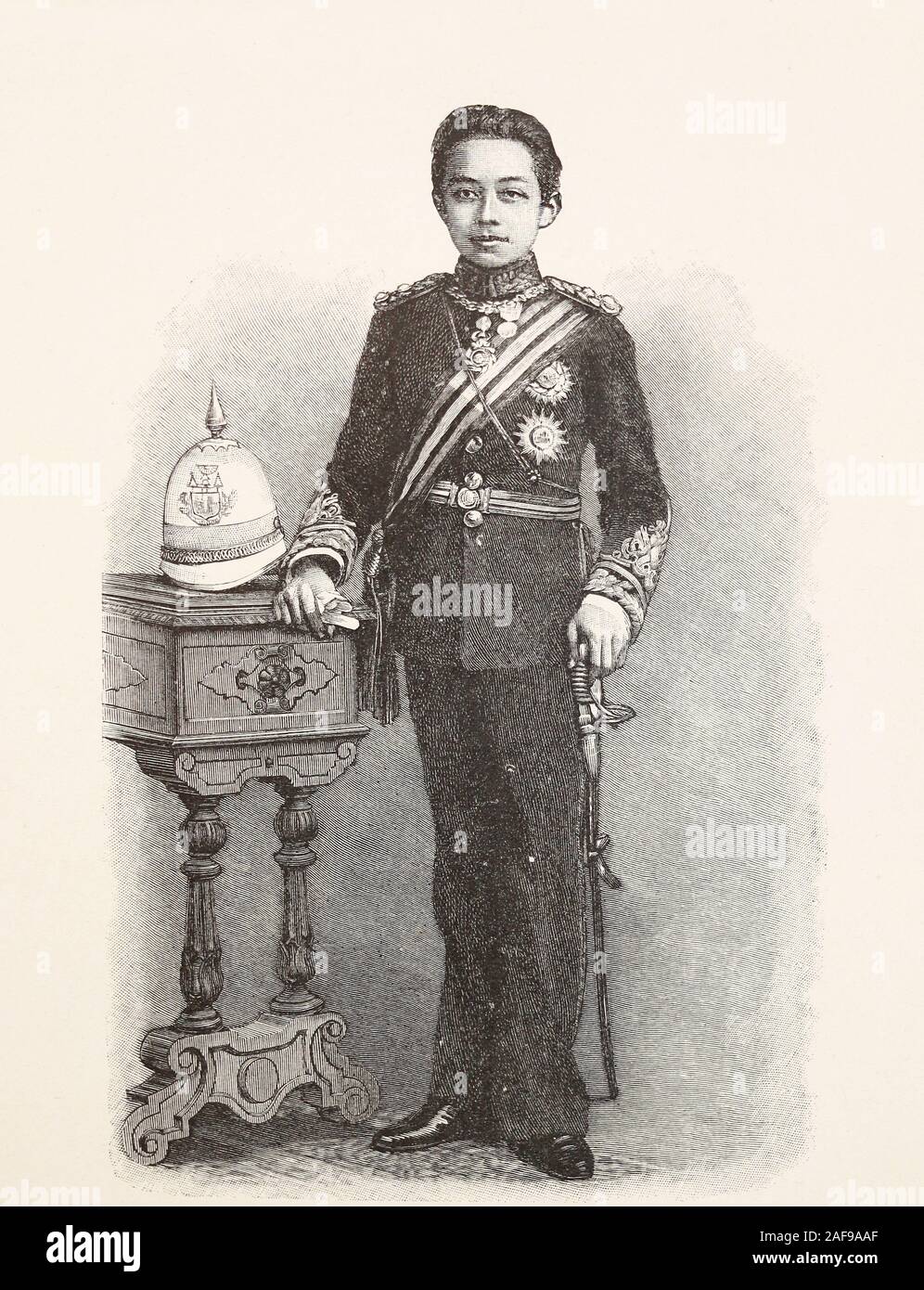 The second son of the King of Siam (Thailand) Rama V Chulalongkorn (Crown Prince). Engraving of the end of the 19th century. Stock Photohttps://www.alamy.com/image-license-details/?v=1https://www.alamy.com/the-second-son-of-the-king-of-siam-thailand-rama-v-chulalongkorn-crown-prince-engraving-of-the-end-of-the-19th-century-image336422535.html
The second son of the King of Siam (Thailand) Rama V Chulalongkorn (Crown Prince). Engraving of the end of the 19th century. Stock Photohttps://www.alamy.com/image-license-details/?v=1https://www.alamy.com/the-second-son-of-the-king-of-siam-thailand-rama-v-chulalongkorn-crown-prince-engraving-of-the-end-of-the-19th-century-image336422535.htmlRM2AF9AAF–The second son of the King of Siam (Thailand) Rama V Chulalongkorn (Crown Prince). Engraving of the end of the 19th century.
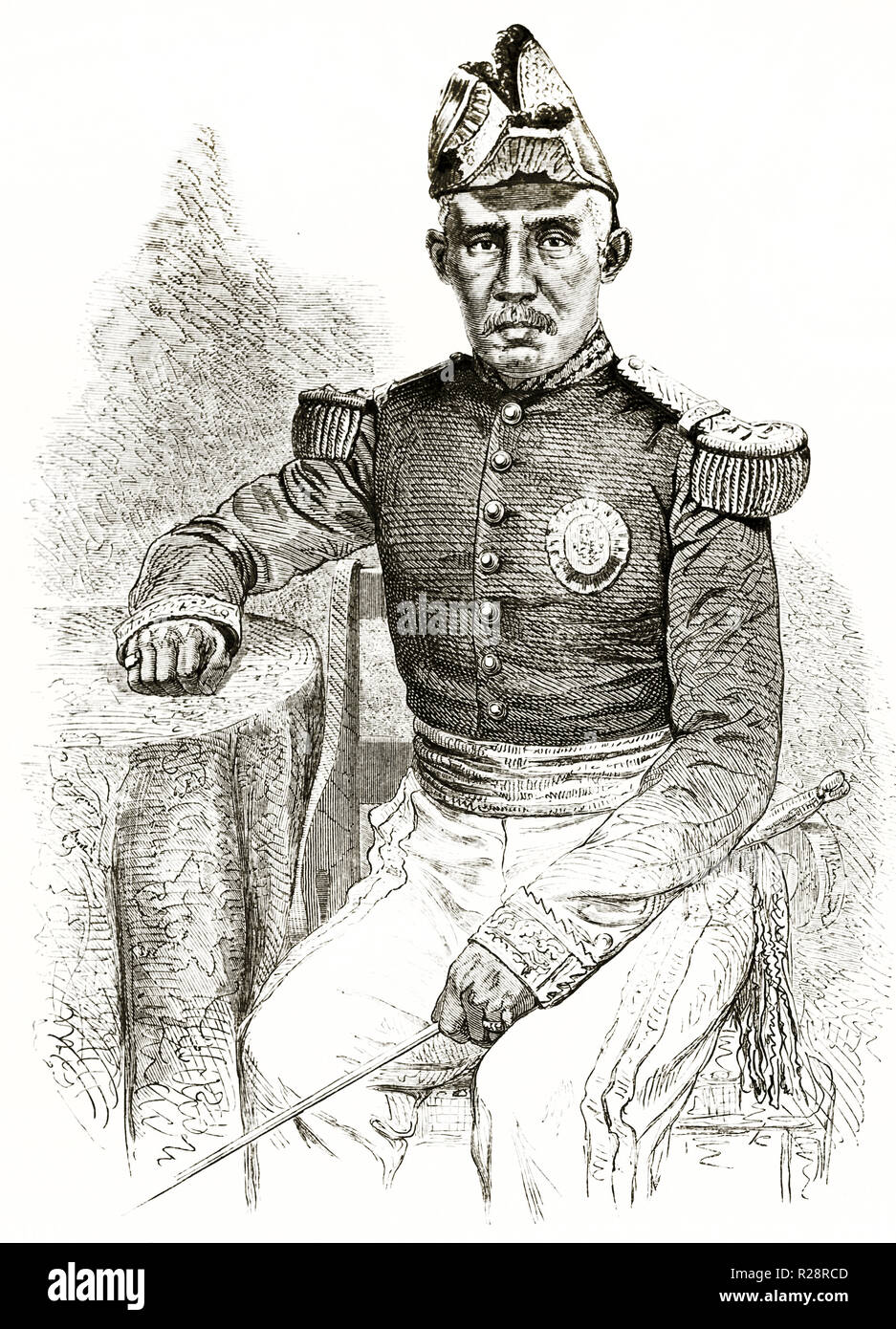 Old engraved portrait of the second King of Thailand. By Bocourt, publ. on le Tour du Monde, Paris, 1863 Stock Photohttps://www.alamy.com/image-license-details/?v=1https://www.alamy.com/old-engraved-portrait-of-the-second-king-of-thailand-by-bocourt-publ-on-le-tour-du-monde-paris-1863-image225158093.html
Old engraved portrait of the second King of Thailand. By Bocourt, publ. on le Tour du Monde, Paris, 1863 Stock Photohttps://www.alamy.com/image-license-details/?v=1https://www.alamy.com/old-engraved-portrait-of-the-second-king-of-thailand-by-bocourt-publ-on-le-tour-du-monde-paris-1863-image225158093.htmlRFR28RCD–Old engraved portrait of the second King of Thailand. By Bocourt, publ. on le Tour du Monde, Paris, 1863
 Portrait of Phrabat Somdet Phra Pinklao Chaoyuhua (1808-1866) Second king of Siam. Dated 19th Century; Stock Photohttps://www.alamy.com/image-license-details/?v=1https://www.alamy.com/stock-photo-portrait-of-phrabat-somdet-phra-pinklao-chaoyuhua-1808-1866-second-104177230.html
Portrait of Phrabat Somdet Phra Pinklao Chaoyuhua (1808-1866) Second king of Siam. Dated 19th Century; Stock Photohttps://www.alamy.com/image-license-details/?v=1https://www.alamy.com/stock-photo-portrait-of-phrabat-somdet-phra-pinklao-chaoyuhua-1808-1866-second-104177230.htmlRMG1DK3A–Portrait of Phrabat Somdet Phra Pinklao Chaoyuhua (1808-1866) Second king of Siam. Dated 19th Century;
 . English: Photograph of the Front Palace (Wang Na), the residence of the Second King Siam circa 1890. Now the Bangkok National Museum. circa 1890. Unknown 21 Front Palace circa.1890 Stock Photohttps://www.alamy.com/image-license-details/?v=1https://www.alamy.com/english-photograph-of-the-front-palace-wang-na-the-residence-of-the-second-king-siam-circa-1890-now-the-bangkok-national-museum-circa-1890-unknown-21-front-palace-circa1890-image208057686.html
. English: Photograph of the Front Palace (Wang Na), the residence of the Second King Siam circa 1890. Now the Bangkok National Museum. circa 1890. Unknown 21 Front Palace circa.1890 Stock Photohttps://www.alamy.com/image-license-details/?v=1https://www.alamy.com/english-photograph-of-the-front-palace-wang-na-the-residence-of-the-second-king-siam-circa-1890-now-the-bangkok-national-museum-circa-1890-unknown-21-front-palace-circa1890-image208057686.htmlRMP2DRKJ–. English: Photograph of the Front Palace (Wang Na), the residence of the Second King Siam circa 1890. Now the Bangkok National Museum. circa 1890. Unknown 21 Front Palace circa.1890
 The second king of siam on original old antique 1875. Stock Photohttps://www.alamy.com/image-license-details/?v=1https://www.alamy.com/the-second-king-of-siam-on-original-old-antique-1875-image369514811.html
The second king of siam on original old antique 1875. Stock Photohttps://www.alamy.com/image-license-details/?v=1https://www.alamy.com/the-second-king-of-siam-on-original-old-antique-1875-image369514811.htmlRF2CD4RWF–The second king of siam on original old antique 1875.
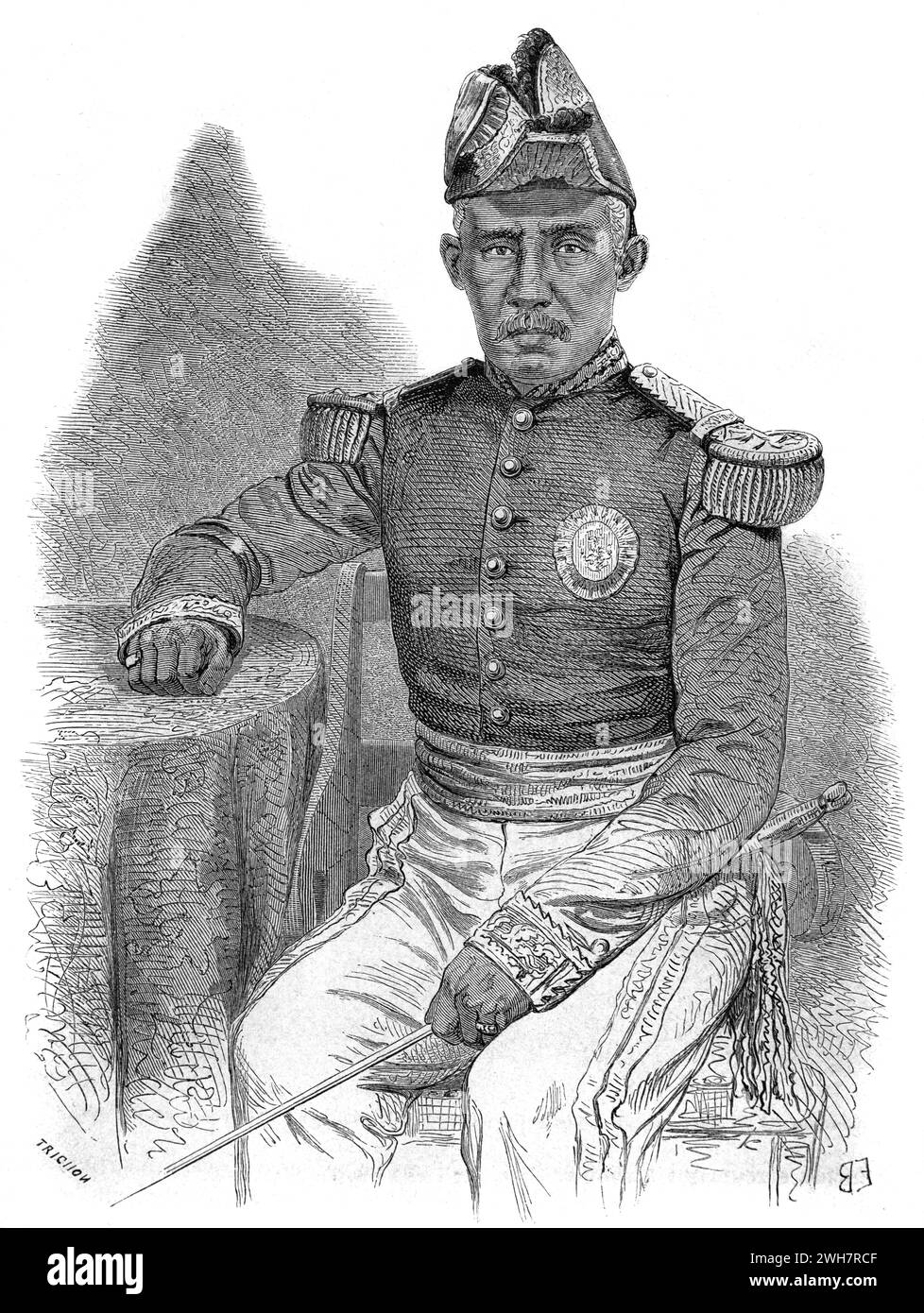 Second King of Siam Stock Photohttps://www.alamy.com/image-license-details/?v=1https://www.alamy.com/second-king-of-siam-image595773711.html
Second King of Siam Stock Photohttps://www.alamy.com/image-license-details/?v=1https://www.alamy.com/second-king-of-siam-image595773711.htmlRM2WH7RCF–Second King of Siam
 Siamese King Enroute To U.S. -- His Majesty King Prajadhipok of Siam, who with his lovely Queen, will arrive in America on April Twenty-Second. The Richest Potentate of his country will be the guest at the $5,000,000 Whitelaw Reid estate at purchase, N.Y., during his stay in America. March 24, 1931. (Photo by International Newsreel Photo). Stock Photohttps://www.alamy.com/image-license-details/?v=1https://www.alamy.com/siamese-king-enroute-to-us-his-majesty-king-prajadhipok-of-siam-who-with-his-lovely-queen-will-arrive-in-america-on-april-twenty-second-the-richest-potentate-of-his-country-will-be-the-guest-at-the-5000000-whitelaw-reid-estate-at-purchase-ny-during-his-stay-in-america-march-24-1931-photo-by-international-newsreel-photo-image466727794.html
Siamese King Enroute To U.S. -- His Majesty King Prajadhipok of Siam, who with his lovely Queen, will arrive in America on April Twenty-Second. The Richest Potentate of his country will be the guest at the $5,000,000 Whitelaw Reid estate at purchase, N.Y., during his stay in America. March 24, 1931. (Photo by International Newsreel Photo). Stock Photohttps://www.alamy.com/image-license-details/?v=1https://www.alamy.com/siamese-king-enroute-to-us-his-majesty-king-prajadhipok-of-siam-who-with-his-lovely-queen-will-arrive-in-america-on-april-twenty-second-the-richest-potentate-of-his-country-will-be-the-guest-at-the-5000000-whitelaw-reid-estate-at-purchase-ny-during-his-stay-in-america-march-24-1931-photo-by-international-newsreel-photo-image466727794.htmlRM2J3981P–Siamese King Enroute To U.S. -- His Majesty King Prajadhipok of Siam, who with his lovely Queen, will arrive in America on April Twenty-Second. The Richest Potentate of his country will be the guest at the $5,000,000 Whitelaw Reid estate at purchase, N.Y., during his stay in America. March 24, 1931. (Photo by International Newsreel Photo).
 First King of Siam John Thomson British, Scottish 1865 In Thailand the title First King was the designation of the reigning monarch; Second King was an honorific title given to a relative of the king. View more. First King of Siam. John Thomson (British, Edinburgh, Scotland 1837–1921 London). 1865. Albumen silver print from glass negative. Photographs Stock Photohttps://www.alamy.com/image-license-details/?v=1https://www.alamy.com/first-king-of-siam-john-thomson-british-scottish-1865-in-thailand-the-title-first-king-was-the-designation-of-the-reigning-monarch-second-king-was-an-honorific-title-given-to-a-relative-of-the-king-view-more-first-king-of-siam-john-thomson-british-edinburgh-scotland-18371921-london-1865-albumen-silver-print-from-glass-negative-photographs-image569501297.html
First King of Siam John Thomson British, Scottish 1865 In Thailand the title First King was the designation of the reigning monarch; Second King was an honorific title given to a relative of the king. View more. First King of Siam. John Thomson (British, Edinburgh, Scotland 1837–1921 London). 1865. Albumen silver print from glass negative. Photographs Stock Photohttps://www.alamy.com/image-license-details/?v=1https://www.alamy.com/first-king-of-siam-john-thomson-british-scottish-1865-in-thailand-the-title-first-king-was-the-designation-of-the-reigning-monarch-second-king-was-an-honorific-title-given-to-a-relative-of-the-king-view-more-first-king-of-siam-john-thomson-british-edinburgh-scotland-18371921-london-1865-albumen-silver-print-from-glass-negative-photographs-image569501297.htmlRM2T2F0M1–First King of Siam John Thomson British, Scottish 1865 In Thailand the title First King was the designation of the reigning monarch; Second King was an honorific title given to a relative of the king. View more. First King of Siam. John Thomson (British, Edinburgh, Scotland 1837–1921 London). 1865. Albumen silver print from glass negative. Photographs
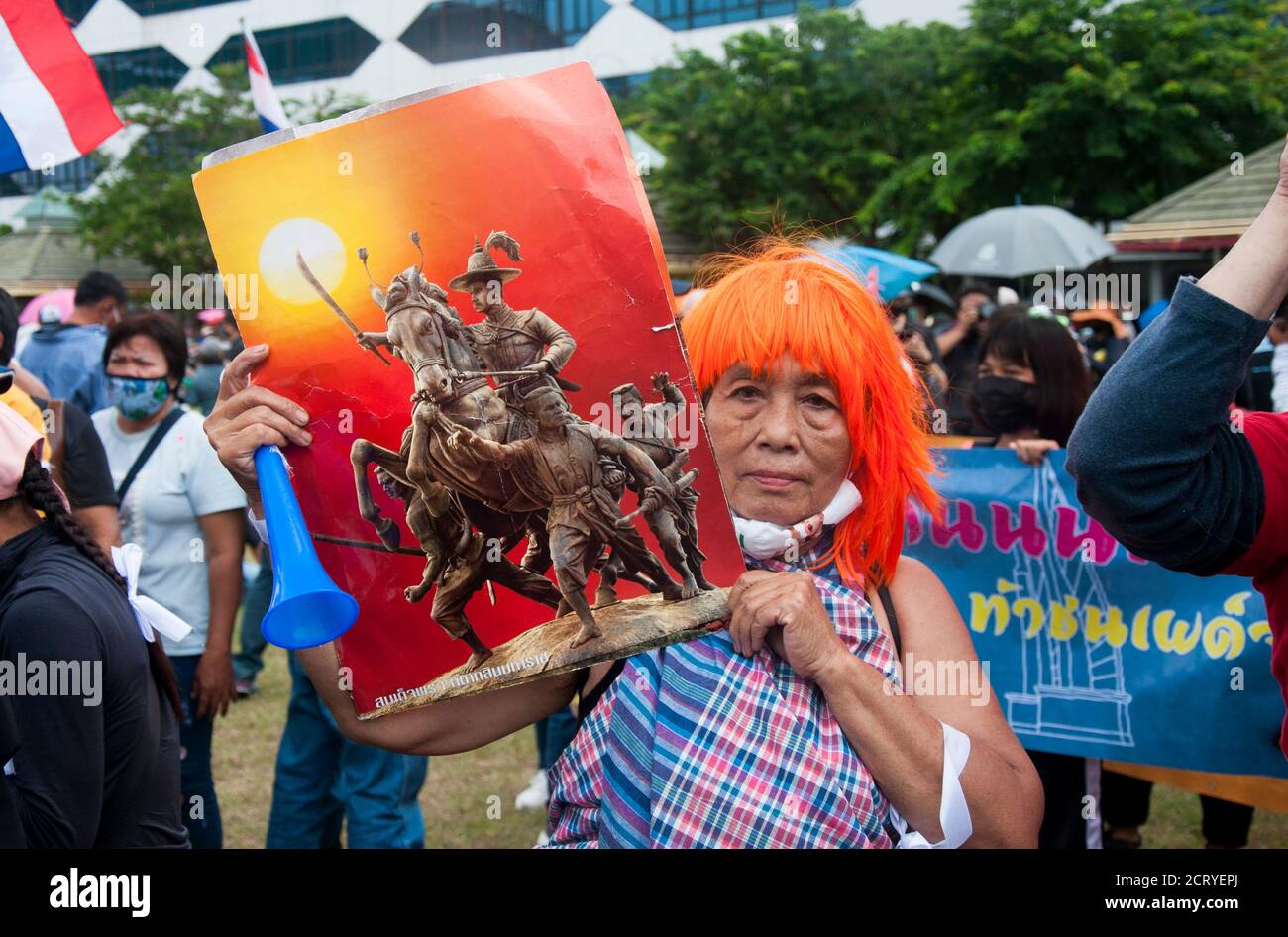 A protester holds a placard of 'Taksin the great'. The king of Thonburi kingdom who was a leader in the liberation of Siam from Burmese occupation after the Second Fall of Ayutthaya in 1767 during the demonstration at the Sanam Luang.Pro-democracy protesters converged at the historic royal heart of Bangkok to demand the resignation of the military-backed government and reforms of the monarchy, long considered a taboo subject in Thailand. The demonstrators gathered first at the Thammasat university campus on a college football field that was the scene of a massacre of left-wing students by pro- Stock Photohttps://www.alamy.com/image-license-details/?v=1https://www.alamy.com/a-protester-holds-a-placard-of-taksin-the-great-the-king-of-thonburi-kingdom-who-was-a-leader-in-the-liberation-of-siam-from-burmese-occupation-after-the-second-fall-of-ayutthaya-in-1767-during-the-demonstration-at-the-sanam-luangpro-democracy-protesters-converged-at-the-historic-royal-heart-of-bangkok-to-demand-the-resignation-of-the-military-backed-government-and-reforms-of-the-monarchy-long-considered-a-taboo-subject-in-thailand-the-demonstrators-gathered-first-at-the-thammasat-university-campus-on-a-college-football-field-that-was-the-scene-of-a-massacre-of-left-wing-students-by-pro-image376159130.html
A protester holds a placard of 'Taksin the great'. The king of Thonburi kingdom who was a leader in the liberation of Siam from Burmese occupation after the Second Fall of Ayutthaya in 1767 during the demonstration at the Sanam Luang.Pro-democracy protesters converged at the historic royal heart of Bangkok to demand the resignation of the military-backed government and reforms of the monarchy, long considered a taboo subject in Thailand. The demonstrators gathered first at the Thammasat university campus on a college football field that was the scene of a massacre of left-wing students by pro- Stock Photohttps://www.alamy.com/image-license-details/?v=1https://www.alamy.com/a-protester-holds-a-placard-of-taksin-the-great-the-king-of-thonburi-kingdom-who-was-a-leader-in-the-liberation-of-siam-from-burmese-occupation-after-the-second-fall-of-ayutthaya-in-1767-during-the-demonstration-at-the-sanam-luangpro-democracy-protesters-converged-at-the-historic-royal-heart-of-bangkok-to-demand-the-resignation-of-the-military-backed-government-and-reforms-of-the-monarchy-long-considered-a-taboo-subject-in-thailand-the-demonstrators-gathered-first-at-the-thammasat-university-campus-on-a-college-football-field-that-was-the-scene-of-a-massacre-of-left-wing-students-by-pro-image376159130.htmlRM2CRYEPJ–A protester holds a placard of 'Taksin the great'. The king of Thonburi kingdom who was a leader in the liberation of Siam from Burmese occupation after the Second Fall of Ayutthaya in 1767 during the demonstration at the Sanam Luang.Pro-democracy protesters converged at the historic royal heart of Bangkok to demand the resignation of the military-backed government and reforms of the monarchy, long considered a taboo subject in Thailand. The demonstrators gathered first at the Thammasat university campus on a college football field that was the scene of a massacre of left-wing students by pro-
 Bangkok, Thailand. 14th Aug, 2001. A protester holds a placard of ''Taksin the great''. The king of Thonburi kingdom who was a leader in the liberation of Siam from Burmese occupation after the Second Fall of Ayutthaya in 1767 during the demonstration at the Sanam Luang.Pro-democracy protesters converged at the historic royal heart of Bangkok to demand the resignation of the military-backed government and reforms of the monarchy, long considered a taboo subject in Thailand. The demonstrators gathered first at the Thammasat university campus on a college football field that was the scene of a Stock Photohttps://www.alamy.com/image-license-details/?v=1https://www.alamy.com/bangkok-thailand-14th-aug-2001-a-protester-holds-a-placard-of-taksin-the-great-the-king-of-thonburi-kingdom-who-was-a-leader-in-the-liberation-of-siam-from-burmese-occupation-after-the-second-fall-of-ayutthaya-in-1767-during-the-demonstration-at-the-sanam-luangpro-democracy-protesters-converged-at-the-historic-royal-heart-of-bangkok-to-demand-the-resignation-of-the-military-backed-government-and-reforms-of-the-monarchy-long-considered-a-taboo-subject-in-thailand-the-demonstrators-gathered-first-at-the-thammasat-university-campus-on-a-college-football-field-that-was-the-scene-of-a-image376164689.html
Bangkok, Thailand. 14th Aug, 2001. A protester holds a placard of ''Taksin the great''. The king of Thonburi kingdom who was a leader in the liberation of Siam from Burmese occupation after the Second Fall of Ayutthaya in 1767 during the demonstration at the Sanam Luang.Pro-democracy protesters converged at the historic royal heart of Bangkok to demand the resignation of the military-backed government and reforms of the monarchy, long considered a taboo subject in Thailand. The demonstrators gathered first at the Thammasat university campus on a college football field that was the scene of a Stock Photohttps://www.alamy.com/image-license-details/?v=1https://www.alamy.com/bangkok-thailand-14th-aug-2001-a-protester-holds-a-placard-of-taksin-the-great-the-king-of-thonburi-kingdom-who-was-a-leader-in-the-liberation-of-siam-from-burmese-occupation-after-the-second-fall-of-ayutthaya-in-1767-during-the-demonstration-at-the-sanam-luangpro-democracy-protesters-converged-at-the-historic-royal-heart-of-bangkok-to-demand-the-resignation-of-the-military-backed-government-and-reforms-of-the-monarchy-long-considered-a-taboo-subject-in-thailand-the-demonstrators-gathered-first-at-the-thammasat-university-campus-on-a-college-football-field-that-was-the-scene-of-a-image376164689.htmlRM2CRYNW5–Bangkok, Thailand. 14th Aug, 2001. A protester holds a placard of ''Taksin the great''. The king of Thonburi kingdom who was a leader in the liberation of Siam from Burmese occupation after the Second Fall of Ayutthaya in 1767 during the demonstration at the Sanam Luang.Pro-democracy protesters converged at the historic royal heart of Bangkok to demand the resignation of the military-backed government and reforms of the monarchy, long considered a taboo subject in Thailand. The demonstrators gathered first at the Thammasat university campus on a college football field that was the scene of a
 BANGKOK, THAILAND - SEPTEMBER 04, 2017: King Rama II monument, It's located in front of Wat Arun Temple (Temple of Dawn). He was the second monarch of Stock Photohttps://www.alamy.com/image-license-details/?v=1https://www.alamy.com/bangkok-thailand-september-04-2017-king-rama-ii-monument-its-located-in-front-of-wat-arun-temple-temple-of-dawn-he-was-the-second-monarch-of-image182011054.html
BANGKOK, THAILAND - SEPTEMBER 04, 2017: King Rama II monument, It's located in front of Wat Arun Temple (Temple of Dawn). He was the second monarch of Stock Photohttps://www.alamy.com/image-license-details/?v=1https://www.alamy.com/bangkok-thailand-september-04-2017-king-rama-ii-monument-its-located-in-front-of-wat-arun-temple-temple-of-dawn-he-was-the-second-monarch-of-image182011054.htmlRFMG38XP–BANGKOK, THAILAND - SEPTEMBER 04, 2017: King Rama II monument, It's located in front of Wat Arun Temple (Temple of Dawn). He was the second monarch of
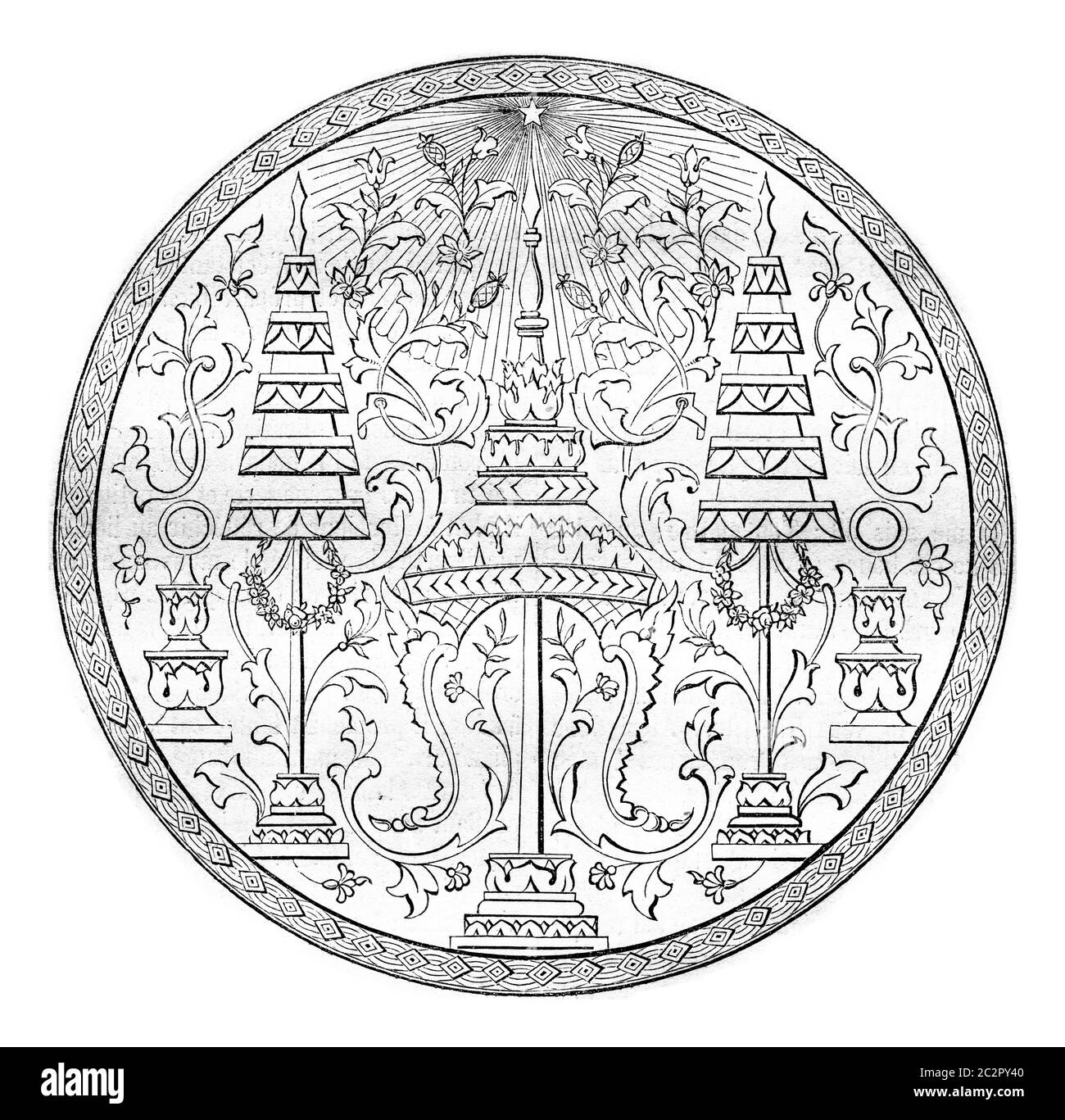 Seal of the second king of Siam, vintage engraved illustration. Magasin Pittoresque 1857. Stock Photohttps://www.alamy.com/image-license-details/?v=1https://www.alamy.com/seal-of-the-second-king-of-siam-vintage-engraved-illustration-magasin-pittoresque-1857-image363151264.html
Seal of the second king of Siam, vintage engraved illustration. Magasin Pittoresque 1857. Stock Photohttps://www.alamy.com/image-license-details/?v=1https://www.alamy.com/seal-of-the-second-king-of-siam-vintage-engraved-illustration-magasin-pittoresque-1857-image363151264.htmlRF2C2PY40–Seal of the second king of Siam, vintage engraved illustration. Magasin Pittoresque 1857.
 BANGKOK, THAILAND - SEPTEMBER 04, 2017: King Rama II monument, It's located in front of Wat Arun Temple (Temple of Dawn). He was the second monarch of Stock Photohttps://www.alamy.com/image-license-details/?v=1https://www.alamy.com/bangkok-thailand-september-04-2017-king-rama-ii-monument-its-located-in-front-of-wat-arun-temple-temple-of-dawn-he-was-the-second-monarch-of-image182011053.html
BANGKOK, THAILAND - SEPTEMBER 04, 2017: King Rama II monument, It's located in front of Wat Arun Temple (Temple of Dawn). He was the second monarch of Stock Photohttps://www.alamy.com/image-license-details/?v=1https://www.alamy.com/bangkok-thailand-september-04-2017-king-rama-ii-monument-its-located-in-front-of-wat-arun-temple-temple-of-dawn-he-was-the-second-monarch-of-image182011053.htmlRFMG38XN–BANGKOK, THAILAND - SEPTEMBER 04, 2017: King Rama II monument, It's located in front of Wat Arun Temple (Temple of Dawn). He was the second monarch of
![Our young folks [serial] . joys no special privilege except that of approachingthe real king on two feet instead of creeping on all-fours. He does noteven inherit the kingdom on the death of the supreme king. He is notmuch more than a noble of the very highest rank. Social rank in Siam is indicated by numbers, ranging all the way fromfive for the meanest slave to one hundred thousand for the second king.The number for the supreme king cannot be expressed in figures; it isinfinite ! Connected with the royal household is a guard of several hundred Ama-zons, or female soldiers, trained and office Stock Photo Our young folks [serial] . joys no special privilege except that of approachingthe real king on two feet instead of creeping on all-fours. He does noteven inherit the kingdom on the death of the supreme king. He is notmuch more than a noble of the very highest rank. Social rank in Siam is indicated by numbers, ranging all the way fromfive for the meanest slave to one hundred thousand for the second king.The number for the supreme king cannot be expressed in figures; it isinfinite ! Connected with the royal household is a guard of several hundred Ama-zons, or female soldiers, trained and office Stock Photo](https://c8.alamy.com/comp/2AJM89C/our-young-folks-serial-joys-no-special-privilege-except-that-of-approachingthe-real-king-on-two-feet-instead-of-creeping-on-all-fours-he-does-noteven-inherit-the-kingdom-on-the-death-of-the-supreme-king-he-is-notmuch-more-than-a-noble-of-the-very-highest-rank-social-rank-in-siam-is-indicated-by-numbers-ranging-all-the-way-fromfive-for-the-meanest-slave-to-one-hundred-thousand-for-the-second-kingthe-number-for-the-supreme-king-cannot-be-expressed-in-figures-it-isinfinite-!-connected-with-the-royal-household-is-a-guard-of-several-hundred-ama-zons-or-female-soldiers-trained-and-office-2AJM89C.jpg) Our young folks [serial] . joys no special privilege except that of approachingthe real king on two feet instead of creeping on all-fours. He does noteven inherit the kingdom on the death of the supreme king. He is notmuch more than a noble of the very highest rank. Social rank in Siam is indicated by numbers, ranging all the way fromfive for the meanest slave to one hundred thousand for the second king.The number for the supreme king cannot be expressed in figures; it isinfinite ! Connected with the royal household is a guard of several hundred Ama-zons, or female soldiers, trained and office Stock Photohttps://www.alamy.com/image-license-details/?v=1https://www.alamy.com/our-young-folks-serial-joys-no-special-privilege-except-that-of-approachingthe-real-king-on-two-feet-instead-of-creeping-on-all-fours-he-does-noteven-inherit-the-kingdom-on-the-death-of-the-supreme-king-he-is-notmuch-more-than-a-noble-of-the-very-highest-rank-social-rank-in-siam-is-indicated-by-numbers-ranging-all-the-way-fromfive-for-the-meanest-slave-to-one-hundred-thousand-for-the-second-kingthe-number-for-the-supreme-king-cannot-be-expressed-in-figures-it-isinfinite-!-connected-with-the-royal-household-is-a-guard-of-several-hundred-ama-zons-or-female-soldiers-trained-and-office-image338506376.html
Our young folks [serial] . joys no special privilege except that of approachingthe real king on two feet instead of creeping on all-fours. He does noteven inherit the kingdom on the death of the supreme king. He is notmuch more than a noble of the very highest rank. Social rank in Siam is indicated by numbers, ranging all the way fromfive for the meanest slave to one hundred thousand for the second king.The number for the supreme king cannot be expressed in figures; it isinfinite ! Connected with the royal household is a guard of several hundred Ama-zons, or female soldiers, trained and office Stock Photohttps://www.alamy.com/image-license-details/?v=1https://www.alamy.com/our-young-folks-serial-joys-no-special-privilege-except-that-of-approachingthe-real-king-on-two-feet-instead-of-creeping-on-all-fours-he-does-noteven-inherit-the-kingdom-on-the-death-of-the-supreme-king-he-is-notmuch-more-than-a-noble-of-the-very-highest-rank-social-rank-in-siam-is-indicated-by-numbers-ranging-all-the-way-fromfive-for-the-meanest-slave-to-one-hundred-thousand-for-the-second-kingthe-number-for-the-supreme-king-cannot-be-expressed-in-figures-it-isinfinite-!-connected-with-the-royal-household-is-a-guard-of-several-hundred-ama-zons-or-female-soldiers-trained-and-office-image338506376.htmlRM2AJM89C–Our young folks [serial] . joys no special privilege except that of approachingthe real king on two feet instead of creeping on all-fours. He does noteven inherit the kingdom on the death of the supreme king. He is notmuch more than a noble of the very highest rank. Social rank in Siam is indicated by numbers, ranging all the way fromfive for the meanest slave to one hundred thousand for the second king.The number for the supreme king cannot be expressed in figures; it isinfinite ! Connected with the royal household is a guard of several hundred Ama-zons, or female soldiers, trained and office
 Old Bangkok July-2000 (Slides Conversions) The Ayutthaya historical park covers the ruins of the old city of Ayutthaya Thailand Stock Photohttps://www.alamy.com/image-license-details/?v=1https://www.alamy.com/stock-photo-old-bangkok-july-2000-slides-conversions-the-ayutthaya-historical-50973470.html
Old Bangkok July-2000 (Slides Conversions) The Ayutthaya historical park covers the ruins of the old city of Ayutthaya Thailand Stock Photohttps://www.alamy.com/image-license-details/?v=1https://www.alamy.com/stock-photo-old-bangkok-july-2000-slides-conversions-the-ayutthaya-historical-50973470.htmlRMCXX152–Old Bangkok July-2000 (Slides Conversions) The Ayutthaya historical park covers the ruins of the old city of Ayutthaya Thailand
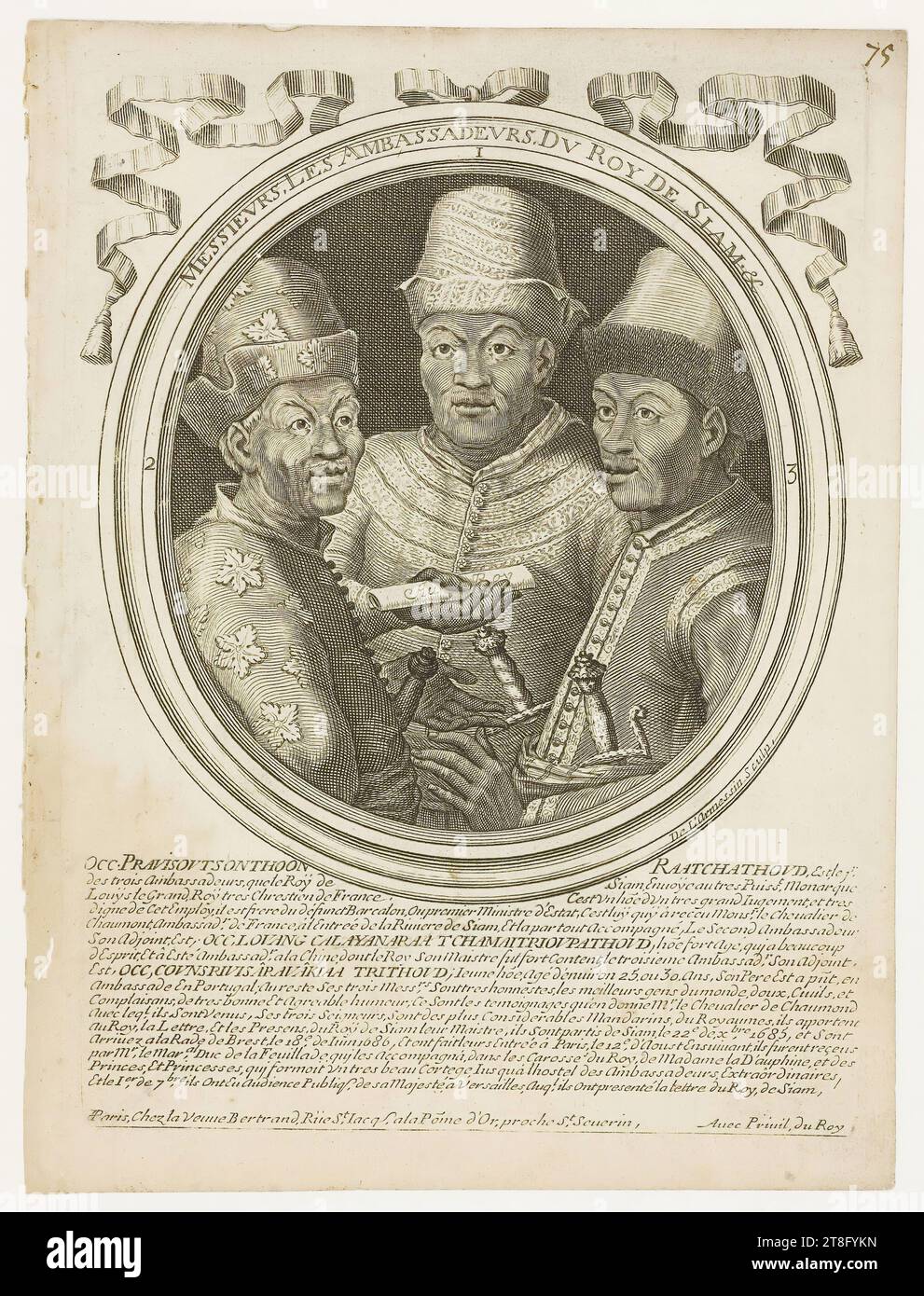 MESSIEVRS THE DV ROY AMBASSADEVRS OF SIAM &. De L'Armessin Sculp. OCC. PRAVISOVTSONTHOON RAATCHATHOVD, Is the j.r, of the three ambassadors, that the King of Siam, another powerful monarch, Louÿs the Great, Kings very Christian of France, he is a man of very great judgment and very, worthy of this Employ, he is brother of the deceased Barcalon, or Prime Minister of State, it is he who is reccu mons. the cheualier de, Chaumont, ambassad.r of France at Entrance of the River of Siam, And everywhere Accompanied by the Second Ambassador, his deputy is, OCC. LOVANG CALAYANARAA TCHAMAITRIOVPATHOVD Stock Photohttps://www.alamy.com/image-license-details/?v=1https://www.alamy.com/messievrs-the-dv-roy-ambassadevrs-of-siam-de-larmessin-sculp-occ-pravisovtsonthoon-raatchathovd-is-the-jr-of-the-three-ambassadors-that-the-king-of-siam-another-powerful-monarch-lous-the-great-kings-very-christian-of-france-he-is-a-man-of-very-great-judgment-and-very-worthy-of-this-employ-he-is-brother-of-the-deceased-barcalon-or-prime-minister-of-state-it-is-he-who-is-reccu-mons-the-cheualier-de-chaumont-ambassadr-of-france-at-entrance-of-the-river-of-siam-and-everywhere-accompanied-by-the-second-ambassador-his-deputy-is-occ-lovang-calayanaraa-tchamaitriovpathovd-image573210393.html
MESSIEVRS THE DV ROY AMBASSADEVRS OF SIAM &. De L'Armessin Sculp. OCC. PRAVISOVTSONTHOON RAATCHATHOVD, Is the j.r, of the three ambassadors, that the King of Siam, another powerful monarch, Louÿs the Great, Kings very Christian of France, he is a man of very great judgment and very, worthy of this Employ, he is brother of the deceased Barcalon, or Prime Minister of State, it is he who is reccu mons. the cheualier de, Chaumont, ambassad.r of France at Entrance of the River of Siam, And everywhere Accompanied by the Second Ambassador, his deputy is, OCC. LOVANG CALAYANARAA TCHAMAITRIOVPATHOVD Stock Photohttps://www.alamy.com/image-license-details/?v=1https://www.alamy.com/messievrs-the-dv-roy-ambassadevrs-of-siam-de-larmessin-sculp-occ-pravisovtsonthoon-raatchathovd-is-the-jr-of-the-three-ambassadors-that-the-king-of-siam-another-powerful-monarch-lous-the-great-kings-very-christian-of-france-he-is-a-man-of-very-great-judgment-and-very-worthy-of-this-employ-he-is-brother-of-the-deceased-barcalon-or-prime-minister-of-state-it-is-he-who-is-reccu-mons-the-cheualier-de-chaumont-ambassadr-of-france-at-entrance-of-the-river-of-siam-and-everywhere-accompanied-by-the-second-ambassador-his-deputy-is-occ-lovang-calayanaraa-tchamaitriovpathovd-image573210393.htmlRM2T8FYKN–MESSIEVRS THE DV ROY AMBASSADEVRS OF SIAM &. De L'Armessin Sculp. OCC. PRAVISOVTSONTHOON RAATCHATHOVD, Is the j.r, of the three ambassadors, that the King of Siam, another powerful monarch, Louÿs the Great, Kings very Christian of France, he is a man of very great judgment and very, worthy of this Employ, he is brother of the deceased Barcalon, or Prime Minister of State, it is he who is reccu mons. the cheualier de, Chaumont, ambassad.r of France at Entrance of the River of Siam, And everywhere Accompanied by the Second Ambassador, his deputy is, OCC. LOVANG CALAYANARAA TCHAMAITRIOVPATHOVD
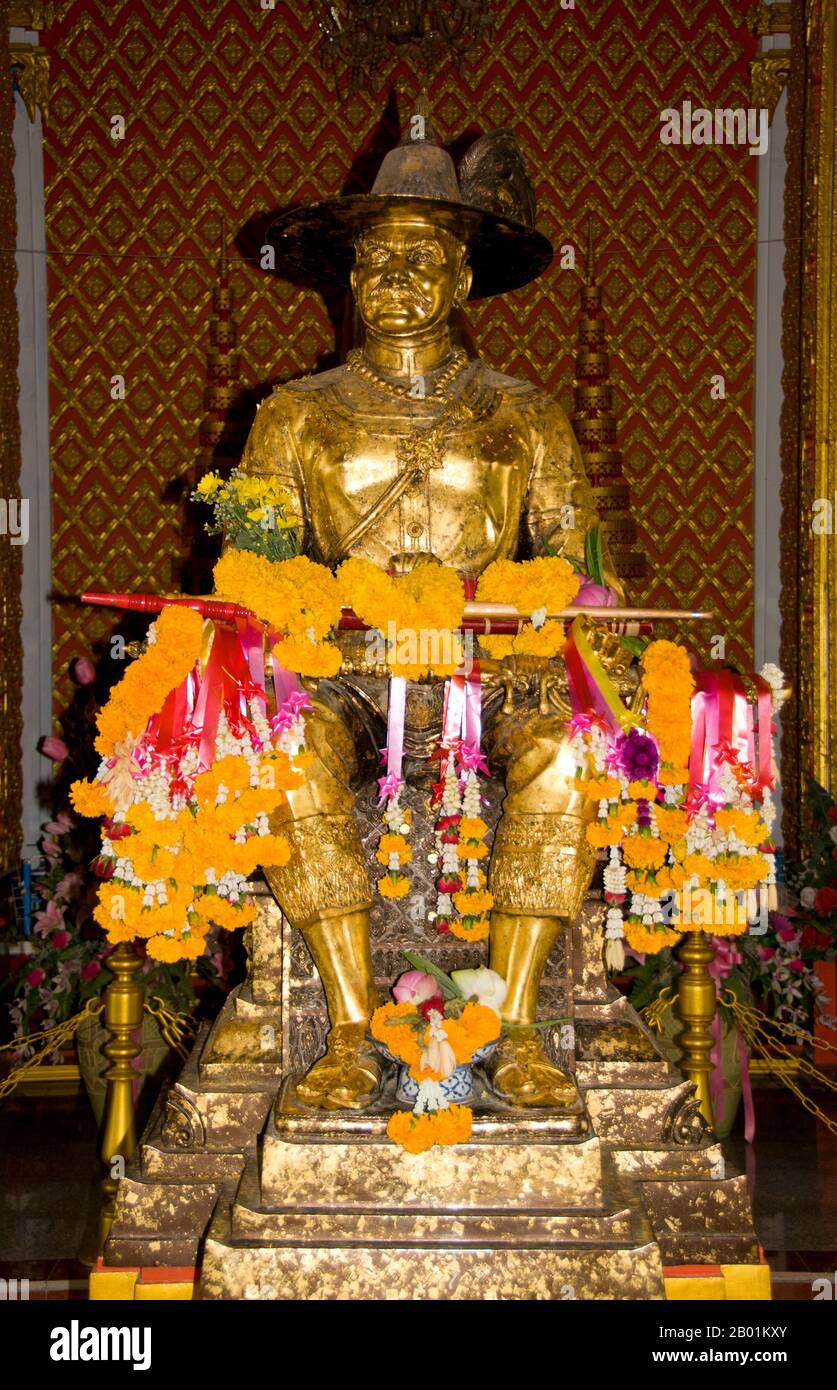 Thailand: King Taksin shrine, Rayong, Rayong Province. King Taksin (Somdet Phra Chao Taksin Maharat; 17 April 1734 - 7 April 1782) was the only King of the Thonburi Kingdom. He is greatly revered by the Thai people for his leadership in liberating Siam from Burmese occupation after the Second Fall of Ayutthaya in 1767, and the subsequent unification of Siam after it fell under various warlords. King Taksin established Thonburi as his new capital, since Ayutthaya had been almost completely destroyed by the Burmese. His reign was characterised by numerous wars, fought to repel the Burmese. Stock Photohttps://www.alamy.com/image-license-details/?v=1https://www.alamy.com/thailand-king-taksin-shrine-rayong-rayong-province-king-taksin-somdet-phra-chao-taksin-maharat-17-april-1734-7-april-1782-was-the-only-king-of-the-thonburi-kingdom-he-is-greatly-revered-by-the-thai-people-for-his-leadership-in-liberating-siam-from-burmese-occupation-after-the-second-fall-of-ayutthaya-in-1767-and-the-subsequent-unification-of-siam-after-it-fell-under-various-warlords-king-taksin-established-thonburi-as-his-new-capital-since-ayutthaya-had-been-almost-completely-destroyed-by-the-burmese-his-reign-was-characterised-by-numerous-wars-fought-to-repel-the-burmese-image344244963.html
Thailand: King Taksin shrine, Rayong, Rayong Province. King Taksin (Somdet Phra Chao Taksin Maharat; 17 April 1734 - 7 April 1782) was the only King of the Thonburi Kingdom. He is greatly revered by the Thai people for his leadership in liberating Siam from Burmese occupation after the Second Fall of Ayutthaya in 1767, and the subsequent unification of Siam after it fell under various warlords. King Taksin established Thonburi as his new capital, since Ayutthaya had been almost completely destroyed by the Burmese. His reign was characterised by numerous wars, fought to repel the Burmese. Stock Photohttps://www.alamy.com/image-license-details/?v=1https://www.alamy.com/thailand-king-taksin-shrine-rayong-rayong-province-king-taksin-somdet-phra-chao-taksin-maharat-17-april-1734-7-april-1782-was-the-only-king-of-the-thonburi-kingdom-he-is-greatly-revered-by-the-thai-people-for-his-leadership-in-liberating-siam-from-burmese-occupation-after-the-second-fall-of-ayutthaya-in-1767-and-the-subsequent-unification-of-siam-after-it-fell-under-various-warlords-king-taksin-established-thonburi-as-his-new-capital-since-ayutthaya-had-been-almost-completely-destroyed-by-the-burmese-his-reign-was-characterised-by-numerous-wars-fought-to-repel-the-burmese-image344244963.htmlRM2B01KXY–Thailand: King Taksin shrine, Rayong, Rayong Province. King Taksin (Somdet Phra Chao Taksin Maharat; 17 April 1734 - 7 April 1782) was the only King of the Thonburi Kingdom. He is greatly revered by the Thai people for his leadership in liberating Siam from Burmese occupation after the Second Fall of Ayutthaya in 1767, and the subsequent unification of Siam after it fell under various warlords. King Taksin established Thonburi as his new capital, since Ayutthaya had been almost completely destroyed by the Burmese. His reign was characterised by numerous wars, fought to repel the Burmese.
 Siam postage Early Capital PENANG cencelled on both second Issue 1 Atts provisional on 12 Atts Type 1 of king rama V stamp. Stock Photohttps://www.alamy.com/image-license-details/?v=1https://www.alamy.com/siam-postage-early-capital-penang-cencelled-on-both-second-issue-1-atts-provisional-on-12-atts-type-1-of-king-rama-v-stamp-image344016088.html
Siam postage Early Capital PENANG cencelled on both second Issue 1 Atts provisional on 12 Atts Type 1 of king rama V stamp. Stock Photohttps://www.alamy.com/image-license-details/?v=1https://www.alamy.com/siam-postage-early-capital-penang-cencelled-on-both-second-issue-1-atts-provisional-on-12-atts-type-1-of-king-rama-v-stamp-image344016088.htmlRF2AYK80T–Siam postage Early Capital PENANG cencelled on both second Issue 1 Atts provisional on 12 Atts Type 1 of king rama V stamp.
 Old Bangkok July-2000 (Slides Conversions) The Ayutthaya historical park covers the ruins of the old city of Ayutthaya Thailand Stock Photohttps://www.alamy.com/image-license-details/?v=1https://www.alamy.com/stock-photo-old-bangkok-july-2000-slides-conversions-the-ayutthaya-historical-50973567.html
Old Bangkok July-2000 (Slides Conversions) The Ayutthaya historical park covers the ruins of the old city of Ayutthaya Thailand Stock Photohttps://www.alamy.com/image-license-details/?v=1https://www.alamy.com/stock-photo-old-bangkok-july-2000-slides-conversions-the-ayutthaya-historical-50973567.htmlRMCXX18F–Old Bangkok July-2000 (Slides Conversions) The Ayutthaya historical park covers the ruins of the old city of Ayutthaya Thailand
 Thailand: King Taksin shrine, Rayong, Rayong Province. King Taksin (Somdet Phra Chao Taksin Maharat; 17 April 1734 - 7 April 1782) was the only King of the Thonburi Kingdom. He is greatly revered by the Thai people for his leadership in liberating Siam from Burmese occupation after the Second Fall of Ayutthaya in 1767, and the subsequent unification of Siam after it fell under various warlords. King Taksin established Thonburi as his new capital, since Ayutthaya had been almost completely destroyed by the Burmese. His reign was characterised by numerous wars, fought to repel the Burmese. Stock Photohttps://www.alamy.com/image-license-details/?v=1https://www.alamy.com/thailand-king-taksin-shrine-rayong-rayong-province-king-taksin-somdet-phra-chao-taksin-maharat-17-april-1734-7-april-1782-was-the-only-king-of-the-thonburi-kingdom-he-is-greatly-revered-by-the-thai-people-for-his-leadership-in-liberating-siam-from-burmese-occupation-after-the-second-fall-of-ayutthaya-in-1767-and-the-subsequent-unification-of-siam-after-it-fell-under-various-warlords-king-taksin-established-thonburi-as-his-new-capital-since-ayutthaya-had-been-almost-completely-destroyed-by-the-burmese-his-reign-was-characterised-by-numerous-wars-fought-to-repel-the-burmese-image344244964.html
Thailand: King Taksin shrine, Rayong, Rayong Province. King Taksin (Somdet Phra Chao Taksin Maharat; 17 April 1734 - 7 April 1782) was the only King of the Thonburi Kingdom. He is greatly revered by the Thai people for his leadership in liberating Siam from Burmese occupation after the Second Fall of Ayutthaya in 1767, and the subsequent unification of Siam after it fell under various warlords. King Taksin established Thonburi as his new capital, since Ayutthaya had been almost completely destroyed by the Burmese. His reign was characterised by numerous wars, fought to repel the Burmese. Stock Photohttps://www.alamy.com/image-license-details/?v=1https://www.alamy.com/thailand-king-taksin-shrine-rayong-rayong-province-king-taksin-somdet-phra-chao-taksin-maharat-17-april-1734-7-april-1782-was-the-only-king-of-the-thonburi-kingdom-he-is-greatly-revered-by-the-thai-people-for-his-leadership-in-liberating-siam-from-burmese-occupation-after-the-second-fall-of-ayutthaya-in-1767-and-the-subsequent-unification-of-siam-after-it-fell-under-various-warlords-king-taksin-established-thonburi-as-his-new-capital-since-ayutthaya-had-been-almost-completely-destroyed-by-the-burmese-his-reign-was-characterised-by-numerous-wars-fought-to-repel-the-burmese-image344244964.htmlRM2B01KY0–Thailand: King Taksin shrine, Rayong, Rayong Province. King Taksin (Somdet Phra Chao Taksin Maharat; 17 April 1734 - 7 April 1782) was the only King of the Thonburi Kingdom. He is greatly revered by the Thai people for his leadership in liberating Siam from Burmese occupation after the Second Fall of Ayutthaya in 1767, and the subsequent unification of Siam after it fell under various warlords. King Taksin established Thonburi as his new capital, since Ayutthaya had been almost completely destroyed by the Burmese. His reign was characterised by numerous wars, fought to repel the Burmese.
 Siam postage Early native single ring type PSR-02A, 'SUPAN ' tied on third Issue 3 Atts king rama V stamp. Stock Photohttps://www.alamy.com/image-license-details/?v=1https://www.alamy.com/siam-postage-early-native-single-ring-type-psr-02a-supan-tied-on-third-issue-3-atts-king-rama-v-stamp-image344016096.html
Siam postage Early native single ring type PSR-02A, 'SUPAN ' tied on third Issue 3 Atts king rama V stamp. Stock Photohttps://www.alamy.com/image-license-details/?v=1https://www.alamy.com/siam-postage-early-native-single-ring-type-psr-02a-supan-tied-on-third-issue-3-atts-king-rama-v-stamp-image344016096.htmlRF2AYK814–Siam postage Early native single ring type PSR-02A, 'SUPAN ' tied on third Issue 3 Atts king rama V stamp.
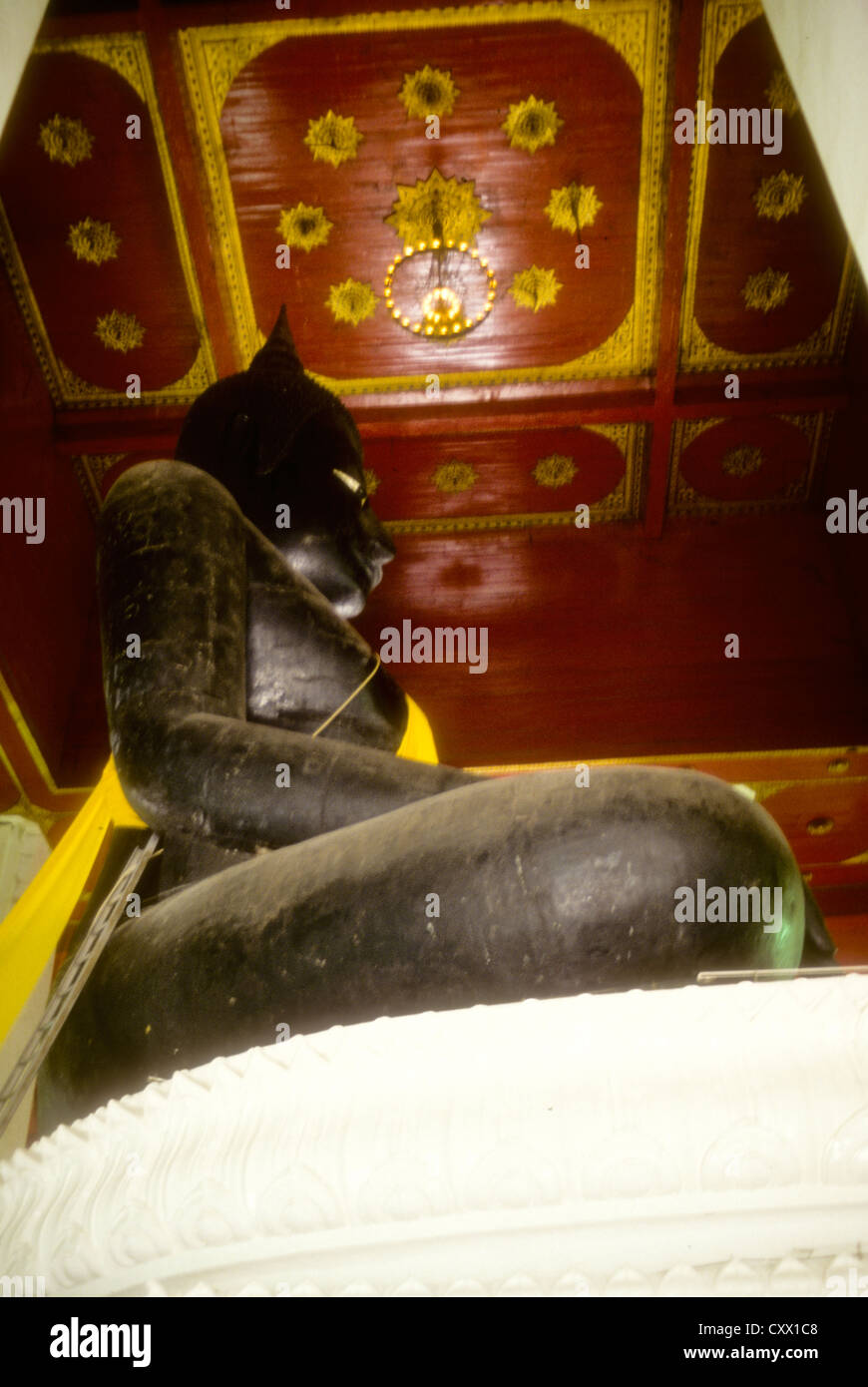 Old Bangkok July-2000 (Digital Slide Conversion) Big Buddha in Wat Phanan Choeng Ayutthaya nr Bangkok,Thailand Stock Photohttps://www.alamy.com/image-license-details/?v=1https://www.alamy.com/stock-photo-old-bangkok-july-2000-digital-slide-conversion-big-buddha-in-wat-phanan-50973672.html
Old Bangkok July-2000 (Digital Slide Conversion) Big Buddha in Wat Phanan Choeng Ayutthaya nr Bangkok,Thailand Stock Photohttps://www.alamy.com/image-license-details/?v=1https://www.alamy.com/stock-photo-old-bangkok-july-2000-digital-slide-conversion-big-buddha-in-wat-phanan-50973672.htmlRMCXX1C8–Old Bangkok July-2000 (Digital Slide Conversion) Big Buddha in Wat Phanan Choeng Ayutthaya nr Bangkok,Thailand
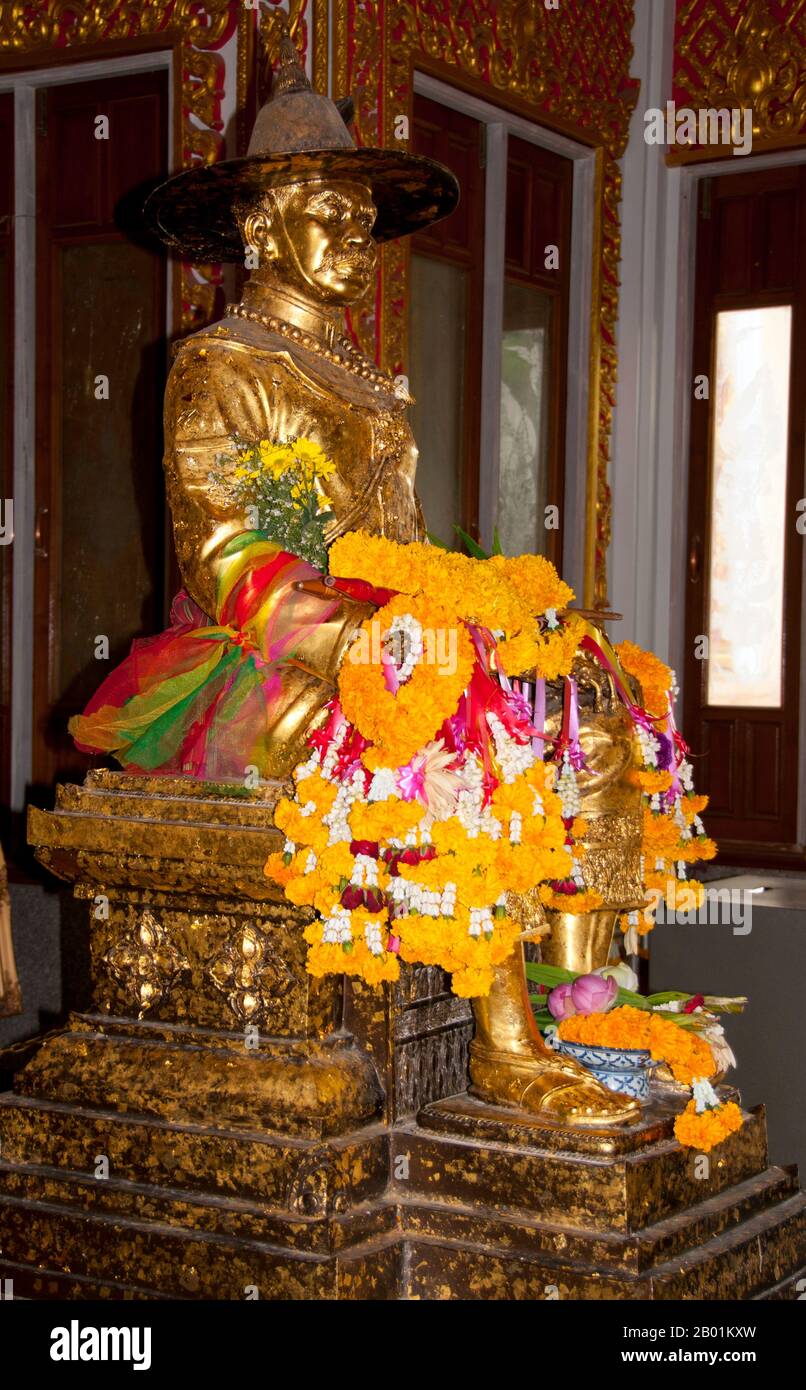 Thailand: King Taksin shrine, Rayong, Rayong Province. King Taksin (Somdet Phra Chao Taksin Maharat; 17 April 1734 - 7 April 1782) was the only King of the Thonburi Kingdom. He is greatly revered by the Thai people for his leadership in liberating Siam from Burmese occupation after the Second Fall of Ayutthaya in 1767, and the subsequent unification of Siam after it fell under various warlords. King Taksin established Thonburi as his new capital, since Ayutthaya had been almost completely destroyed by the Burmese. His reign was characterised by numerous wars, fought to repel the Burmese. Stock Photohttps://www.alamy.com/image-license-details/?v=1https://www.alamy.com/thailand-king-taksin-shrine-rayong-rayong-province-king-taksin-somdet-phra-chao-taksin-maharat-17-april-1734-7-april-1782-was-the-only-king-of-the-thonburi-kingdom-he-is-greatly-revered-by-the-thai-people-for-his-leadership-in-liberating-siam-from-burmese-occupation-after-the-second-fall-of-ayutthaya-in-1767-and-the-subsequent-unification-of-siam-after-it-fell-under-various-warlords-king-taksin-established-thonburi-as-his-new-capital-since-ayutthaya-had-been-almost-completely-destroyed-by-the-burmese-his-reign-was-characterised-by-numerous-wars-fought-to-repel-the-burmese-image344244961.html
Thailand: King Taksin shrine, Rayong, Rayong Province. King Taksin (Somdet Phra Chao Taksin Maharat; 17 April 1734 - 7 April 1782) was the only King of the Thonburi Kingdom. He is greatly revered by the Thai people for his leadership in liberating Siam from Burmese occupation after the Second Fall of Ayutthaya in 1767, and the subsequent unification of Siam after it fell under various warlords. King Taksin established Thonburi as his new capital, since Ayutthaya had been almost completely destroyed by the Burmese. His reign was characterised by numerous wars, fought to repel the Burmese. Stock Photohttps://www.alamy.com/image-license-details/?v=1https://www.alamy.com/thailand-king-taksin-shrine-rayong-rayong-province-king-taksin-somdet-phra-chao-taksin-maharat-17-april-1734-7-april-1782-was-the-only-king-of-the-thonburi-kingdom-he-is-greatly-revered-by-the-thai-people-for-his-leadership-in-liberating-siam-from-burmese-occupation-after-the-second-fall-of-ayutthaya-in-1767-and-the-subsequent-unification-of-siam-after-it-fell-under-various-warlords-king-taksin-established-thonburi-as-his-new-capital-since-ayutthaya-had-been-almost-completely-destroyed-by-the-burmese-his-reign-was-characterised-by-numerous-wars-fought-to-repel-the-burmese-image344244961.htmlRM2B01KXW–Thailand: King Taksin shrine, Rayong, Rayong Province. King Taksin (Somdet Phra Chao Taksin Maharat; 17 April 1734 - 7 April 1782) was the only King of the Thonburi Kingdom. He is greatly revered by the Thai people for his leadership in liberating Siam from Burmese occupation after the Second Fall of Ayutthaya in 1767, and the subsequent unification of Siam after it fell under various warlords. King Taksin established Thonburi as his new capital, since Ayutthaya had been almost completely destroyed by the Burmese. His reign was characterised by numerous wars, fought to repel the Burmese.
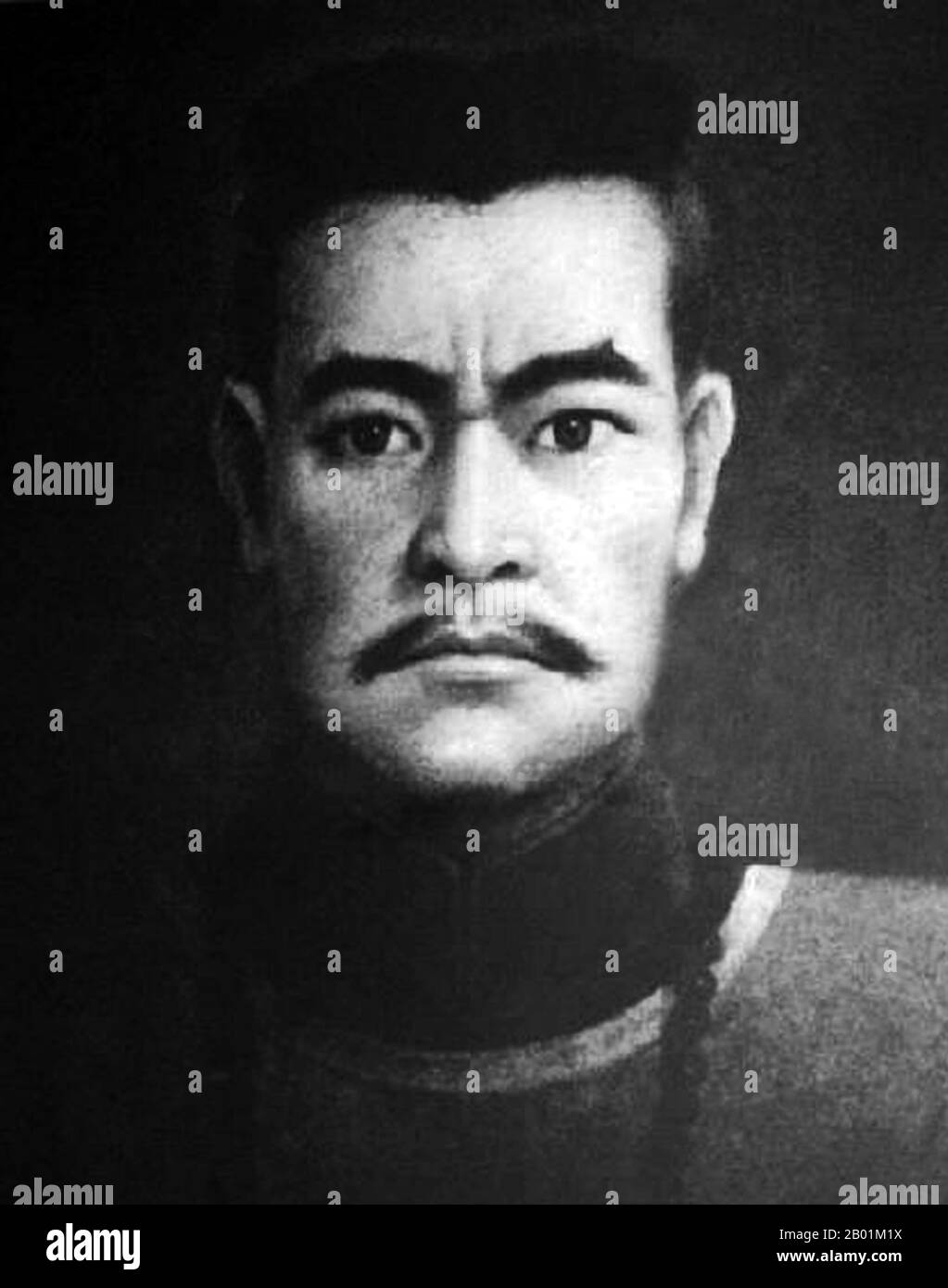 Thailand: King Taksin the Great (17 April 1734 - 7 April 1782), King of Siam (r. 1768-1782). Drawing by a French priest, Wat Choengthar, Ayutthaya, 18th century. Taksin (Somdet Phra Chao Taksin Maharat) was the only King of the Thonburi Kingdom. He is greatly revered by the Thai people for his leadership in liberating Siam from Burmese occupation after the Second Fall of Ayutthaya in 1767, and the subsequent unification of Siam after it fell under various warlords. He established the city Thonburi as the new capital, as the city Ayutthaya had been almost completely destroyed by the invaders. Stock Photohttps://www.alamy.com/image-license-details/?v=1https://www.alamy.com/thailand-king-taksin-the-great-17-april-1734-7-april-1782-king-of-siam-r-1768-1782-drawing-by-a-french-priest-wat-choengthar-ayutthaya-18th-century-taksin-somdet-phra-chao-taksin-maharat-was-the-only-king-of-the-thonburi-kingdom-he-is-greatly-revered-by-the-thai-people-for-his-leadership-in-liberating-siam-from-burmese-occupation-after-the-second-fall-of-ayutthaya-in-1767-and-the-subsequent-unification-of-siam-after-it-fell-under-various-warlords-he-established-the-city-thonburi-as-the-new-capital-as-the-city-ayutthaya-had-been-almost-completely-destroyed-by-the-invaders-image344245046.html
Thailand: King Taksin the Great (17 April 1734 - 7 April 1782), King of Siam (r. 1768-1782). Drawing by a French priest, Wat Choengthar, Ayutthaya, 18th century. Taksin (Somdet Phra Chao Taksin Maharat) was the only King of the Thonburi Kingdom. He is greatly revered by the Thai people for his leadership in liberating Siam from Burmese occupation after the Second Fall of Ayutthaya in 1767, and the subsequent unification of Siam after it fell under various warlords. He established the city Thonburi as the new capital, as the city Ayutthaya had been almost completely destroyed by the invaders. Stock Photohttps://www.alamy.com/image-license-details/?v=1https://www.alamy.com/thailand-king-taksin-the-great-17-april-1734-7-april-1782-king-of-siam-r-1768-1782-drawing-by-a-french-priest-wat-choengthar-ayutthaya-18th-century-taksin-somdet-phra-chao-taksin-maharat-was-the-only-king-of-the-thonburi-kingdom-he-is-greatly-revered-by-the-thai-people-for-his-leadership-in-liberating-siam-from-burmese-occupation-after-the-second-fall-of-ayutthaya-in-1767-and-the-subsequent-unification-of-siam-after-it-fell-under-various-warlords-he-established-the-city-thonburi-as-the-new-capital-as-the-city-ayutthaya-had-been-almost-completely-destroyed-by-the-invaders-image344245046.htmlRM2B01M1X–Thailand: King Taksin the Great (17 April 1734 - 7 April 1782), King of Siam (r. 1768-1782). Drawing by a French priest, Wat Choengthar, Ayutthaya, 18th century. Taksin (Somdet Phra Chao Taksin Maharat) was the only King of the Thonburi Kingdom. He is greatly revered by the Thai people for his leadership in liberating Siam from Burmese occupation after the Second Fall of Ayutthaya in 1767, and the subsequent unification of Siam after it fell under various warlords. He established the city Thonburi as the new capital, as the city Ayutthaya had been almost completely destroyed by the invaders.
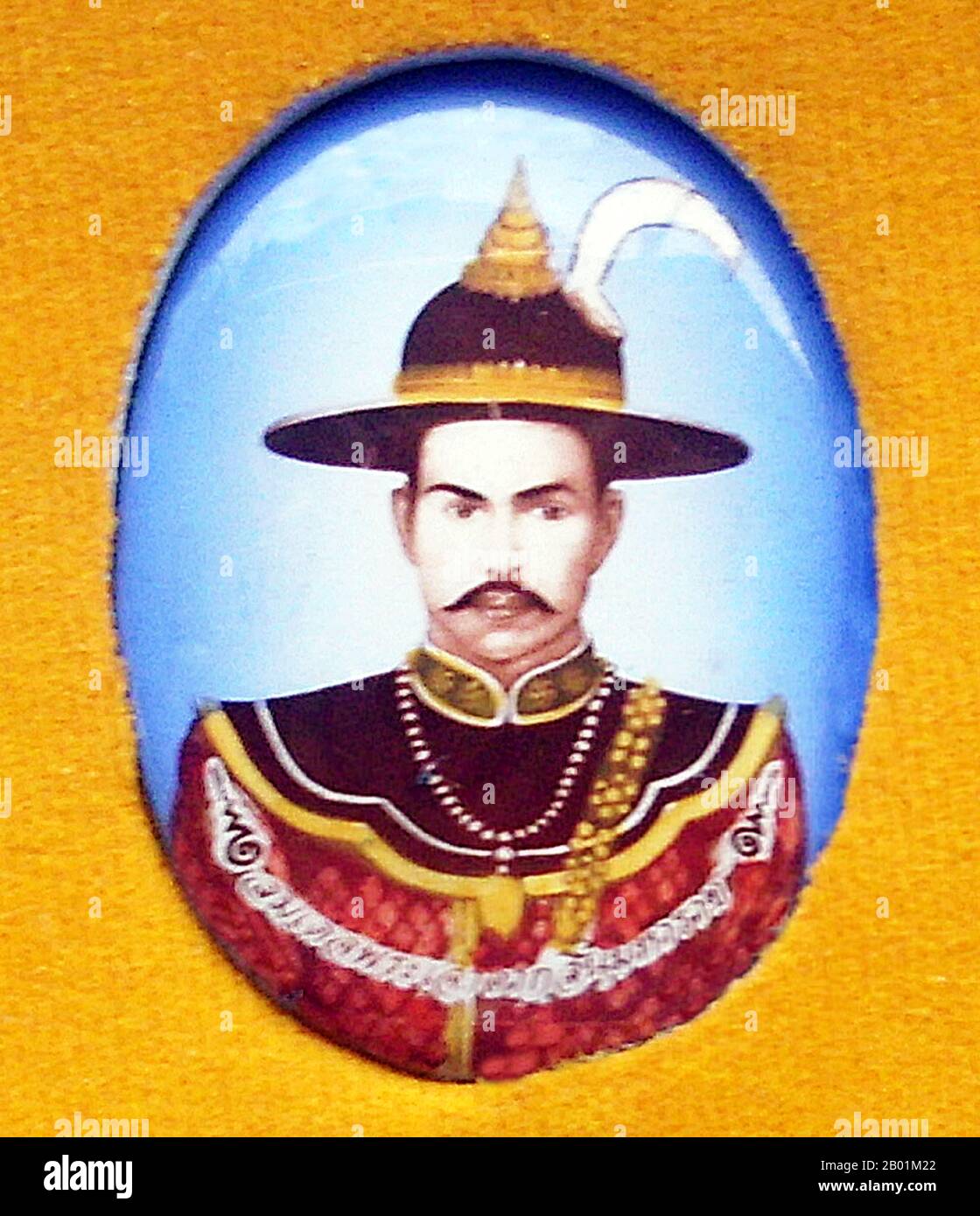 Thailand: King Taksin the Great (17 April 1734 - 7 April 1782), King of Siam (r. 1768-1782), represented on an amulet for sale at Sanam Luang, Bangkok, in 2010. Taksin (Somdet Phra Chao Taksin Maharat) was the only King of the Thonburi Kingdom. He is greatly revered by the Thai people for his leadership in liberating Siam from Burmese occupation after the Second Fall of Ayutthaya in 1767, and the subsequent unification of Siam after it fell under various warlords. He established the city Thonburi as the new capital, as the city Ayutthaya had been almost completely destroyed by the invaders. Stock Photohttps://www.alamy.com/image-license-details/?v=1https://www.alamy.com/thailand-king-taksin-the-great-17-april-1734-7-april-1782-king-of-siam-r-1768-1782-represented-on-an-amulet-for-sale-at-sanam-luang-bangkok-in-2010-taksin-somdet-phra-chao-taksin-maharat-was-the-only-king-of-the-thonburi-kingdom-he-is-greatly-revered-by-the-thai-people-for-his-leadership-in-liberating-siam-from-burmese-occupation-after-the-second-fall-of-ayutthaya-in-1767-and-the-subsequent-unification-of-siam-after-it-fell-under-various-warlords-he-established-the-city-thonburi-as-the-new-capital-as-the-city-ayutthaya-had-been-almost-completely-destroyed-by-the-invaders-image344245050.html
Thailand: King Taksin the Great (17 April 1734 - 7 April 1782), King of Siam (r. 1768-1782), represented on an amulet for sale at Sanam Luang, Bangkok, in 2010. Taksin (Somdet Phra Chao Taksin Maharat) was the only King of the Thonburi Kingdom. He is greatly revered by the Thai people for his leadership in liberating Siam from Burmese occupation after the Second Fall of Ayutthaya in 1767, and the subsequent unification of Siam after it fell under various warlords. He established the city Thonburi as the new capital, as the city Ayutthaya had been almost completely destroyed by the invaders. Stock Photohttps://www.alamy.com/image-license-details/?v=1https://www.alamy.com/thailand-king-taksin-the-great-17-april-1734-7-april-1782-king-of-siam-r-1768-1782-represented-on-an-amulet-for-sale-at-sanam-luang-bangkok-in-2010-taksin-somdet-phra-chao-taksin-maharat-was-the-only-king-of-the-thonburi-kingdom-he-is-greatly-revered-by-the-thai-people-for-his-leadership-in-liberating-siam-from-burmese-occupation-after-the-second-fall-of-ayutthaya-in-1767-and-the-subsequent-unification-of-siam-after-it-fell-under-various-warlords-he-established-the-city-thonburi-as-the-new-capital-as-the-city-ayutthaya-had-been-almost-completely-destroyed-by-the-invaders-image344245050.htmlRM2B01M22–Thailand: King Taksin the Great (17 April 1734 - 7 April 1782), King of Siam (r. 1768-1782), represented on an amulet for sale at Sanam Luang, Bangkok, in 2010. Taksin (Somdet Phra Chao Taksin Maharat) was the only King of the Thonburi Kingdom. He is greatly revered by the Thai people for his leadership in liberating Siam from Burmese occupation after the Second Fall of Ayutthaya in 1767, and the subsequent unification of Siam after it fell under various warlords. He established the city Thonburi as the new capital, as the city Ayutthaya had been almost completely destroyed by the invaders.
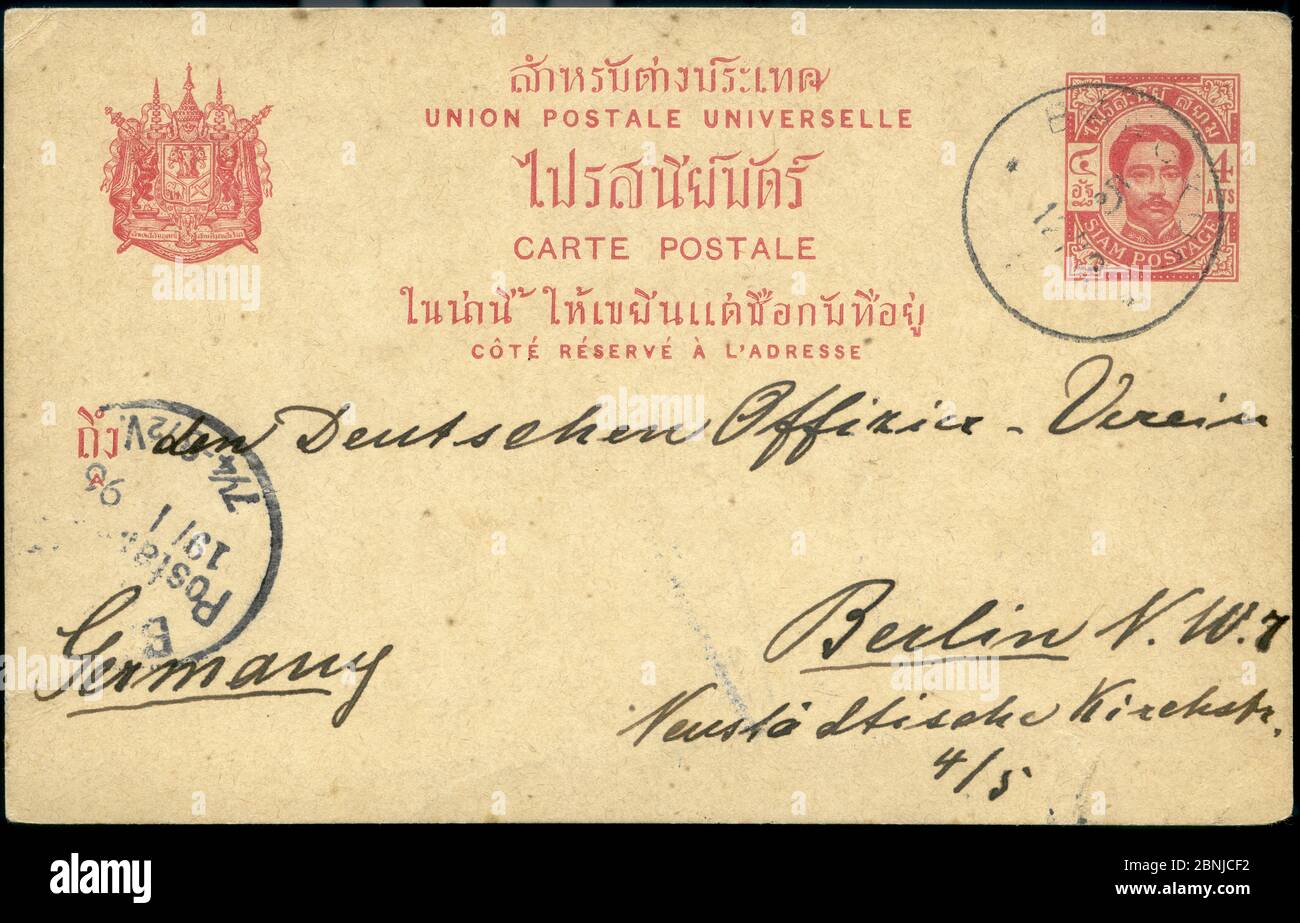 1895 Postal card Rama V Second ssue 4Atts(#PC-0003) from Bangkok to Germany, tied by BANGKOK 5 (BDR-06A) cds dated 12/2/95. On obverse bearing BERLIN. Stock Photohttps://www.alamy.com/image-license-details/?v=1https://www.alamy.com/1895-postal-card-rama-v-second-ssue-4attspc-0003-from-bangkok-to-germany-tied-by-bangkok-5-bdr-06a-cds-dated-12295-on-obverse-bearing-berlin-image357520102.html
1895 Postal card Rama V Second ssue 4Atts(#PC-0003) from Bangkok to Germany, tied by BANGKOK 5 (BDR-06A) cds dated 12/2/95. On obverse bearing BERLIN. Stock Photohttps://www.alamy.com/image-license-details/?v=1https://www.alamy.com/1895-postal-card-rama-v-second-ssue-4attspc-0003-from-bangkok-to-germany-tied-by-bangkok-5-bdr-06a-cds-dated-12295-on-obverse-bearing-berlin-image357520102.htmlRF2BNJCF2–1895 Postal card Rama V Second ssue 4Atts(#PC-0003) from Bangkok to Germany, tied by BANGKOK 5 (BDR-06A) cds dated 12/2/95. On obverse bearing BERLIN.
 Old Bangkok July-2000 (Digital Slide Conversion) Reclining,lying down,Buddha in Wat Phoo Bangkok Temple,Thailand Stock Photohttps://www.alamy.com/image-license-details/?v=1https://www.alamy.com/stock-photo-old-bangkok-july-2000-digital-slide-conversion-reclininglying-downbuddha-50974033.html
Old Bangkok July-2000 (Digital Slide Conversion) Reclining,lying down,Buddha in Wat Phoo Bangkok Temple,Thailand Stock Photohttps://www.alamy.com/image-license-details/?v=1https://www.alamy.com/stock-photo-old-bangkok-july-2000-digital-slide-conversion-reclininglying-downbuddha-50974033.htmlRMCXX1W5–Old Bangkok July-2000 (Digital Slide Conversion) Reclining,lying down,Buddha in Wat Phoo Bangkok Temple,Thailand
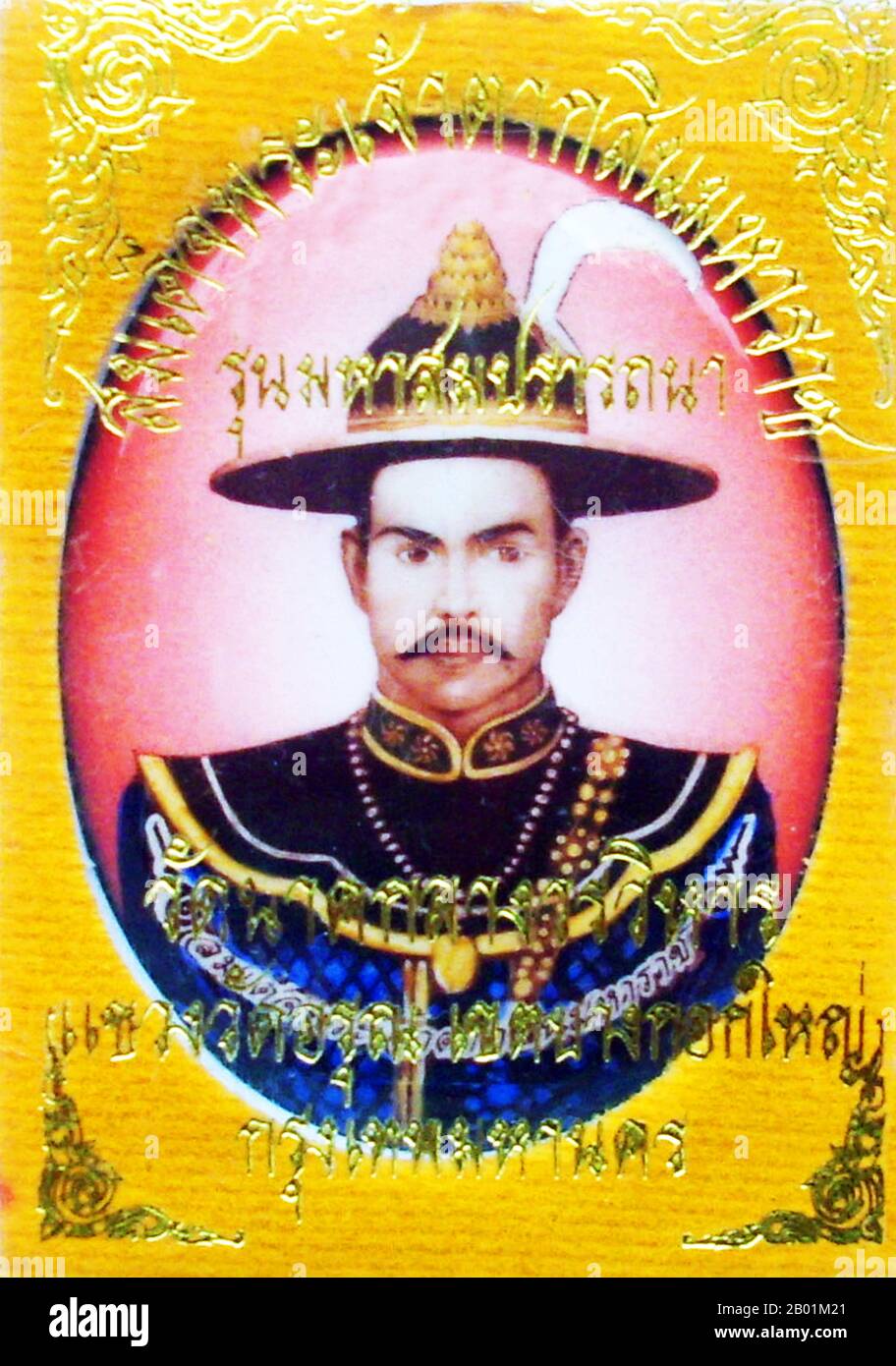 Thailand: King Taksin the Great (17 April 1734 - 7 April 1782), King of Siam (r. 1768-1782), represented on an amulet for sale at Sanam Luang, Bangkok, in 2010. Taksin (Somdet Phra Chao Taksin Maharat) was the only King of the Thonburi Kingdom. He is greatly revered by the Thai people for his leadership in liberating Siam from Burmese occupation after the Second Fall of Ayutthaya in 1767, and the subsequent unification of Siam after it fell under various warlords. He established the city Thonburi as the new capital, as the city Ayutthaya had been almost completely destroyed by the invaders. Stock Photohttps://www.alamy.com/image-license-details/?v=1https://www.alamy.com/thailand-king-taksin-the-great-17-april-1734-7-april-1782-king-of-siam-r-1768-1782-represented-on-an-amulet-for-sale-at-sanam-luang-bangkok-in-2010-taksin-somdet-phra-chao-taksin-maharat-was-the-only-king-of-the-thonburi-kingdom-he-is-greatly-revered-by-the-thai-people-for-his-leadership-in-liberating-siam-from-burmese-occupation-after-the-second-fall-of-ayutthaya-in-1767-and-the-subsequent-unification-of-siam-after-it-fell-under-various-warlords-he-established-the-city-thonburi-as-the-new-capital-as-the-city-ayutthaya-had-been-almost-completely-destroyed-by-the-invaders-image344245049.html
Thailand: King Taksin the Great (17 April 1734 - 7 April 1782), King of Siam (r. 1768-1782), represented on an amulet for sale at Sanam Luang, Bangkok, in 2010. Taksin (Somdet Phra Chao Taksin Maharat) was the only King of the Thonburi Kingdom. He is greatly revered by the Thai people for his leadership in liberating Siam from Burmese occupation after the Second Fall of Ayutthaya in 1767, and the subsequent unification of Siam after it fell under various warlords. He established the city Thonburi as the new capital, as the city Ayutthaya had been almost completely destroyed by the invaders. Stock Photohttps://www.alamy.com/image-license-details/?v=1https://www.alamy.com/thailand-king-taksin-the-great-17-april-1734-7-april-1782-king-of-siam-r-1768-1782-represented-on-an-amulet-for-sale-at-sanam-luang-bangkok-in-2010-taksin-somdet-phra-chao-taksin-maharat-was-the-only-king-of-the-thonburi-kingdom-he-is-greatly-revered-by-the-thai-people-for-his-leadership-in-liberating-siam-from-burmese-occupation-after-the-second-fall-of-ayutthaya-in-1767-and-the-subsequent-unification-of-siam-after-it-fell-under-various-warlords-he-established-the-city-thonburi-as-the-new-capital-as-the-city-ayutthaya-had-been-almost-completely-destroyed-by-the-invaders-image344245049.htmlRM2B01M21–Thailand: King Taksin the Great (17 April 1734 - 7 April 1782), King of Siam (r. 1768-1782), represented on an amulet for sale at Sanam Luang, Bangkok, in 2010. Taksin (Somdet Phra Chao Taksin Maharat) was the only King of the Thonburi Kingdom. He is greatly revered by the Thai people for his leadership in liberating Siam from Burmese occupation after the Second Fall of Ayutthaya in 1767, and the subsequent unification of Siam after it fell under various warlords. He established the city Thonburi as the new capital, as the city Ayutthaya had been almost completely destroyed by the invaders.
 Thailand: King Rama II, Buddha Loetla Nabhalai (24 February 1767 – 21 July 1824), 2nd monarch of the Chakri Dynasty. Oil on canvas painting, c. 19th century. Phra Bat Somdet Phra Poramenthramaha Isarasundhorn Phra Buddha Loetla Nabhalai, or Rama II, was the second monarch of Siam under the House of Chakri, ruling from 1809-1824. In 1809, Isarasundhorn succeeded his father Buddha Yodfa Chulaloke, the founder of Chakri dynasty, as Buddha Loetla Nabhalai the King of Siam. His reign was largely peaceful, devoid of major conflicts. His reign was known as the 'Golden Age of Rattanakosin Literature' Stock Photohttps://www.alamy.com/image-license-details/?v=1https://www.alamy.com/thailand-king-rama-ii-buddha-loetla-nabhalai-24-february-1767-21-july-1824-2nd-monarch-of-the-chakri-dynasty-oil-on-canvas-painting-c-19th-century-phra-bat-somdet-phra-poramenthramaha-isarasundhorn-phra-buddha-loetla-nabhalai-or-rama-ii-was-the-second-monarch-of-siam-under-the-house-of-chakri-ruling-from-1809-1824-in-1809-isarasundhorn-succeeded-his-father-buddha-yodfa-chulaloke-the-founder-of-chakri-dynasty-as-buddha-loetla-nabhalai-the-king-of-siam-his-reign-was-largely-peaceful-devoid-of-major-conflicts-his-reign-was-known-as-the-golden-age-of-rattanakosin-literature-image344232246.html
Thailand: King Rama II, Buddha Loetla Nabhalai (24 February 1767 – 21 July 1824), 2nd monarch of the Chakri Dynasty. Oil on canvas painting, c. 19th century. Phra Bat Somdet Phra Poramenthramaha Isarasundhorn Phra Buddha Loetla Nabhalai, or Rama II, was the second monarch of Siam under the House of Chakri, ruling from 1809-1824. In 1809, Isarasundhorn succeeded his father Buddha Yodfa Chulaloke, the founder of Chakri dynasty, as Buddha Loetla Nabhalai the King of Siam. His reign was largely peaceful, devoid of major conflicts. His reign was known as the 'Golden Age of Rattanakosin Literature' Stock Photohttps://www.alamy.com/image-license-details/?v=1https://www.alamy.com/thailand-king-rama-ii-buddha-loetla-nabhalai-24-february-1767-21-july-1824-2nd-monarch-of-the-chakri-dynasty-oil-on-canvas-painting-c-19th-century-phra-bat-somdet-phra-poramenthramaha-isarasundhorn-phra-buddha-loetla-nabhalai-or-rama-ii-was-the-second-monarch-of-siam-under-the-house-of-chakri-ruling-from-1809-1824-in-1809-isarasundhorn-succeeded-his-father-buddha-yodfa-chulaloke-the-founder-of-chakri-dynasty-as-buddha-loetla-nabhalai-the-king-of-siam-his-reign-was-largely-peaceful-devoid-of-major-conflicts-his-reign-was-known-as-the-golden-age-of-rattanakosin-literature-image344232246.htmlRM2B013MP–Thailand: King Rama II, Buddha Loetla Nabhalai (24 February 1767 – 21 July 1824), 2nd monarch of the Chakri Dynasty. Oil on canvas painting, c. 19th century. Phra Bat Somdet Phra Poramenthramaha Isarasundhorn Phra Buddha Loetla Nabhalai, or Rama II, was the second monarch of Siam under the House of Chakri, ruling from 1809-1824. In 1809, Isarasundhorn succeeded his father Buddha Yodfa Chulaloke, the founder of Chakri dynasty, as Buddha Loetla Nabhalai the King of Siam. His reign was largely peaceful, devoid of major conflicts. His reign was known as the 'Golden Age of Rattanakosin Literature'
 Old Bangkok 06-2000 (Slides Conversions) The Ayutthaya historical park covers the ruins of the old city of Ayutthaya Thailand Stock Photohttps://www.alamy.com/image-license-details/?v=1https://www.alamy.com/stock-photo-old-bangkok-06-2000-slides-conversions-the-ayutthaya-historical-park-50973402.html
Old Bangkok 06-2000 (Slides Conversions) The Ayutthaya historical park covers the ruins of the old city of Ayutthaya Thailand Stock Photohttps://www.alamy.com/image-license-details/?v=1https://www.alamy.com/stock-photo-old-bangkok-06-2000-slides-conversions-the-ayutthaya-historical-park-50973402.htmlRMCXX12J–Old Bangkok 06-2000 (Slides Conversions) The Ayutthaya historical park covers the ruins of the old city of Ayutthaya Thailand
 Thailand: King Rama II, Buddha Loetla Nabhalai (24 February 1767 – 21 July 1824), 2nd monarch of the Chakri Dynasty. Oil on canvas painting, c. 19th century. Phra Bat Somdet Phra Poramenthramaha Isarasundhorn Phra Buddha Loetla Nabhalai, or Rama II, was the second monarch of Siam under the House of Chakri, ruling from 1809-1824. In 1809, Isarasundhorn succeeded his father Buddha Yodfa Chulaloke, the founder of Chakri dynasty, as Buddha Loetla Nabhalai the King of Siam. His reign was largely peaceful, devoid of major conflicts. His reign was known as the 'Golden Age of Rattanakosin Literature' Stock Photohttps://www.alamy.com/image-license-details/?v=1https://www.alamy.com/thailand-king-rama-ii-buddha-loetla-nabhalai-24-february-1767-21-july-1824-2nd-monarch-of-the-chakri-dynasty-oil-on-canvas-painting-c-19th-century-phra-bat-somdet-phra-poramenthramaha-isarasundhorn-phra-buddha-loetla-nabhalai-or-rama-ii-was-the-second-monarch-of-siam-under-the-house-of-chakri-ruling-from-1809-1824-in-1809-isarasundhorn-succeeded-his-father-buddha-yodfa-chulaloke-the-founder-of-chakri-dynasty-as-buddha-loetla-nabhalai-the-king-of-siam-his-reign-was-largely-peaceful-devoid-of-major-conflicts-his-reign-was-known-as-the-golden-age-of-rattanakosin-literature-image344232248.html
Thailand: King Rama II, Buddha Loetla Nabhalai (24 February 1767 – 21 July 1824), 2nd monarch of the Chakri Dynasty. Oil on canvas painting, c. 19th century. Phra Bat Somdet Phra Poramenthramaha Isarasundhorn Phra Buddha Loetla Nabhalai, or Rama II, was the second monarch of Siam under the House of Chakri, ruling from 1809-1824. In 1809, Isarasundhorn succeeded his father Buddha Yodfa Chulaloke, the founder of Chakri dynasty, as Buddha Loetla Nabhalai the King of Siam. His reign was largely peaceful, devoid of major conflicts. His reign was known as the 'Golden Age of Rattanakosin Literature' Stock Photohttps://www.alamy.com/image-license-details/?v=1https://www.alamy.com/thailand-king-rama-ii-buddha-loetla-nabhalai-24-february-1767-21-july-1824-2nd-monarch-of-the-chakri-dynasty-oil-on-canvas-painting-c-19th-century-phra-bat-somdet-phra-poramenthramaha-isarasundhorn-phra-buddha-loetla-nabhalai-or-rama-ii-was-the-second-monarch-of-siam-under-the-house-of-chakri-ruling-from-1809-1824-in-1809-isarasundhorn-succeeded-his-father-buddha-yodfa-chulaloke-the-founder-of-chakri-dynasty-as-buddha-loetla-nabhalai-the-king-of-siam-his-reign-was-largely-peaceful-devoid-of-major-conflicts-his-reign-was-known-as-the-golden-age-of-rattanakosin-literature-image344232248.htmlRM2B013MT–Thailand: King Rama II, Buddha Loetla Nabhalai (24 February 1767 – 21 July 1824), 2nd monarch of the Chakri Dynasty. Oil on canvas painting, c. 19th century. Phra Bat Somdet Phra Poramenthramaha Isarasundhorn Phra Buddha Loetla Nabhalai, or Rama II, was the second monarch of Siam under the House of Chakri, ruling from 1809-1824. In 1809, Isarasundhorn succeeded his father Buddha Yodfa Chulaloke, the founder of Chakri dynasty, as Buddha Loetla Nabhalai the King of Siam. His reign was largely peaceful, devoid of major conflicts. His reign was known as the 'Golden Age of Rattanakosin Literature'
 Old Bangkok July-2000 (Slides Conversions) The Ayutthaya historical park covers the ruins of the old city of Ayutthaya Thailand Stock Photohttps://www.alamy.com/image-license-details/?v=1https://www.alamy.com/stock-photo-old-bangkok-july-2000-slides-conversions-the-ayutthaya-historical-50973516.html
Old Bangkok July-2000 (Slides Conversions) The Ayutthaya historical park covers the ruins of the old city of Ayutthaya Thailand Stock Photohttps://www.alamy.com/image-license-details/?v=1https://www.alamy.com/stock-photo-old-bangkok-july-2000-slides-conversions-the-ayutthaya-historical-50973516.htmlRMCXX16M–Old Bangkok July-2000 (Slides Conversions) The Ayutthaya historical park covers the ruins of the old city of Ayutthaya Thailand
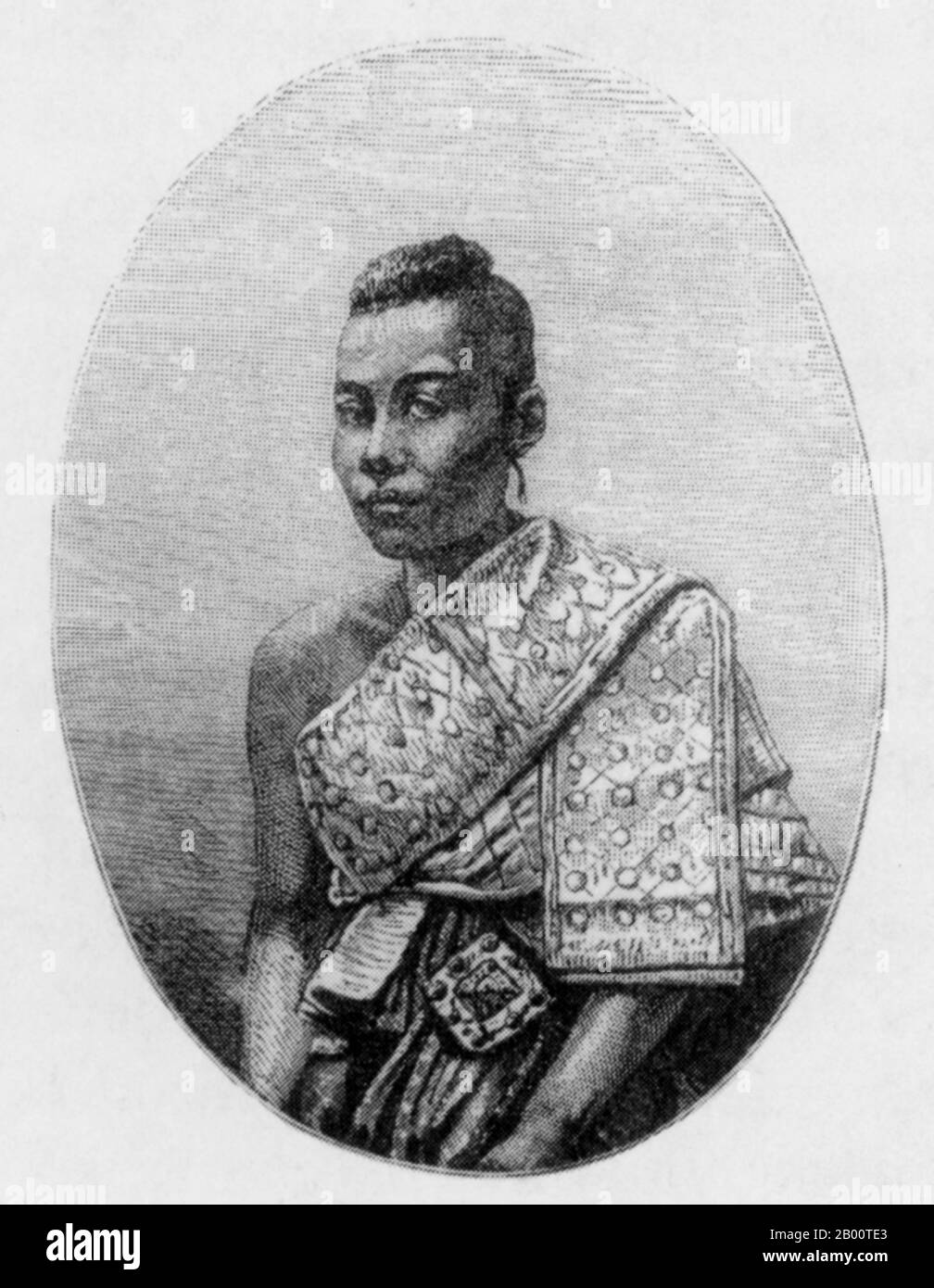 Thailand: Sketch of Queen Debsirindra, the second wife of King Mongkut. Drawing by Etienne-Gabrial Bocourt (1821-1913), 19th century. In this drawing, Queen Debsirindra sports the fashionable hairstyle of the Siamese court, shaved at the sides and with a circle around the tuft. In Siam, a lady’s hair was often likened to an open lotus flower. Somdet Phra Debsirindra Boroma Rajini (17 July 1834—9 September 1861) was the second consort of King Mongkut (Rama IV), and mother of the future King Chulalongkorn (Rama V). Stock Photohttps://www.alamy.com/image-license-details/?v=1https://www.alamy.com/thailand-sketch-of-queen-debsirindra-the-second-wife-of-king-mongkut-drawing-by-etienne-gabrial-bocourt-1821-1913-19th-century-in-this-drawing-queen-debsirindra-sports-the-fashionable-hairstyle-of-the-siamese-court-shaved-at-the-sides-and-with-a-circle-around-the-tuft-in-siam-a-ladys-hair-was-often-likened-to-an-open-lotus-flower-somdet-phra-debsirindra-boroma-rajini-17-july-18349-september-1861-was-the-second-consort-of-king-mongkut-rama-iv-and-mother-of-the-future-king-chulalongkorn-rama-v-image344226571.html
Thailand: Sketch of Queen Debsirindra, the second wife of King Mongkut. Drawing by Etienne-Gabrial Bocourt (1821-1913), 19th century. In this drawing, Queen Debsirindra sports the fashionable hairstyle of the Siamese court, shaved at the sides and with a circle around the tuft. In Siam, a lady’s hair was often likened to an open lotus flower. Somdet Phra Debsirindra Boroma Rajini (17 July 1834—9 September 1861) was the second consort of King Mongkut (Rama IV), and mother of the future King Chulalongkorn (Rama V). Stock Photohttps://www.alamy.com/image-license-details/?v=1https://www.alamy.com/thailand-sketch-of-queen-debsirindra-the-second-wife-of-king-mongkut-drawing-by-etienne-gabrial-bocourt-1821-1913-19th-century-in-this-drawing-queen-debsirindra-sports-the-fashionable-hairstyle-of-the-siamese-court-shaved-at-the-sides-and-with-a-circle-around-the-tuft-in-siam-a-ladys-hair-was-often-likened-to-an-open-lotus-flower-somdet-phra-debsirindra-boroma-rajini-17-july-18349-september-1861-was-the-second-consort-of-king-mongkut-rama-iv-and-mother-of-the-future-king-chulalongkorn-rama-v-image344226571.htmlRM2B00TE3–Thailand: Sketch of Queen Debsirindra, the second wife of King Mongkut. Drawing by Etienne-Gabrial Bocourt (1821-1913), 19th century. In this drawing, Queen Debsirindra sports the fashionable hairstyle of the Siamese court, shaved at the sides and with a circle around the tuft. In Siam, a lady’s hair was often likened to an open lotus flower. Somdet Phra Debsirindra Boroma Rajini (17 July 1834—9 September 1861) was the second consort of King Mongkut (Rama IV), and mother of the future King Chulalongkorn (Rama V).
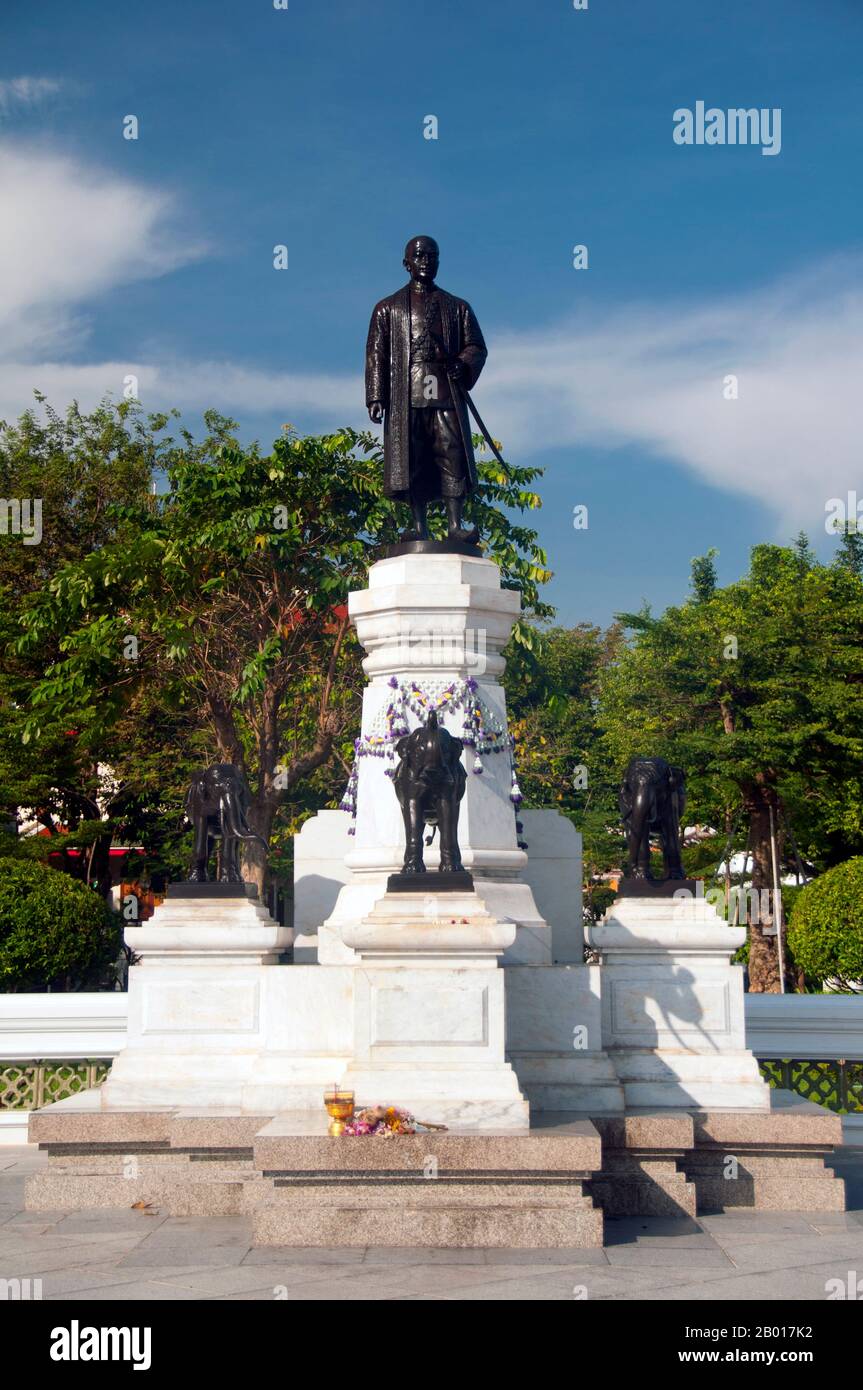 Thailand: Rama II statue at Wat Arun (Temple of Dawn), Bangkok. Phra Bat Somdet Phra Poramenthramaha Isarasundhorn Phra Buddha Loetla Nabhalai, or Rama II (24 February 1767 – 21 July 1824), was the second monarch of Siam under the House of Chakri, ruling from 1809-1824. In 1809, Isarasundhorn succeeded his father Buddha Yodfa Chulaloke, the founder of Chakri dynasty, as Buddha Loetla Nabhalai the King of Siam. His reign was largely peaceful, devoid of major conflicts. His reign was known as the 'Golden Age of Rattanakosin Literature'. Stock Photohttps://www.alamy.com/image-license-details/?v=1https://www.alamy.com/thailand-rama-ii-statue-at-wat-arun-temple-of-dawn-bangkok-phra-bat-somdet-phra-poramenthramaha-isarasundhorn-phra-buddha-loetla-nabhalai-or-rama-ii-24-february-1767-21-july-1824-was-the-second-monarch-of-siam-under-the-house-of-chakri-ruling-from-1809-1824-in-1809-isarasundhorn-succeeded-his-father-buddha-yodfa-chulaloke-the-founder-of-chakri-dynasty-as-buddha-loetla-nabhalai-the-king-of-siam-his-reign-was-largely-peaceful-devoid-of-major-conflicts-his-reign-was-known-as-the-golden-age-of-rattanakosin-literature-image344235334.html
Thailand: Rama II statue at Wat Arun (Temple of Dawn), Bangkok. Phra Bat Somdet Phra Poramenthramaha Isarasundhorn Phra Buddha Loetla Nabhalai, or Rama II (24 February 1767 – 21 July 1824), was the second monarch of Siam under the House of Chakri, ruling from 1809-1824. In 1809, Isarasundhorn succeeded his father Buddha Yodfa Chulaloke, the founder of Chakri dynasty, as Buddha Loetla Nabhalai the King of Siam. His reign was largely peaceful, devoid of major conflicts. His reign was known as the 'Golden Age of Rattanakosin Literature'. Stock Photohttps://www.alamy.com/image-license-details/?v=1https://www.alamy.com/thailand-rama-ii-statue-at-wat-arun-temple-of-dawn-bangkok-phra-bat-somdet-phra-poramenthramaha-isarasundhorn-phra-buddha-loetla-nabhalai-or-rama-ii-24-february-1767-21-july-1824-was-the-second-monarch-of-siam-under-the-house-of-chakri-ruling-from-1809-1824-in-1809-isarasundhorn-succeeded-his-father-buddha-yodfa-chulaloke-the-founder-of-chakri-dynasty-as-buddha-loetla-nabhalai-the-king-of-siam-his-reign-was-largely-peaceful-devoid-of-major-conflicts-his-reign-was-known-as-the-golden-age-of-rattanakosin-literature-image344235334.htmlRM2B017K2–Thailand: Rama II statue at Wat Arun (Temple of Dawn), Bangkok. Phra Bat Somdet Phra Poramenthramaha Isarasundhorn Phra Buddha Loetla Nabhalai, or Rama II (24 February 1767 – 21 July 1824), was the second monarch of Siam under the House of Chakri, ruling from 1809-1824. In 1809, Isarasundhorn succeeded his father Buddha Yodfa Chulaloke, the founder of Chakri dynasty, as Buddha Loetla Nabhalai the King of Siam. His reign was largely peaceful, devoid of major conflicts. His reign was known as the 'Golden Age of Rattanakosin Literature'.
 Old Bangkok July-2000 (Digital Slide Conversion) Big Buddha in Wat Phoo Bangkok Temple,Thailand Stock Photohttps://www.alamy.com/image-license-details/?v=1https://www.alamy.com/stock-photo-old-bangkok-july-2000-digital-slide-conversion-big-buddha-in-wat-phoo-50973989.html
Old Bangkok July-2000 (Digital Slide Conversion) Big Buddha in Wat Phoo Bangkok Temple,Thailand Stock Photohttps://www.alamy.com/image-license-details/?v=1https://www.alamy.com/stock-photo-old-bangkok-july-2000-digital-slide-conversion-big-buddha-in-wat-phoo-50973989.htmlRMCXX1RH–Old Bangkok July-2000 (Digital Slide Conversion) Big Buddha in Wat Phoo Bangkok Temple,Thailand
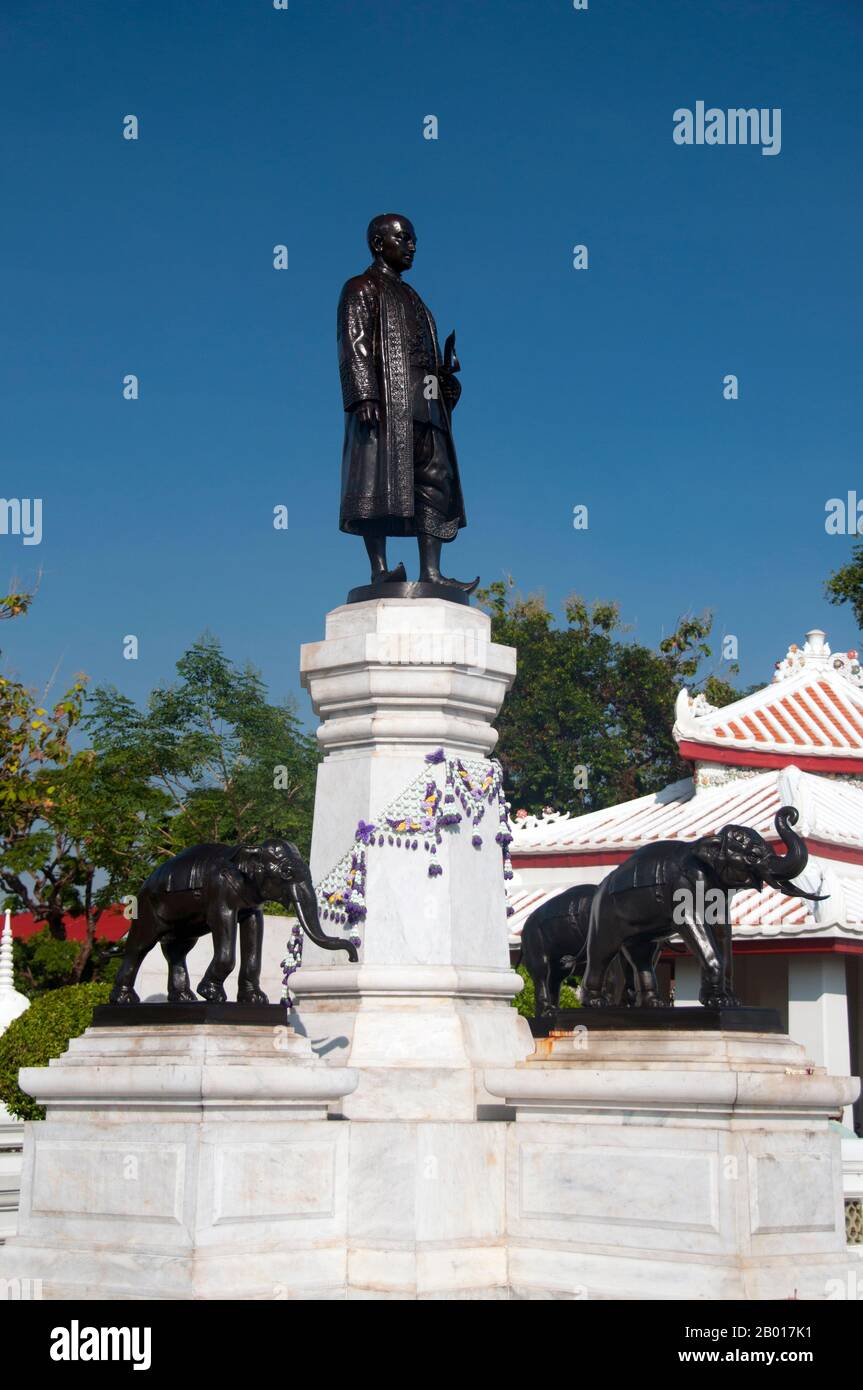 Thailand: Rama II statue at Wat Arun (Temple of Dawn), Bangkok. Phra Bat Somdet Phra Poramenthramaha Isarasundhorn Phra Buddha Loetla Nabhalai, or Rama II (24 February 1767 – 21 July 1824), was the second monarch of Siam under the House of Chakri, ruling from 1809-1824. In 1809, Isarasundhorn succeeded his father Buddha Yodfa Chulaloke, the founder of Chakri dynasty, as Buddha Loetla Nabhalai the King of Siam. His reign was largely peaceful, devoid of major conflicts. His reign was known as the 'Golden Age of Rattanakosin Literature'. Stock Photohttps://www.alamy.com/image-license-details/?v=1https://www.alamy.com/thailand-rama-ii-statue-at-wat-arun-temple-of-dawn-bangkok-phra-bat-somdet-phra-poramenthramaha-isarasundhorn-phra-buddha-loetla-nabhalai-or-rama-ii-24-february-1767-21-july-1824-was-the-second-monarch-of-siam-under-the-house-of-chakri-ruling-from-1809-1824-in-1809-isarasundhorn-succeeded-his-father-buddha-yodfa-chulaloke-the-founder-of-chakri-dynasty-as-buddha-loetla-nabhalai-the-king-of-siam-his-reign-was-largely-peaceful-devoid-of-major-conflicts-his-reign-was-known-as-the-golden-age-of-rattanakosin-literature-image344235333.html
Thailand: Rama II statue at Wat Arun (Temple of Dawn), Bangkok. Phra Bat Somdet Phra Poramenthramaha Isarasundhorn Phra Buddha Loetla Nabhalai, or Rama II (24 February 1767 – 21 July 1824), was the second monarch of Siam under the House of Chakri, ruling from 1809-1824. In 1809, Isarasundhorn succeeded his father Buddha Yodfa Chulaloke, the founder of Chakri dynasty, as Buddha Loetla Nabhalai the King of Siam. His reign was largely peaceful, devoid of major conflicts. His reign was known as the 'Golden Age of Rattanakosin Literature'. Stock Photohttps://www.alamy.com/image-license-details/?v=1https://www.alamy.com/thailand-rama-ii-statue-at-wat-arun-temple-of-dawn-bangkok-phra-bat-somdet-phra-poramenthramaha-isarasundhorn-phra-buddha-loetla-nabhalai-or-rama-ii-24-february-1767-21-july-1824-was-the-second-monarch-of-siam-under-the-house-of-chakri-ruling-from-1809-1824-in-1809-isarasundhorn-succeeded-his-father-buddha-yodfa-chulaloke-the-founder-of-chakri-dynasty-as-buddha-loetla-nabhalai-the-king-of-siam-his-reign-was-largely-peaceful-devoid-of-major-conflicts-his-reign-was-known-as-the-golden-age-of-rattanakosin-literature-image344235333.htmlRM2B017K1–Thailand: Rama II statue at Wat Arun (Temple of Dawn), Bangkok. Phra Bat Somdet Phra Poramenthramaha Isarasundhorn Phra Buddha Loetla Nabhalai, or Rama II (24 February 1767 – 21 July 1824), was the second monarch of Siam under the House of Chakri, ruling from 1809-1824. In 1809, Isarasundhorn succeeded his father Buddha Yodfa Chulaloke, the founder of Chakri dynasty, as Buddha Loetla Nabhalai the King of Siam. His reign was largely peaceful, devoid of major conflicts. His reign was known as the 'Golden Age of Rattanakosin Literature'.
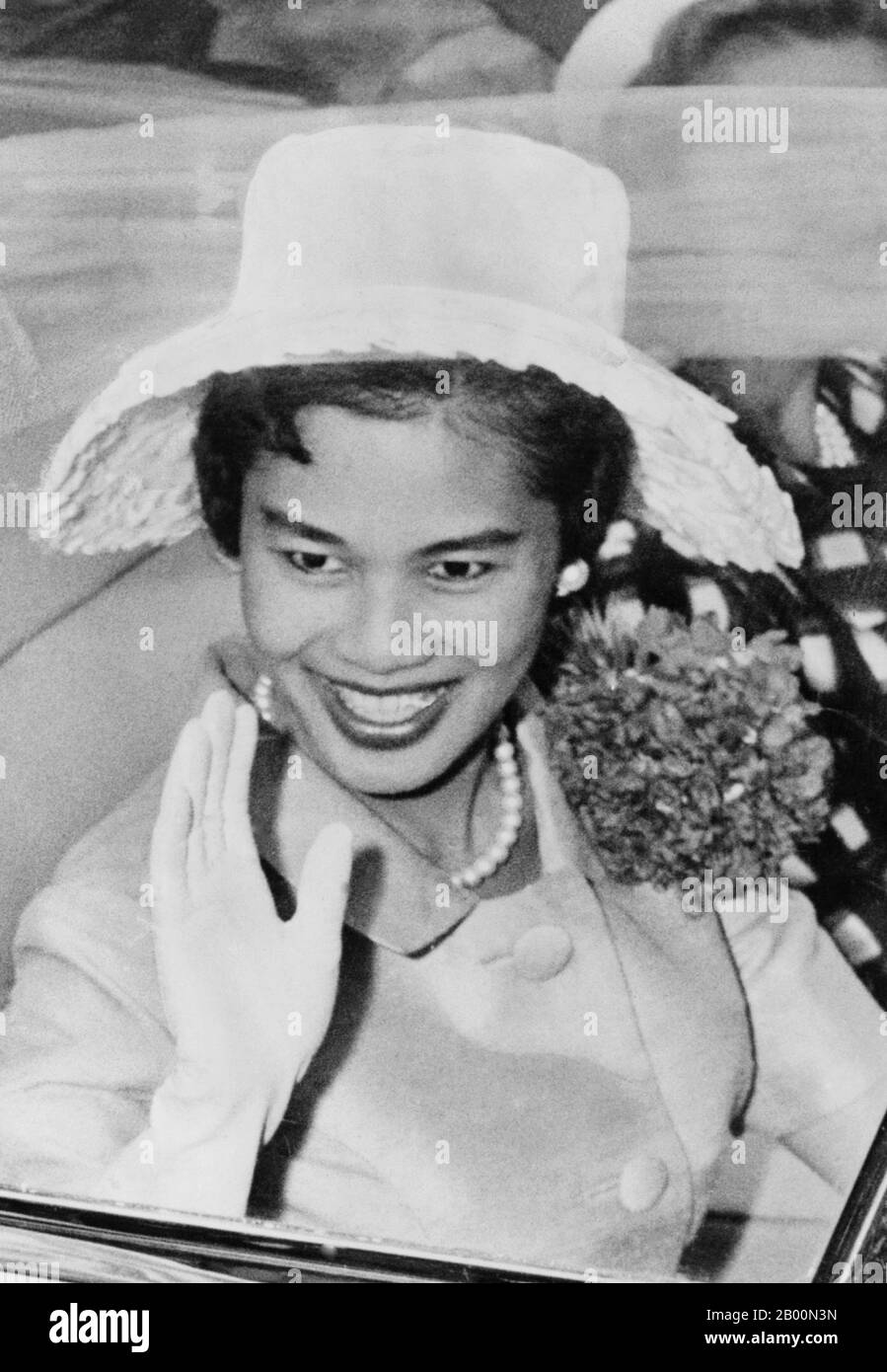 Thailand: Queen Sirikit during a parade in New York City, July 1960. Somdet Phra Nang Chao Sirikit Phra Borommarachininat (‘Her Majesty Queen Regent Sirikit’), born Mom Rajawongse Sirikit Kitiyakara on August 12, 1932, is the queen consort of Bhumibol Adulyadej (Rama IX), King of Thailand. She is the second Queen Regent of Thailand (the first Queen Regent was Queen Saovabha Bongsri of Siam, later Queen Sri Patcharindra, the queen mother). As the consort of the king who currently is the world's longest reigning head of state, she is also the world's longest serving consort of a monarch. Stock Photohttps://www.alamy.com/image-license-details/?v=1https://www.alamy.com/thailand-queen-sirikit-during-a-parade-in-new-york-city-july-1960-somdet-phra-nang-chao-sirikit-phra-borommarachininat-her-majesty-queen-regent-sirikit-born-mom-rajawongse-sirikit-kitiyakara-on-august-12-1932-is-the-queen-consort-of-bhumibol-adulyadej-rama-ix-king-of-thailand-she-is-the-second-queen-regent-of-thailand-the-first-queen-regent-was-queen-saovabha-bongsri-of-siam-later-queen-sri-patcharindra-the-queen-mother-as-the-consort-of-the-king-who-currently-is-the-worlds-longest-reigning-head-of-state-she-is-also-the-worlds-longest-serving-consort-of-a-monarch-image344223929.html
Thailand: Queen Sirikit during a parade in New York City, July 1960. Somdet Phra Nang Chao Sirikit Phra Borommarachininat (‘Her Majesty Queen Regent Sirikit’), born Mom Rajawongse Sirikit Kitiyakara on August 12, 1932, is the queen consort of Bhumibol Adulyadej (Rama IX), King of Thailand. She is the second Queen Regent of Thailand (the first Queen Regent was Queen Saovabha Bongsri of Siam, later Queen Sri Patcharindra, the queen mother). As the consort of the king who currently is the world's longest reigning head of state, she is also the world's longest serving consort of a monarch. Stock Photohttps://www.alamy.com/image-license-details/?v=1https://www.alamy.com/thailand-queen-sirikit-during-a-parade-in-new-york-city-july-1960-somdet-phra-nang-chao-sirikit-phra-borommarachininat-her-majesty-queen-regent-sirikit-born-mom-rajawongse-sirikit-kitiyakara-on-august-12-1932-is-the-queen-consort-of-bhumibol-adulyadej-rama-ix-king-of-thailand-she-is-the-second-queen-regent-of-thailand-the-first-queen-regent-was-queen-saovabha-bongsri-of-siam-later-queen-sri-patcharindra-the-queen-mother-as-the-consort-of-the-king-who-currently-is-the-worlds-longest-reigning-head-of-state-she-is-also-the-worlds-longest-serving-consort-of-a-monarch-image344223929.htmlRM2B00N3N–Thailand: Queen Sirikit during a parade in New York City, July 1960. Somdet Phra Nang Chao Sirikit Phra Borommarachininat (‘Her Majesty Queen Regent Sirikit’), born Mom Rajawongse Sirikit Kitiyakara on August 12, 1932, is the queen consort of Bhumibol Adulyadej (Rama IX), King of Thailand. She is the second Queen Regent of Thailand (the first Queen Regent was Queen Saovabha Bongsri of Siam, later Queen Sri Patcharindra, the queen mother). As the consort of the king who currently is the world's longest reigning head of state, she is also the world's longest serving consort of a monarch.
 Thailand: Kawila (r. 1775-1813), Chao (King) of Chiang Mai. First lord of the Chao Chet Ton Dynasty, near the Kawila Barracks, Chiang Mai. Chiang Mai formally became part of Siam in 1774 by an agreement with Chao Kavila, after the Thai King Taksin helped drive out the Burmese. Chiang Mai then slowly grew in cultural, trading and economic importance to its current status as the unofficial capital of northern Thailand, second in importance only to Bangkok. Stock Photohttps://www.alamy.com/image-license-details/?v=1https://www.alamy.com/thailand-kawila-r-1775-1813-chao-king-of-chiang-mai-first-lord-of-the-chao-chet-ton-dynasty-near-the-kawila-barracks-chiang-mai-chiang-mai-formally-became-part-of-siam-in-1774-by-an-agreement-with-chao-kavila-after-the-thai-king-taksin-helped-drive-out-the-burmese-chiang-mai-then-slowly-grew-in-cultural-trading-and-economic-importance-to-its-current-status-as-the-unofficial-capital-of-northern-thailand-second-in-importance-only-to-bangkok-image344251215.html
Thailand: Kawila (r. 1775-1813), Chao (King) of Chiang Mai. First lord of the Chao Chet Ton Dynasty, near the Kawila Barracks, Chiang Mai. Chiang Mai formally became part of Siam in 1774 by an agreement with Chao Kavila, after the Thai King Taksin helped drive out the Burmese. Chiang Mai then slowly grew in cultural, trading and economic importance to its current status as the unofficial capital of northern Thailand, second in importance only to Bangkok. Stock Photohttps://www.alamy.com/image-license-details/?v=1https://www.alamy.com/thailand-kawila-r-1775-1813-chao-king-of-chiang-mai-first-lord-of-the-chao-chet-ton-dynasty-near-the-kawila-barracks-chiang-mai-chiang-mai-formally-became-part-of-siam-in-1774-by-an-agreement-with-chao-kavila-after-the-thai-king-taksin-helped-drive-out-the-burmese-chiang-mai-then-slowly-grew-in-cultural-trading-and-economic-importance-to-its-current-status-as-the-unofficial-capital-of-northern-thailand-second-in-importance-only-to-bangkok-image344251215.htmlRM2B01YX7–Thailand: Kawila (r. 1775-1813), Chao (King) of Chiang Mai. First lord of the Chao Chet Ton Dynasty, near the Kawila Barracks, Chiang Mai. Chiang Mai formally became part of Siam in 1774 by an agreement with Chao Kavila, after the Thai King Taksin helped drive out the Burmese. Chiang Mai then slowly grew in cultural, trading and economic importance to its current status as the unofficial capital of northern Thailand, second in importance only to Bangkok.
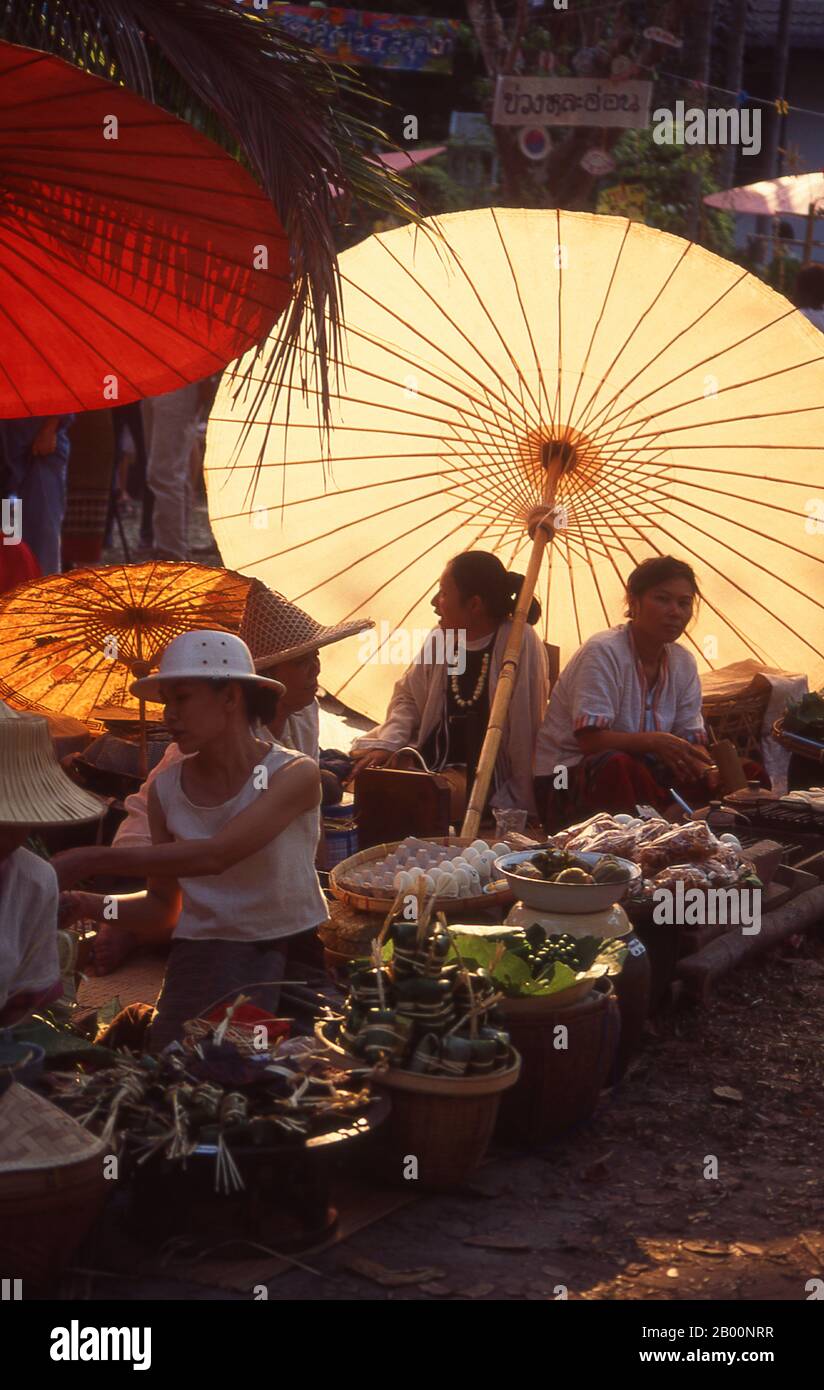 Thailand: The sun sets at a traditional northern Thai market, Chiang Mai, northern Thailand. Chiang Mai, Thailand’s ‘Rose of the North’, is the country’s second city and a popular tourist destination due primarily to its mountainous scenery, colourful ethnic hilltibes and their handicrafts. Founded in 1296 by King Mengrai as the capital of his Lanna kingdom, Chiang Mai was later overrun by Burmese invaders in 1767. The city was then left abandoned between 1776 and 1791. Chiang Mai formally became part of Siam in 1774 by an agreement with local prince Chao Kavila, after the Burmese were ousted Stock Photohttps://www.alamy.com/image-license-details/?v=1https://www.alamy.com/thailand-the-sun-sets-at-a-traditional-northern-thai-market-chiang-mai-northern-thailand-chiang-mai-thailands-rose-of-the-north-is-the-countrys-second-city-and-a-popular-tourist-destination-due-primarily-to-its-mountainous-scenery-colourful-ethnic-hilltibes-and-their-handicrafts-founded-in-1296-by-king-mengrai-as-the-capital-of-his-lanna-kingdom-chiang-mai-was-later-overrun-by-burmese-invaders-in-1767-the-city-was-then-left-abandoned-between-1776-and-1791-chiang-mai-formally-became-part-of-siam-in-1774-by-an-agreement-with-local-prince-chao-kavila-after-the-burmese-were-ousted-image344224491.html
Thailand: The sun sets at a traditional northern Thai market, Chiang Mai, northern Thailand. Chiang Mai, Thailand’s ‘Rose of the North’, is the country’s second city and a popular tourist destination due primarily to its mountainous scenery, colourful ethnic hilltibes and their handicrafts. Founded in 1296 by King Mengrai as the capital of his Lanna kingdom, Chiang Mai was later overrun by Burmese invaders in 1767. The city was then left abandoned between 1776 and 1791. Chiang Mai formally became part of Siam in 1774 by an agreement with local prince Chao Kavila, after the Burmese were ousted Stock Photohttps://www.alamy.com/image-license-details/?v=1https://www.alamy.com/thailand-the-sun-sets-at-a-traditional-northern-thai-market-chiang-mai-northern-thailand-chiang-mai-thailands-rose-of-the-north-is-the-countrys-second-city-and-a-popular-tourist-destination-due-primarily-to-its-mountainous-scenery-colourful-ethnic-hilltibes-and-their-handicrafts-founded-in-1296-by-king-mengrai-as-the-capital-of-his-lanna-kingdom-chiang-mai-was-later-overrun-by-burmese-invaders-in-1767-the-city-was-then-left-abandoned-between-1776-and-1791-chiang-mai-formally-became-part-of-siam-in-1774-by-an-agreement-with-local-prince-chao-kavila-after-the-burmese-were-ousted-image344224491.htmlRM2B00NRR–Thailand: The sun sets at a traditional northern Thai market, Chiang Mai, northern Thailand. Chiang Mai, Thailand’s ‘Rose of the North’, is the country’s second city and a popular tourist destination due primarily to its mountainous scenery, colourful ethnic hilltibes and their handicrafts. Founded in 1296 by King Mengrai as the capital of his Lanna kingdom, Chiang Mai was later overrun by Burmese invaders in 1767. The city was then left abandoned between 1776 and 1791. Chiang Mai formally became part of Siam in 1774 by an agreement with local prince Chao Kavila, after the Burmese were ousted
 Old Bangkok July-2000 (Slides Conversions) The Ayutthaya historical park covers the ruins of the old city of Ayutthaya,Thailand Stock Photohttps://www.alamy.com/image-license-details/?v=1https://www.alamy.com/stock-photo-old-bangkok-july-2000-slides-conversions-the-ayutthaya-historical-50974414.html
Old Bangkok July-2000 (Slides Conversions) The Ayutthaya historical park covers the ruins of the old city of Ayutthaya,Thailand Stock Photohttps://www.alamy.com/image-license-details/?v=1https://www.alamy.com/stock-photo-old-bangkok-july-2000-slides-conversions-the-ayutthaya-historical-50974414.htmlRMCXX2AP–Old Bangkok July-2000 (Slides Conversions) The Ayutthaya historical park covers the ruins of the old city of Ayutthaya,Thailand
 Thailand: The sun sets at a traditional northern Thai market, Chiang Mai, northern Thailand. Chiang Mai, Thailand’s ‘Rose of the North’, is the country’s second city and a popular tourist destination due primarily to its mountainous scenery, colourful ethnic hilltibes and their handicrafts. Founded in 1296 by King Mengrai as the capital of his Lanna kingdom, Chiang Mai was later overrun by Burmese invaders in 1767. The city was then left abandoned between 1776 and 1791. Chiang Mai formally became part of Siam in 1774 by an agreement with local prince Chao Kavila, after the Burmese were ousted Stock Photohttps://www.alamy.com/image-license-details/?v=1https://www.alamy.com/thailand-the-sun-sets-at-a-traditional-northern-thai-market-chiang-mai-northern-thailand-chiang-mai-thailands-rose-of-the-north-is-the-countrys-second-city-and-a-popular-tourist-destination-due-primarily-to-its-mountainous-scenery-colourful-ethnic-hilltibes-and-their-handicrafts-founded-in-1296-by-king-mengrai-as-the-capital-of-his-lanna-kingdom-chiang-mai-was-later-overrun-by-burmese-invaders-in-1767-the-city-was-then-left-abandoned-between-1776-and-1791-chiang-mai-formally-became-part-of-siam-in-1774-by-an-agreement-with-local-prince-chao-kavila-after-the-burmese-were-ousted-image344224493.html
Thailand: The sun sets at a traditional northern Thai market, Chiang Mai, northern Thailand. Chiang Mai, Thailand’s ‘Rose of the North’, is the country’s second city and a popular tourist destination due primarily to its mountainous scenery, colourful ethnic hilltibes and their handicrafts. Founded in 1296 by King Mengrai as the capital of his Lanna kingdom, Chiang Mai was later overrun by Burmese invaders in 1767. The city was then left abandoned between 1776 and 1791. Chiang Mai formally became part of Siam in 1774 by an agreement with local prince Chao Kavila, after the Burmese were ousted Stock Photohttps://www.alamy.com/image-license-details/?v=1https://www.alamy.com/thailand-the-sun-sets-at-a-traditional-northern-thai-market-chiang-mai-northern-thailand-chiang-mai-thailands-rose-of-the-north-is-the-countrys-second-city-and-a-popular-tourist-destination-due-primarily-to-its-mountainous-scenery-colourful-ethnic-hilltibes-and-their-handicrafts-founded-in-1296-by-king-mengrai-as-the-capital-of-his-lanna-kingdom-chiang-mai-was-later-overrun-by-burmese-invaders-in-1767-the-city-was-then-left-abandoned-between-1776-and-1791-chiang-mai-formally-became-part-of-siam-in-1774-by-an-agreement-with-local-prince-chao-kavila-after-the-burmese-were-ousted-image344224493.htmlRM2B00NRW–Thailand: The sun sets at a traditional northern Thai market, Chiang Mai, northern Thailand. Chiang Mai, Thailand’s ‘Rose of the North’, is the country’s second city and a popular tourist destination due primarily to its mountainous scenery, colourful ethnic hilltibes and their handicrafts. Founded in 1296 by King Mengrai as the capital of his Lanna kingdom, Chiang Mai was later overrun by Burmese invaders in 1767. The city was then left abandoned between 1776 and 1791. Chiang Mai formally became part of Siam in 1774 by an agreement with local prince Chao Kavila, after the Burmese were ousted
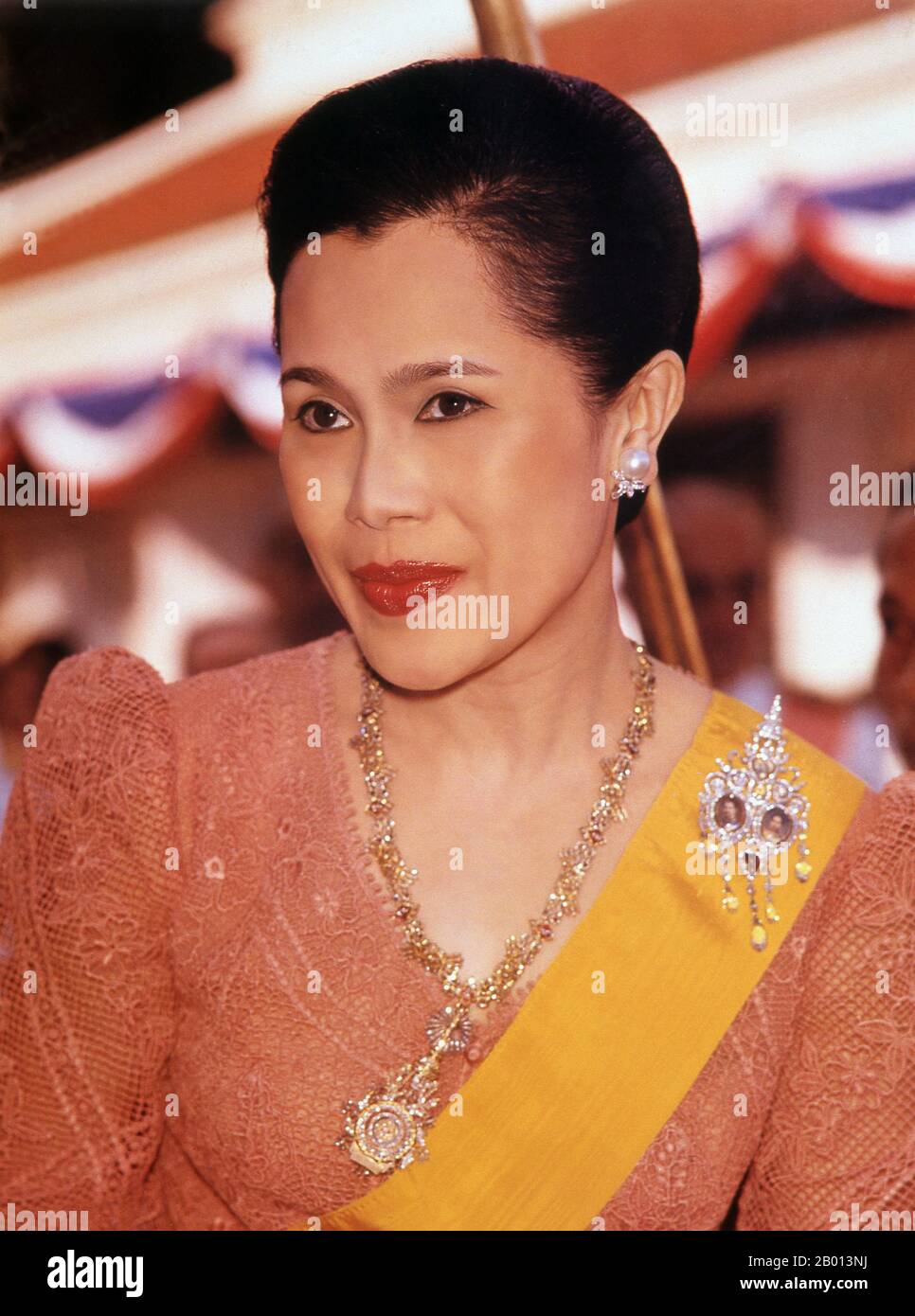 Thailand: Queen Sirikit (12th August 1932 - ), consort of Bhumibol Adulyadej (Rama IX), King of Thailand, c. 1970s. Somdet Phra Nang Chao Sirikit Phra Borommarachininat, born Mom Rajawongse Sirikit Kitiyakara on August 12, 1932), is the queen consort of Bhumibol Adulyadej, King (Rama IX) of Thailand. She is the second Queen Regent of Thailand (the first Queen Regent was Queen Saovabha Bongsri of Siam, later Queen Sri Patcharindra, the queen mother). She suffered a stroke on 21 July 2012, and has not been seen in public since. Stock Photohttps://www.alamy.com/image-license-details/?v=1https://www.alamy.com/thailand-queen-sirikit-12th-august-1932-consort-of-bhumibol-adulyadej-rama-ix-king-of-thailand-c-1970s-somdet-phra-nang-chao-sirikit-phra-borommarachininat-born-mom-rajawongse-sirikit-kitiyakara-on-august-12-1932-is-the-queen-consort-of-bhumibol-adulyadej-king-rama-ix-of-thailand-she-is-the-second-queen-regent-of-thailand-the-first-queen-regent-was-queen-saovabha-bongsri-of-siam-later-queen-sri-patcharindra-the-queen-mother-she-suffered-a-stroke-on-21-july-2012-and-has-not-been-seen-in-public-since-image344232270.html
Thailand: Queen Sirikit (12th August 1932 - ), consort of Bhumibol Adulyadej (Rama IX), King of Thailand, c. 1970s. Somdet Phra Nang Chao Sirikit Phra Borommarachininat, born Mom Rajawongse Sirikit Kitiyakara on August 12, 1932), is the queen consort of Bhumibol Adulyadej, King (Rama IX) of Thailand. She is the second Queen Regent of Thailand (the first Queen Regent was Queen Saovabha Bongsri of Siam, later Queen Sri Patcharindra, the queen mother). She suffered a stroke on 21 July 2012, and has not been seen in public since. Stock Photohttps://www.alamy.com/image-license-details/?v=1https://www.alamy.com/thailand-queen-sirikit-12th-august-1932-consort-of-bhumibol-adulyadej-rama-ix-king-of-thailand-c-1970s-somdet-phra-nang-chao-sirikit-phra-borommarachininat-born-mom-rajawongse-sirikit-kitiyakara-on-august-12-1932-is-the-queen-consort-of-bhumibol-adulyadej-king-rama-ix-of-thailand-she-is-the-second-queen-regent-of-thailand-the-first-queen-regent-was-queen-saovabha-bongsri-of-siam-later-queen-sri-patcharindra-the-queen-mother-she-suffered-a-stroke-on-21-july-2012-and-has-not-been-seen-in-public-since-image344232270.htmlRM2B013NJ–Thailand: Queen Sirikit (12th August 1932 - ), consort of Bhumibol Adulyadej (Rama IX), King of Thailand, c. 1970s. Somdet Phra Nang Chao Sirikit Phra Borommarachininat, born Mom Rajawongse Sirikit Kitiyakara on August 12, 1932), is the queen consort of Bhumibol Adulyadej, King (Rama IX) of Thailand. She is the second Queen Regent of Thailand (the first Queen Regent was Queen Saovabha Bongsri of Siam, later Queen Sri Patcharindra, the queen mother). She suffered a stroke on 21 July 2012, and has not been seen in public since.
 Old Bangkok July-2000 (Slides Conversions) The Ayutthaya historical park covers the ruins of the old city of Ayutthaya Thailand Stock Photohttps://www.alamy.com/image-license-details/?v=1https://www.alamy.com/stock-photo-old-bangkok-july-2000-slides-conversions-the-ayutthaya-historical-50974272.html
Old Bangkok July-2000 (Slides Conversions) The Ayutthaya historical park covers the ruins of the old city of Ayutthaya Thailand Stock Photohttps://www.alamy.com/image-license-details/?v=1https://www.alamy.com/stock-photo-old-bangkok-july-2000-slides-conversions-the-ayutthaya-historical-50974272.htmlRMCXX25M–Old Bangkok July-2000 (Slides Conversions) The Ayutthaya historical park covers the ruins of the old city of Ayutthaya Thailand
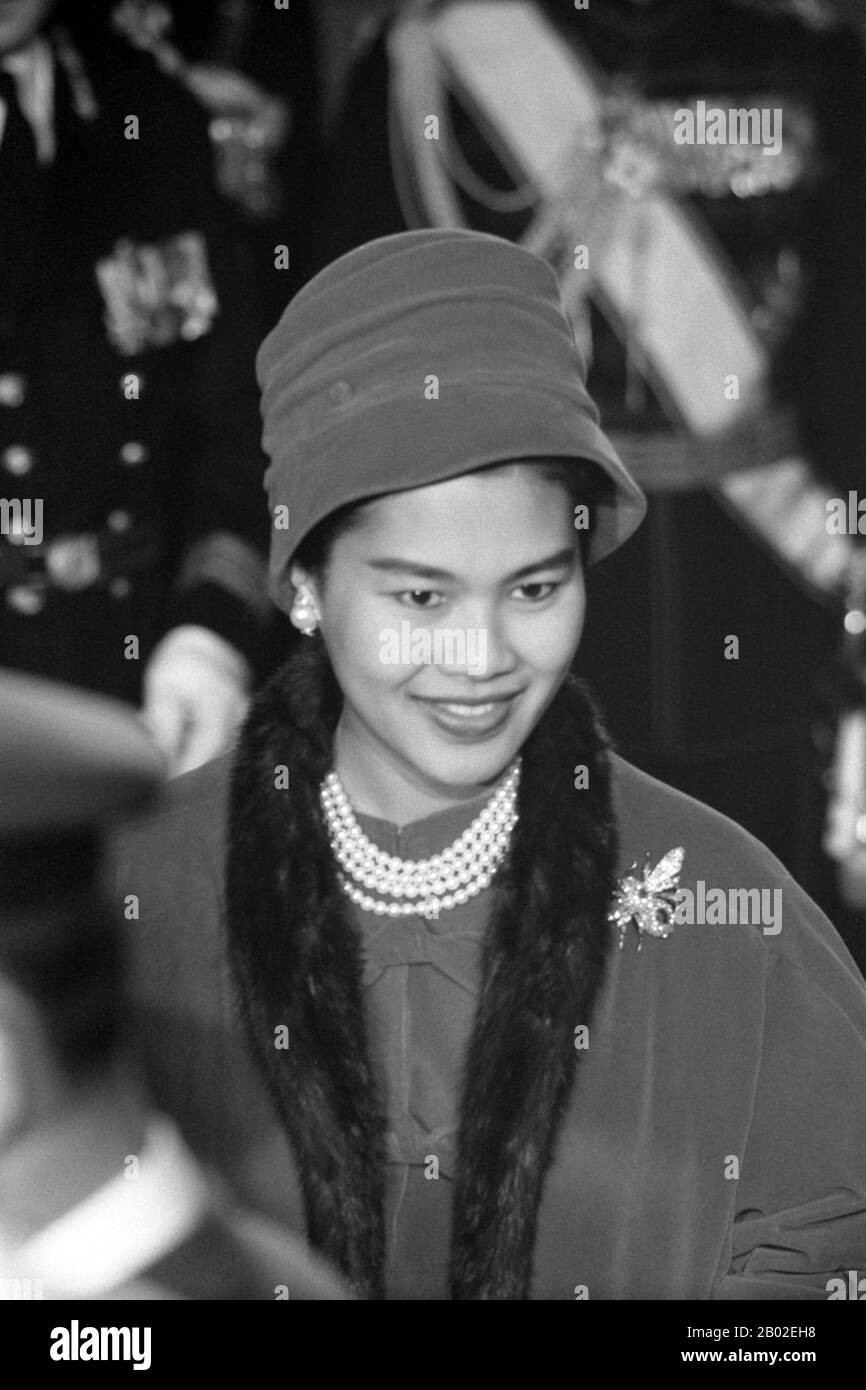 Somdet Phra Nang Chao Sirikit Phra Borommarachininat, literally: ‘Her Majesty Queen Regent Sirikit’; born Mom Rajawongse Sirikit Kitiyakara on August 12, 1932, is the queen consort of Bhumibol Adulyadej, King (Rama IX) of Thailand. She is the second Queen Regent of Thailand (the first Queen Regent was Queen Saovabha Bongsri of Siam, later Queen Sri Patcharindra, the queen mother). As the consort of the king who currently is the world's longest reigning head of state, she is also the world's longest serving consort of a monarch. Stock Photohttps://www.alamy.com/image-license-details/?v=1https://www.alamy.com/somdet-phra-nang-chao-sirikit-phra-borommarachininat-literally-her-majesty-queen-regent-sirikit-born-mom-rajawongse-sirikit-kitiyakara-on-august-12-1932-is-the-queen-consort-of-bhumibol-adulyadej-king-rama-ix-of-thailand-she-is-the-second-queen-regent-of-thailand-the-first-queen-regent-was-queen-saovabha-bongsri-of-siam-later-queen-sri-patcharindra-the-queen-mother-as-the-consort-of-the-king-who-currently-is-the-worlds-longest-reigning-head-of-state-she-is-also-the-worlds-longest-serving-consort-of-a-monarch-image344262724.html
Somdet Phra Nang Chao Sirikit Phra Borommarachininat, literally: ‘Her Majesty Queen Regent Sirikit’; born Mom Rajawongse Sirikit Kitiyakara on August 12, 1932, is the queen consort of Bhumibol Adulyadej, King (Rama IX) of Thailand. She is the second Queen Regent of Thailand (the first Queen Regent was Queen Saovabha Bongsri of Siam, later Queen Sri Patcharindra, the queen mother). As the consort of the king who currently is the world's longest reigning head of state, she is also the world's longest serving consort of a monarch. Stock Photohttps://www.alamy.com/image-license-details/?v=1https://www.alamy.com/somdet-phra-nang-chao-sirikit-phra-borommarachininat-literally-her-majesty-queen-regent-sirikit-born-mom-rajawongse-sirikit-kitiyakara-on-august-12-1932-is-the-queen-consort-of-bhumibol-adulyadej-king-rama-ix-of-thailand-she-is-the-second-queen-regent-of-thailand-the-first-queen-regent-was-queen-saovabha-bongsri-of-siam-later-queen-sri-patcharindra-the-queen-mother-as-the-consort-of-the-king-who-currently-is-the-worlds-longest-reigning-head-of-state-she-is-also-the-worlds-longest-serving-consort-of-a-monarch-image344262724.htmlRM2B02EH8–Somdet Phra Nang Chao Sirikit Phra Borommarachininat, literally: ‘Her Majesty Queen Regent Sirikit’; born Mom Rajawongse Sirikit Kitiyakara on August 12, 1932, is the queen consort of Bhumibol Adulyadej, King (Rama IX) of Thailand. She is the second Queen Regent of Thailand (the first Queen Regent was Queen Saovabha Bongsri of Siam, later Queen Sri Patcharindra, the queen mother). As the consort of the king who currently is the world's longest reigning head of state, she is also the world's longest serving consort of a monarch.
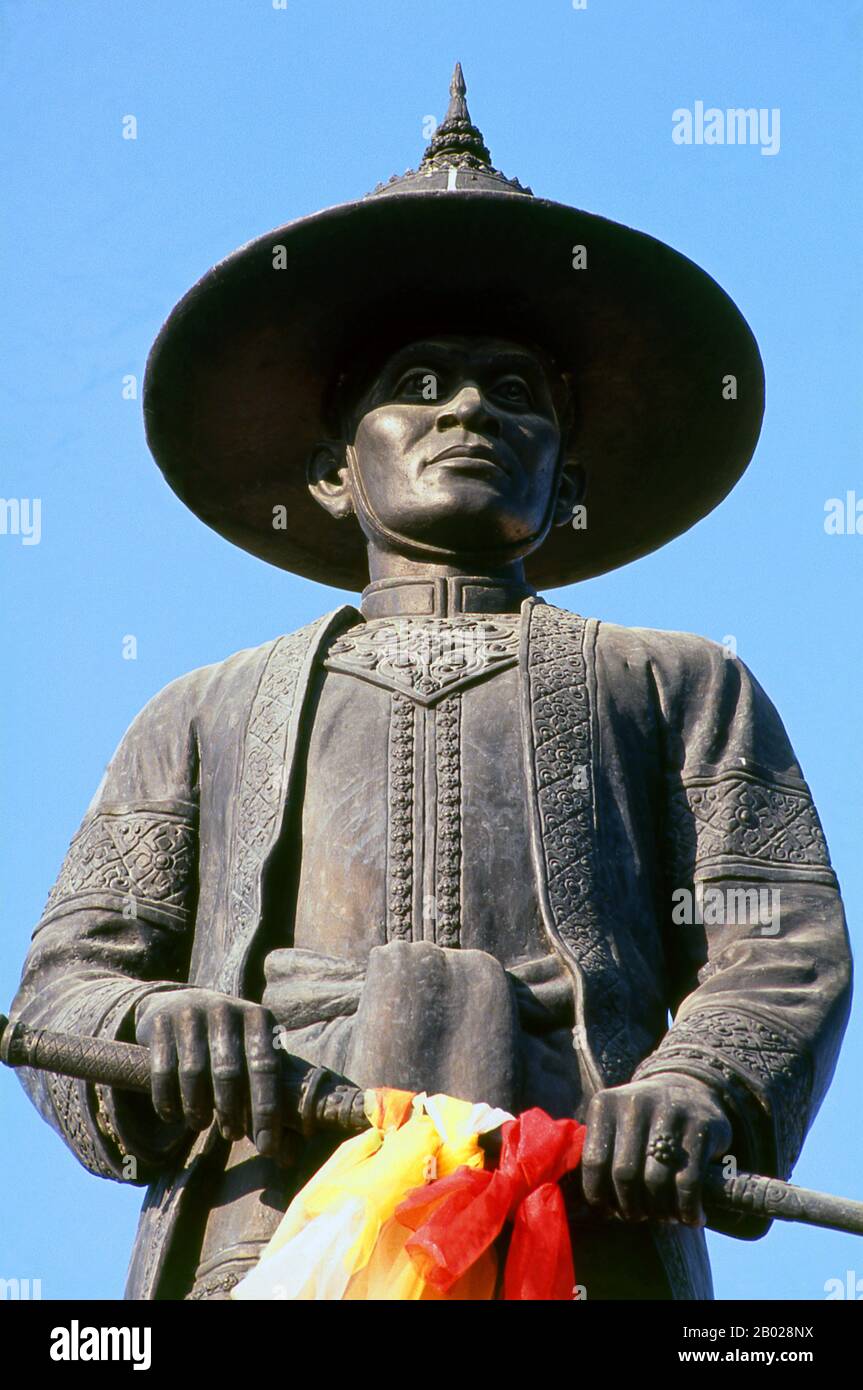 Chiang Mai formally became part of Siam in 1774 by an agreement with Chao Kavila, after the Thai King Taksin helped drive out the Burmese. Chiang Mai then slowly grew in cultural, trading and economic importance to its current status as the unofficial capital of northern Thailand, second in importance only to Bangkok. Stock Photohttps://www.alamy.com/image-license-details/?v=1https://www.alamy.com/chiang-mai-formally-became-part-of-siam-in-1774-by-an-agreement-with-chao-kavila-after-the-thai-king-taksin-helped-drive-out-the-burmese-chiang-mai-then-slowly-grew-in-cultural-trading-and-economic-importance-to-its-current-status-as-the-unofficial-capital-of-northern-thailand-second-in-importance-only-to-bangkok-image344258150.html
Chiang Mai formally became part of Siam in 1774 by an agreement with Chao Kavila, after the Thai King Taksin helped drive out the Burmese. Chiang Mai then slowly grew in cultural, trading and economic importance to its current status as the unofficial capital of northern Thailand, second in importance only to Bangkok. Stock Photohttps://www.alamy.com/image-license-details/?v=1https://www.alamy.com/chiang-mai-formally-became-part-of-siam-in-1774-by-an-agreement-with-chao-kavila-after-the-thai-king-taksin-helped-drive-out-the-burmese-chiang-mai-then-slowly-grew-in-cultural-trading-and-economic-importance-to-its-current-status-as-the-unofficial-capital-of-northern-thailand-second-in-importance-only-to-bangkok-image344258150.htmlRM2B028NX–Chiang Mai formally became part of Siam in 1774 by an agreement with Chao Kavila, after the Thai King Taksin helped drive out the Burmese. Chiang Mai then slowly grew in cultural, trading and economic importance to its current status as the unofficial capital of northern Thailand, second in importance only to Bangkok.
 Thailand: Burmese-style chedi, Wat Chetawan (Jetawan), Chiang Mai, northern Thailand. Chiang Mai is often called Thailand’s ‘Rose of the North’, and is the country’s second city and a popular tourist destination due primarily to its mountainous scenery, colourful ethnic hilltribes and their handicrafts. Founded in 1296 by King Mengrai as the capital of his Lanna kingdom, Chiang Mai was later overrun by Burmese invaders in 1767. The city was then left abandoned between 1776 and 1791. Chiang Mai formally became part of Siam in 1774. Stock Photohttps://www.alamy.com/image-license-details/?v=1https://www.alamy.com/thailand-burmese-style-chedi-wat-chetawan-jetawan-chiang-mai-northern-thailand-chiang-mai-is-often-called-thailands-rose-of-the-north-and-is-the-countrys-second-city-and-a-popular-tourist-destination-due-primarily-to-its-mountainous-scenery-colourful-ethnic-hilltribes-and-their-handicrafts-founded-in-1296-by-king-mengrai-as-the-capital-of-his-lanna-kingdom-chiang-mai-was-later-overrun-by-burmese-invaders-in-1767-the-city-was-then-left-abandoned-between-1776-and-1791-chiang-mai-formally-became-part-of-siam-in-1774-image344245095.html
Thailand: Burmese-style chedi, Wat Chetawan (Jetawan), Chiang Mai, northern Thailand. Chiang Mai is often called Thailand’s ‘Rose of the North’, and is the country’s second city and a popular tourist destination due primarily to its mountainous scenery, colourful ethnic hilltribes and their handicrafts. Founded in 1296 by King Mengrai as the capital of his Lanna kingdom, Chiang Mai was later overrun by Burmese invaders in 1767. The city was then left abandoned between 1776 and 1791. Chiang Mai formally became part of Siam in 1774. Stock Photohttps://www.alamy.com/image-license-details/?v=1https://www.alamy.com/thailand-burmese-style-chedi-wat-chetawan-jetawan-chiang-mai-northern-thailand-chiang-mai-is-often-called-thailands-rose-of-the-north-and-is-the-countrys-second-city-and-a-popular-tourist-destination-due-primarily-to-its-mountainous-scenery-colourful-ethnic-hilltribes-and-their-handicrafts-founded-in-1296-by-king-mengrai-as-the-capital-of-his-lanna-kingdom-chiang-mai-was-later-overrun-by-burmese-invaders-in-1767-the-city-was-then-left-abandoned-between-1776-and-1791-chiang-mai-formally-became-part-of-siam-in-1774-image344245095.htmlRM2B01M3K–Thailand: Burmese-style chedi, Wat Chetawan (Jetawan), Chiang Mai, northern Thailand. Chiang Mai is often called Thailand’s ‘Rose of the North’, and is the country’s second city and a popular tourist destination due primarily to its mountainous scenery, colourful ethnic hilltribes and their handicrafts. Founded in 1296 by King Mengrai as the capital of his Lanna kingdom, Chiang Mai was later overrun by Burmese invaders in 1767. The city was then left abandoned between 1776 and 1791. Chiang Mai formally became part of Siam in 1774.
 Old Bangkok July-2000 (Slides Conversions) The Ayutthaya historical park covers the ruins of the old city of Ayutthaya Thailand Stock Photohttps://www.alamy.com/image-license-details/?v=1https://www.alamy.com/stock-photo-old-bangkok-july-2000-slides-conversions-the-ayutthaya-historical-50974466.html
Old Bangkok July-2000 (Slides Conversions) The Ayutthaya historical park covers the ruins of the old city of Ayutthaya Thailand Stock Photohttps://www.alamy.com/image-license-details/?v=1https://www.alamy.com/stock-photo-old-bangkok-july-2000-slides-conversions-the-ayutthaya-historical-50974466.htmlRMCXX2CJ–Old Bangkok July-2000 (Slides Conversions) The Ayutthaya historical park covers the ruins of the old city of Ayutthaya Thailand
 Thailand: Burmese-style chedi, Wat Chetawan (Jetawan), Chiang Mai, northern Thailand. Chiang Mai is often called Thailand’s ‘Rose of the North’, and is the country’s second city and a popular tourist destination due primarily to its mountainous scenery, colourful ethnic hilltribes and their handicrafts. Founded in 1296 by King Mengrai as the capital of his Lanna kingdom, Chiang Mai was later overrun by Burmese invaders in 1767. The city was then left abandoned between 1776 and 1791. Chiang Mai formally became part of Siam in 1774. Stock Photohttps://www.alamy.com/image-license-details/?v=1https://www.alamy.com/thailand-burmese-style-chedi-wat-chetawan-jetawan-chiang-mai-northern-thailand-chiang-mai-is-often-called-thailands-rose-of-the-north-and-is-the-countrys-second-city-and-a-popular-tourist-destination-due-primarily-to-its-mountainous-scenery-colourful-ethnic-hilltribes-and-their-handicrafts-founded-in-1296-by-king-mengrai-as-the-capital-of-his-lanna-kingdom-chiang-mai-was-later-overrun-by-burmese-invaders-in-1767-the-city-was-then-left-abandoned-between-1776-and-1791-chiang-mai-formally-became-part-of-siam-in-1774-image344245091.html
Thailand: Burmese-style chedi, Wat Chetawan (Jetawan), Chiang Mai, northern Thailand. Chiang Mai is often called Thailand’s ‘Rose of the North’, and is the country’s second city and a popular tourist destination due primarily to its mountainous scenery, colourful ethnic hilltribes and their handicrafts. Founded in 1296 by King Mengrai as the capital of his Lanna kingdom, Chiang Mai was later overrun by Burmese invaders in 1767. The city was then left abandoned between 1776 and 1791. Chiang Mai formally became part of Siam in 1774. Stock Photohttps://www.alamy.com/image-license-details/?v=1https://www.alamy.com/thailand-burmese-style-chedi-wat-chetawan-jetawan-chiang-mai-northern-thailand-chiang-mai-is-often-called-thailands-rose-of-the-north-and-is-the-countrys-second-city-and-a-popular-tourist-destination-due-primarily-to-its-mountainous-scenery-colourful-ethnic-hilltribes-and-their-handicrafts-founded-in-1296-by-king-mengrai-as-the-capital-of-his-lanna-kingdom-chiang-mai-was-later-overrun-by-burmese-invaders-in-1767-the-city-was-then-left-abandoned-between-1776-and-1791-chiang-mai-formally-became-part-of-siam-in-1774-image344245091.htmlRM2B01M3F–Thailand: Burmese-style chedi, Wat Chetawan (Jetawan), Chiang Mai, northern Thailand. Chiang Mai is often called Thailand’s ‘Rose of the North’, and is the country’s second city and a popular tourist destination due primarily to its mountainous scenery, colourful ethnic hilltribes and their handicrafts. Founded in 1296 by King Mengrai as the capital of his Lanna kingdom, Chiang Mai was later overrun by Burmese invaders in 1767. The city was then left abandoned between 1776 and 1791. Chiang Mai formally became part of Siam in 1774.
 Old Bangkok July-2000 (Slides Conversions) The Ayutthaya historical park covers the ruins of the old city of Ayutthaya Thailand Stock Photohttps://www.alamy.com/image-license-details/?v=1https://www.alamy.com/stock-photo-old-bangkok-july-2000-slides-conversions-the-ayutthaya-historical-50973592.html
Old Bangkok July-2000 (Slides Conversions) The Ayutthaya historical park covers the ruins of the old city of Ayutthaya Thailand Stock Photohttps://www.alamy.com/image-license-details/?v=1https://www.alamy.com/stock-photo-old-bangkok-july-2000-slides-conversions-the-ayutthaya-historical-50973592.htmlRMCXX19C–Old Bangkok July-2000 (Slides Conversions) The Ayutthaya historical park covers the ruins of the old city of Ayutthaya Thailand
 Thailand: Burmese-style chedi, Wat Chetawan (Jetawan), Chiang Mai, northern Thailand. Chiang Mai is often called Thailand’s ‘Rose of the North’, and is the country’s second city and a popular tourist destination due primarily to its mountainous scenery, colourful ethnic hilltribes and their handicrafts. Founded in 1296 by King Mengrai as the capital of his Lanna kingdom, Chiang Mai was later overrun by Burmese invaders in 1767. The city was then left abandoned between 1776 and 1791. Chiang Mai formally became part of Siam in 1774. Stock Photohttps://www.alamy.com/image-license-details/?v=1https://www.alamy.com/thailand-burmese-style-chedi-wat-chetawan-jetawan-chiang-mai-northern-thailand-chiang-mai-is-often-called-thailands-rose-of-the-north-and-is-the-countrys-second-city-and-a-popular-tourist-destination-due-primarily-to-its-mountainous-scenery-colourful-ethnic-hilltribes-and-their-handicrafts-founded-in-1296-by-king-mengrai-as-the-capital-of-his-lanna-kingdom-chiang-mai-was-later-overrun-by-burmese-invaders-in-1767-the-city-was-then-left-abandoned-between-1776-and-1791-chiang-mai-formally-became-part-of-siam-in-1774-image344245092.html
Thailand: Burmese-style chedi, Wat Chetawan (Jetawan), Chiang Mai, northern Thailand. Chiang Mai is often called Thailand’s ‘Rose of the North’, and is the country’s second city and a popular tourist destination due primarily to its mountainous scenery, colourful ethnic hilltribes and their handicrafts. Founded in 1296 by King Mengrai as the capital of his Lanna kingdom, Chiang Mai was later overrun by Burmese invaders in 1767. The city was then left abandoned between 1776 and 1791. Chiang Mai formally became part of Siam in 1774. Stock Photohttps://www.alamy.com/image-license-details/?v=1https://www.alamy.com/thailand-burmese-style-chedi-wat-chetawan-jetawan-chiang-mai-northern-thailand-chiang-mai-is-often-called-thailands-rose-of-the-north-and-is-the-countrys-second-city-and-a-popular-tourist-destination-due-primarily-to-its-mountainous-scenery-colourful-ethnic-hilltribes-and-their-handicrafts-founded-in-1296-by-king-mengrai-as-the-capital-of-his-lanna-kingdom-chiang-mai-was-later-overrun-by-burmese-invaders-in-1767-the-city-was-then-left-abandoned-between-1776-and-1791-chiang-mai-formally-became-part-of-siam-in-1774-image344245092.htmlRM2B01M3G–Thailand: Burmese-style chedi, Wat Chetawan (Jetawan), Chiang Mai, northern Thailand. Chiang Mai is often called Thailand’s ‘Rose of the North’, and is the country’s second city and a popular tourist destination due primarily to its mountainous scenery, colourful ethnic hilltribes and their handicrafts. Founded in 1296 by King Mengrai as the capital of his Lanna kingdom, Chiang Mai was later overrun by Burmese invaders in 1767. The city was then left abandoned between 1776 and 1791. Chiang Mai formally became part of Siam in 1774.
 Thailand: Boats on the Ping River at Chiang Mai. Chiang Mai is often called Thailand’s ‘Rose of the North’, and is the country’s second city and a popular tourist destination due primarily to its mountainous scenery, colourful ethnic hilltribes and their handicrafts. Founded in 1296 by King Mengrai as the capital of his Lanna kingdom, Chiang Mai was later overrun by Burmese invaders in 1767. The city was then left abandoned between 1776 and 1791. Chiang Mai formally became part of Siam in 1774 by an agreement with local prince Chao Kavila. Stock Photohttps://www.alamy.com/image-license-details/?v=1https://www.alamy.com/thailand-boats-on-the-ping-river-at-chiang-mai-chiang-mai-is-often-called-thailands-rose-of-the-north-and-is-the-countrys-second-city-and-a-popular-tourist-destination-due-primarily-to-its-mountainous-scenery-colourful-ethnic-hilltribes-and-their-handicrafts-founded-in-1296-by-king-mengrai-as-the-capital-of-his-lanna-kingdom-chiang-mai-was-later-overrun-by-burmese-invaders-in-1767-the-city-was-then-left-abandoned-between-1776-and-1791-chiang-mai-formally-became-part-of-siam-in-1774-by-an-agreement-with-local-prince-chao-kavila-image344224507.html
Thailand: Boats on the Ping River at Chiang Mai. Chiang Mai is often called Thailand’s ‘Rose of the North’, and is the country’s second city and a popular tourist destination due primarily to its mountainous scenery, colourful ethnic hilltribes and their handicrafts. Founded in 1296 by King Mengrai as the capital of his Lanna kingdom, Chiang Mai was later overrun by Burmese invaders in 1767. The city was then left abandoned between 1776 and 1791. Chiang Mai formally became part of Siam in 1774 by an agreement with local prince Chao Kavila. Stock Photohttps://www.alamy.com/image-license-details/?v=1https://www.alamy.com/thailand-boats-on-the-ping-river-at-chiang-mai-chiang-mai-is-often-called-thailands-rose-of-the-north-and-is-the-countrys-second-city-and-a-popular-tourist-destination-due-primarily-to-its-mountainous-scenery-colourful-ethnic-hilltribes-and-their-handicrafts-founded-in-1296-by-king-mengrai-as-the-capital-of-his-lanna-kingdom-chiang-mai-was-later-overrun-by-burmese-invaders-in-1767-the-city-was-then-left-abandoned-between-1776-and-1791-chiang-mai-formally-became-part-of-siam-in-1774-by-an-agreement-with-local-prince-chao-kavila-image344224507.htmlRM2B00NTB–Thailand: Boats on the Ping River at Chiang Mai. Chiang Mai is often called Thailand’s ‘Rose of the North’, and is the country’s second city and a popular tourist destination due primarily to its mountainous scenery, colourful ethnic hilltribes and their handicrafts. Founded in 1296 by King Mengrai as the capital of his Lanna kingdom, Chiang Mai was later overrun by Burmese invaders in 1767. The city was then left abandoned between 1776 and 1791. Chiang Mai formally became part of Siam in 1774 by an agreement with local prince Chao Kavila.
 Thailand: The old chedi at Wat Yang Kuang before renovation, Suriyawong Road, Chiang Mai, northern Thailand. Chiang Mai is often called Thailand’s ‘Rose of the North’, and is the country’s second city and a popular tourist destination due primarily to its mountainous scenery, colourful ethnic hilltribes and their handicrafts. Founded in 1296 by King Mengrai as the capital of his Lanna kingdom, Chiang Mai was later overrun by Burmese invaders in 1767. The city was then left abandoned between 1776 and 1791. Chiang Mai formally became part of Siam in 1774. Stock Photohttps://www.alamy.com/image-license-details/?v=1https://www.alamy.com/thailand-the-old-chedi-at-wat-yang-kuang-before-renovation-suriyawong-road-chiang-mai-northern-thailand-chiang-mai-is-often-called-thailands-rose-of-the-north-and-is-the-countrys-second-city-and-a-popular-tourist-destination-due-primarily-to-its-mountainous-scenery-colourful-ethnic-hilltribes-and-their-handicrafts-founded-in-1296-by-king-mengrai-as-the-capital-of-his-lanna-kingdom-chiang-mai-was-later-overrun-by-burmese-invaders-in-1767-the-city-was-then-left-abandoned-between-1776-and-1791-chiang-mai-formally-became-part-of-siam-in-1774-image344249847.html
Thailand: The old chedi at Wat Yang Kuang before renovation, Suriyawong Road, Chiang Mai, northern Thailand. Chiang Mai is often called Thailand’s ‘Rose of the North’, and is the country’s second city and a popular tourist destination due primarily to its mountainous scenery, colourful ethnic hilltribes and their handicrafts. Founded in 1296 by King Mengrai as the capital of his Lanna kingdom, Chiang Mai was later overrun by Burmese invaders in 1767. The city was then left abandoned between 1776 and 1791. Chiang Mai formally became part of Siam in 1774. Stock Photohttps://www.alamy.com/image-license-details/?v=1https://www.alamy.com/thailand-the-old-chedi-at-wat-yang-kuang-before-renovation-suriyawong-road-chiang-mai-northern-thailand-chiang-mai-is-often-called-thailands-rose-of-the-north-and-is-the-countrys-second-city-and-a-popular-tourist-destination-due-primarily-to-its-mountainous-scenery-colourful-ethnic-hilltribes-and-their-handicrafts-founded-in-1296-by-king-mengrai-as-the-capital-of-his-lanna-kingdom-chiang-mai-was-later-overrun-by-burmese-invaders-in-1767-the-city-was-then-left-abandoned-between-1776-and-1791-chiang-mai-formally-became-part-of-siam-in-1774-image344249847.htmlRM2B01X5B–Thailand: The old chedi at Wat Yang Kuang before renovation, Suriyawong Road, Chiang Mai, northern Thailand. Chiang Mai is often called Thailand’s ‘Rose of the North’, and is the country’s second city and a popular tourist destination due primarily to its mountainous scenery, colourful ethnic hilltribes and their handicrafts. Founded in 1296 by King Mengrai as the capital of his Lanna kingdom, Chiang Mai was later overrun by Burmese invaders in 1767. The city was then left abandoned between 1776 and 1791. Chiang Mai formally became part of Siam in 1774.
 Old Bangkok July-2000 (Digital Slide Conversion) Reclining,lying down,Buddha in Wat Phoo Bangkok Temple,Thailand Stock Photohttps://www.alamy.com/image-license-details/?v=1https://www.alamy.com/stock-photo-old-bangkok-july-2000-digital-slide-conversion-reclininglying-downbuddha-50974211.html
Old Bangkok July-2000 (Digital Slide Conversion) Reclining,lying down,Buddha in Wat Phoo Bangkok Temple,Thailand Stock Photohttps://www.alamy.com/image-license-details/?v=1https://www.alamy.com/stock-photo-old-bangkok-july-2000-digital-slide-conversion-reclininglying-downbuddha-50974211.htmlRMCXX23F–Old Bangkok July-2000 (Digital Slide Conversion) Reclining,lying down,Buddha in Wat Phoo Bangkok Temple,Thailand
 Thailand: The old chedi at Wat Yang Kuang before renovation, Suriyawong Road, Chiang Mai, northern Thailand. Chiang Mai is often called Thailand’s ‘Rose of the North’, and is the country’s second city and a popular tourist destination due primarily to its mountainous scenery, colourful ethnic hilltribes and their handicrafts. Founded in 1296 by King Mengrai as the capital of his Lanna kingdom, Chiang Mai was later overrun by Burmese invaders in 1767. The city was then left abandoned between 1776 and 1791. Chiang Mai formally became part of Siam in 1774. Stock Photohttps://www.alamy.com/image-license-details/?v=1https://www.alamy.com/thailand-the-old-chedi-at-wat-yang-kuang-before-renovation-suriyawong-road-chiang-mai-northern-thailand-chiang-mai-is-often-called-thailands-rose-of-the-north-and-is-the-countrys-second-city-and-a-popular-tourist-destination-due-primarily-to-its-mountainous-scenery-colourful-ethnic-hilltribes-and-their-handicrafts-founded-in-1296-by-king-mengrai-as-the-capital-of-his-lanna-kingdom-chiang-mai-was-later-overrun-by-burmese-invaders-in-1767-the-city-was-then-left-abandoned-between-1776-and-1791-chiang-mai-formally-became-part-of-siam-in-1774-image344249843.html
Thailand: The old chedi at Wat Yang Kuang before renovation, Suriyawong Road, Chiang Mai, northern Thailand. Chiang Mai is often called Thailand’s ‘Rose of the North’, and is the country’s second city and a popular tourist destination due primarily to its mountainous scenery, colourful ethnic hilltribes and their handicrafts. Founded in 1296 by King Mengrai as the capital of his Lanna kingdom, Chiang Mai was later overrun by Burmese invaders in 1767. The city was then left abandoned between 1776 and 1791. Chiang Mai formally became part of Siam in 1774. Stock Photohttps://www.alamy.com/image-license-details/?v=1https://www.alamy.com/thailand-the-old-chedi-at-wat-yang-kuang-before-renovation-suriyawong-road-chiang-mai-northern-thailand-chiang-mai-is-often-called-thailands-rose-of-the-north-and-is-the-countrys-second-city-and-a-popular-tourist-destination-due-primarily-to-its-mountainous-scenery-colourful-ethnic-hilltribes-and-their-handicrafts-founded-in-1296-by-king-mengrai-as-the-capital-of-his-lanna-kingdom-chiang-mai-was-later-overrun-by-burmese-invaders-in-1767-the-city-was-then-left-abandoned-between-1776-and-1791-chiang-mai-formally-became-part-of-siam-in-1774-image344249843.htmlRM2B01X57–Thailand: The old chedi at Wat Yang Kuang before renovation, Suriyawong Road, Chiang Mai, northern Thailand. Chiang Mai is often called Thailand’s ‘Rose of the North’, and is the country’s second city and a popular tourist destination due primarily to its mountainous scenery, colourful ethnic hilltribes and their handicrafts. Founded in 1296 by King Mengrai as the capital of his Lanna kingdom, Chiang Mai was later overrun by Burmese invaders in 1767. The city was then left abandoned between 1776 and 1791. Chiang Mai formally became part of Siam in 1774.
 Old Bangkok July-2000 (Slides Conversions) The Ayutthaya historical park covers the ruins of the old city of Ayutthaya, Thailand Stock Photohttps://www.alamy.com/image-license-details/?v=1https://www.alamy.com/stock-photo-old-bangkok-july-2000-slides-conversions-the-ayutthaya-historical-50974506.html
Old Bangkok July-2000 (Slides Conversions) The Ayutthaya historical park covers the ruins of the old city of Ayutthaya, Thailand Stock Photohttps://www.alamy.com/image-license-details/?v=1https://www.alamy.com/stock-photo-old-bangkok-july-2000-slides-conversions-the-ayutthaya-historical-50974506.htmlRMCXX2E2–Old Bangkok July-2000 (Slides Conversions) The Ayutthaya historical park covers the ruins of the old city of Ayutthaya, Thailand
 Thailand: The old chedi at Wat Yang Kuang before renovation, Suriyawong Road, Chiang Mai, northern Thailand. Chiang Mai is often called Thailand’s ‘Rose of the North’, and is the country’s second city and a popular tourist destination due primarily to its mountainous scenery, colourful ethnic hilltribes and their handicrafts. Founded in 1296 by King Mengrai as the capital of his Lanna kingdom, Chiang Mai was later overrun by Burmese invaders in 1767. The city was then left abandoned between 1776 and 1791. Chiang Mai formally became part of Siam in 1774. Stock Photohttps://www.alamy.com/image-license-details/?v=1https://www.alamy.com/thailand-the-old-chedi-at-wat-yang-kuang-before-renovation-suriyawong-road-chiang-mai-northern-thailand-chiang-mai-is-often-called-thailands-rose-of-the-north-and-is-the-countrys-second-city-and-a-popular-tourist-destination-due-primarily-to-its-mountainous-scenery-colourful-ethnic-hilltribes-and-their-handicrafts-founded-in-1296-by-king-mengrai-as-the-capital-of-his-lanna-kingdom-chiang-mai-was-later-overrun-by-burmese-invaders-in-1767-the-city-was-then-left-abandoned-between-1776-and-1791-chiang-mai-formally-became-part-of-siam-in-1774-image344249844.html
Thailand: The old chedi at Wat Yang Kuang before renovation, Suriyawong Road, Chiang Mai, northern Thailand. Chiang Mai is often called Thailand’s ‘Rose of the North’, and is the country’s second city and a popular tourist destination due primarily to its mountainous scenery, colourful ethnic hilltribes and their handicrafts. Founded in 1296 by King Mengrai as the capital of his Lanna kingdom, Chiang Mai was later overrun by Burmese invaders in 1767. The city was then left abandoned between 1776 and 1791. Chiang Mai formally became part of Siam in 1774. Stock Photohttps://www.alamy.com/image-license-details/?v=1https://www.alamy.com/thailand-the-old-chedi-at-wat-yang-kuang-before-renovation-suriyawong-road-chiang-mai-northern-thailand-chiang-mai-is-often-called-thailands-rose-of-the-north-and-is-the-countrys-second-city-and-a-popular-tourist-destination-due-primarily-to-its-mountainous-scenery-colourful-ethnic-hilltribes-and-their-handicrafts-founded-in-1296-by-king-mengrai-as-the-capital-of-his-lanna-kingdom-chiang-mai-was-later-overrun-by-burmese-invaders-in-1767-the-city-was-then-left-abandoned-between-1776-and-1791-chiang-mai-formally-became-part-of-siam-in-1774-image344249844.htmlRM2B01X58–Thailand: The old chedi at Wat Yang Kuang before renovation, Suriyawong Road, Chiang Mai, northern Thailand. Chiang Mai is often called Thailand’s ‘Rose of the North’, and is the country’s second city and a popular tourist destination due primarily to its mountainous scenery, colourful ethnic hilltribes and their handicrafts. Founded in 1296 by King Mengrai as the capital of his Lanna kingdom, Chiang Mai was later overrun by Burmese invaders in 1767. The city was then left abandoned between 1776 and 1791. Chiang Mai formally became part of Siam in 1774.
 Old Bangkok July-2000 (Digital Slide Conversion) Reclining,lying down,Buddha in Wat Phoo Bangkok Temple,Thailand Stock Photohttps://www.alamy.com/image-license-details/?v=1https://www.alamy.com/stock-photo-old-bangkok-july-2000-digital-slide-conversion-reclininglying-downbuddha-50974183.html
Old Bangkok July-2000 (Digital Slide Conversion) Reclining,lying down,Buddha in Wat Phoo Bangkok Temple,Thailand Stock Photohttps://www.alamy.com/image-license-details/?v=1https://www.alamy.com/stock-photo-old-bangkok-july-2000-digital-slide-conversion-reclininglying-downbuddha-50974183.htmlRMCXX22F–Old Bangkok July-2000 (Digital Slide Conversion) Reclining,lying down,Buddha in Wat Phoo Bangkok Temple,Thailand
 Thailand: The main Buddha at Wat Yang Kuang before renovation, Suriyawong Road, Chiang Mai, northern Thailand. Chiang Mai is often called Thailand’s ‘Rose of the North’, and is the country’s second city and a popular tourist destination due primarily to its mountainous scenery, colourful ethnic hilltribes and their handicrafts. Founded in 1296 by King Mengrai as the capital of his Lanna kingdom, Chiang Mai was later overrun by Burmese invaders in 1767. The city was then left abandoned between 1776 and 1791. Chiang Mai formally became part of Siam in 1774. Stock Photohttps://www.alamy.com/image-license-details/?v=1https://www.alamy.com/thailand-the-main-buddha-at-wat-yang-kuang-before-renovation-suriyawong-road-chiang-mai-northern-thailand-chiang-mai-is-often-called-thailands-rose-of-the-north-and-is-the-countrys-second-city-and-a-popular-tourist-destination-due-primarily-to-its-mountainous-scenery-colourful-ethnic-hilltribes-and-their-handicrafts-founded-in-1296-by-king-mengrai-as-the-capital-of-his-lanna-kingdom-chiang-mai-was-later-overrun-by-burmese-invaders-in-1767-the-city-was-then-left-abandoned-between-1776-and-1791-chiang-mai-formally-became-part-of-siam-in-1774-image344249846.html
Thailand: The main Buddha at Wat Yang Kuang before renovation, Suriyawong Road, Chiang Mai, northern Thailand. Chiang Mai is often called Thailand’s ‘Rose of the North’, and is the country’s second city and a popular tourist destination due primarily to its mountainous scenery, colourful ethnic hilltribes and their handicrafts. Founded in 1296 by King Mengrai as the capital of his Lanna kingdom, Chiang Mai was later overrun by Burmese invaders in 1767. The city was then left abandoned between 1776 and 1791. Chiang Mai formally became part of Siam in 1774. Stock Photohttps://www.alamy.com/image-license-details/?v=1https://www.alamy.com/thailand-the-main-buddha-at-wat-yang-kuang-before-renovation-suriyawong-road-chiang-mai-northern-thailand-chiang-mai-is-often-called-thailands-rose-of-the-north-and-is-the-countrys-second-city-and-a-popular-tourist-destination-due-primarily-to-its-mountainous-scenery-colourful-ethnic-hilltribes-and-their-handicrafts-founded-in-1296-by-king-mengrai-as-the-capital-of-his-lanna-kingdom-chiang-mai-was-later-overrun-by-burmese-invaders-in-1767-the-city-was-then-left-abandoned-between-1776-and-1791-chiang-mai-formally-became-part-of-siam-in-1774-image344249846.htmlRM2B01X5A–Thailand: The main Buddha at Wat Yang Kuang before renovation, Suriyawong Road, Chiang Mai, northern Thailand. Chiang Mai is often called Thailand’s ‘Rose of the North’, and is the country’s second city and a popular tourist destination due primarily to its mountainous scenery, colourful ethnic hilltribes and their handicrafts. Founded in 1296 by King Mengrai as the capital of his Lanna kingdom, Chiang Mai was later overrun by Burmese invaders in 1767. The city was then left abandoned between 1776 and 1791. Chiang Mai formally became part of Siam in 1774.
 Thailand: Half human mythical figure on the main chedi at Wat Chetawan (Jetawan), Chiang Mai, northern Thailand. Chiang Mai is often called Thailand’s ‘Rose of the North’, and is the country’s second city and a popular tourist destination due primarily to its mountainous scenery, colourful ethnic hilltribes and their handicrafts. Founded in 1296 by King Mengrai as the capital of his Lanna kingdom, Chiang Mai was later overrun by Burmese invaders in 1767. The city was then left abandoned between 1776 and 1791. Chiang Mai formally became part of Siam in 1774. Stock Photohttps://www.alamy.com/image-license-details/?v=1https://www.alamy.com/thailand-half-human-mythical-figure-on-the-main-chedi-at-wat-chetawan-jetawan-chiang-mai-northern-thailand-chiang-mai-is-often-called-thailands-rose-of-the-north-and-is-the-countrys-second-city-and-a-popular-tourist-destination-due-primarily-to-its-mountainous-scenery-colourful-ethnic-hilltribes-and-their-handicrafts-founded-in-1296-by-king-mengrai-as-the-capital-of-his-lanna-kingdom-chiang-mai-was-later-overrun-by-burmese-invaders-in-1767-the-city-was-then-left-abandoned-between-1776-and-1791-chiang-mai-formally-became-part-of-siam-in-1774-image344245101.html
Thailand: Half human mythical figure on the main chedi at Wat Chetawan (Jetawan), Chiang Mai, northern Thailand. Chiang Mai is often called Thailand’s ‘Rose of the North’, and is the country’s second city and a popular tourist destination due primarily to its mountainous scenery, colourful ethnic hilltribes and their handicrafts. Founded in 1296 by King Mengrai as the capital of his Lanna kingdom, Chiang Mai was later overrun by Burmese invaders in 1767. The city was then left abandoned between 1776 and 1791. Chiang Mai formally became part of Siam in 1774. Stock Photohttps://www.alamy.com/image-license-details/?v=1https://www.alamy.com/thailand-half-human-mythical-figure-on-the-main-chedi-at-wat-chetawan-jetawan-chiang-mai-northern-thailand-chiang-mai-is-often-called-thailands-rose-of-the-north-and-is-the-countrys-second-city-and-a-popular-tourist-destination-due-primarily-to-its-mountainous-scenery-colourful-ethnic-hilltribes-and-their-handicrafts-founded-in-1296-by-king-mengrai-as-the-capital-of-his-lanna-kingdom-chiang-mai-was-later-overrun-by-burmese-invaders-in-1767-the-city-was-then-left-abandoned-between-1776-and-1791-chiang-mai-formally-became-part-of-siam-in-1774-image344245101.htmlRM2B01M3W–Thailand: Half human mythical figure on the main chedi at Wat Chetawan (Jetawan), Chiang Mai, northern Thailand. Chiang Mai is often called Thailand’s ‘Rose of the North’, and is the country’s second city and a popular tourist destination due primarily to its mountainous scenery, colourful ethnic hilltribes and their handicrafts. Founded in 1296 by King Mengrai as the capital of his Lanna kingdom, Chiang Mai was later overrun by Burmese invaders in 1767. The city was then left abandoned between 1776 and 1791. Chiang Mai formally became part of Siam in 1774.
 Thailand: Ethnic handicrafts and jewellery for sale at the Sunday Walking Street market in Chiang Mai, northern Thailand. Chiang Mai is often called Thailand’s ‘Rose of the North’, and is the country’s second city and a popular tourist destination due primarily to its mountainous scenery, colourful ethnic hilltribes and their handicrafts. Founded in 1296 by King Mengrai as the capital of his Lanna kingdom, Chiang Mai was later overrun by Burmese invaders in 1767. The city was then left abandoned between 1776 and 1791. Chiang Mai formally became part of Siam in 1774. Stock Photohttps://www.alamy.com/image-license-details/?v=1https://www.alamy.com/thailand-ethnic-handicrafts-and-jewellery-for-sale-at-the-sunday-walking-street-market-in-chiang-mai-northern-thailand-chiang-mai-is-often-called-thailands-rose-of-the-north-and-is-the-countrys-second-city-and-a-popular-tourist-destination-due-primarily-to-its-mountainous-scenery-colourful-ethnic-hilltribes-and-their-handicrafts-founded-in-1296-by-king-mengrai-as-the-capital-of-his-lanna-kingdom-chiang-mai-was-later-overrun-by-burmese-invaders-in-1767-the-city-was-then-left-abandoned-between-1776-and-1791-chiang-mai-formally-became-part-of-siam-in-1774-image344224496.html
Thailand: Ethnic handicrafts and jewellery for sale at the Sunday Walking Street market in Chiang Mai, northern Thailand. Chiang Mai is often called Thailand’s ‘Rose of the North’, and is the country’s second city and a popular tourist destination due primarily to its mountainous scenery, colourful ethnic hilltribes and their handicrafts. Founded in 1296 by King Mengrai as the capital of his Lanna kingdom, Chiang Mai was later overrun by Burmese invaders in 1767. The city was then left abandoned between 1776 and 1791. Chiang Mai formally became part of Siam in 1774. Stock Photohttps://www.alamy.com/image-license-details/?v=1https://www.alamy.com/thailand-ethnic-handicrafts-and-jewellery-for-sale-at-the-sunday-walking-street-market-in-chiang-mai-northern-thailand-chiang-mai-is-often-called-thailands-rose-of-the-north-and-is-the-countrys-second-city-and-a-popular-tourist-destination-due-primarily-to-its-mountainous-scenery-colourful-ethnic-hilltribes-and-their-handicrafts-founded-in-1296-by-king-mengrai-as-the-capital-of-his-lanna-kingdom-chiang-mai-was-later-overrun-by-burmese-invaders-in-1767-the-city-was-then-left-abandoned-between-1776-and-1791-chiang-mai-formally-became-part-of-siam-in-1774-image344224496.htmlRM2B00NT0–Thailand: Ethnic handicrafts and jewellery for sale at the Sunday Walking Street market in Chiang Mai, northern Thailand. Chiang Mai is often called Thailand’s ‘Rose of the North’, and is the country’s second city and a popular tourist destination due primarily to its mountainous scenery, colourful ethnic hilltribes and their handicrafts. Founded in 1296 by King Mengrai as the capital of his Lanna kingdom, Chiang Mai was later overrun by Burmese invaders in 1767. The city was then left abandoned between 1776 and 1791. Chiang Mai formally became part of Siam in 1774.
 Thailand: Spirit houses at Wat Yang Kuang before renovation, Suriyawong Road, Chiang Mai, northern Thailand. Chiang Mai is often called Thailand’s ‘Rose of the North’, and is the country’s second city and a popular tourist destination due primarily to its mountainous scenery, colourful ethnic hilltribes and their handicrafts. Founded in 1296 by King Mengrai as the capital of his Lanna kingdom, Chiang Mai was later overrun by Burmese invaders in 1767. The city was then left abandoned between 1776 and 1791. Chiang Mai formally became part of Siam in 1774 by an agreement. Stock Photohttps://www.alamy.com/image-license-details/?v=1https://www.alamy.com/thailand-spirit-houses-at-wat-yang-kuang-before-renovation-suriyawong-road-chiang-mai-northern-thailand-chiang-mai-is-often-called-thailands-rose-of-the-north-and-is-the-countrys-second-city-and-a-popular-tourist-destination-due-primarily-to-its-mountainous-scenery-colourful-ethnic-hilltribes-and-their-handicrafts-founded-in-1296-by-king-mengrai-as-the-capital-of-his-lanna-kingdom-chiang-mai-was-later-overrun-by-burmese-invaders-in-1767-the-city-was-then-left-abandoned-between-1776-and-1791-chiang-mai-formally-became-part-of-siam-in-1774-by-an-agreement-image344249848.html
Thailand: Spirit houses at Wat Yang Kuang before renovation, Suriyawong Road, Chiang Mai, northern Thailand. Chiang Mai is often called Thailand’s ‘Rose of the North’, and is the country’s second city and a popular tourist destination due primarily to its mountainous scenery, colourful ethnic hilltribes and their handicrafts. Founded in 1296 by King Mengrai as the capital of his Lanna kingdom, Chiang Mai was later overrun by Burmese invaders in 1767. The city was then left abandoned between 1776 and 1791. Chiang Mai formally became part of Siam in 1774 by an agreement. Stock Photohttps://www.alamy.com/image-license-details/?v=1https://www.alamy.com/thailand-spirit-houses-at-wat-yang-kuang-before-renovation-suriyawong-road-chiang-mai-northern-thailand-chiang-mai-is-often-called-thailands-rose-of-the-north-and-is-the-countrys-second-city-and-a-popular-tourist-destination-due-primarily-to-its-mountainous-scenery-colourful-ethnic-hilltribes-and-their-handicrafts-founded-in-1296-by-king-mengrai-as-the-capital-of-his-lanna-kingdom-chiang-mai-was-later-overrun-by-burmese-invaders-in-1767-the-city-was-then-left-abandoned-between-1776-and-1791-chiang-mai-formally-became-part-of-siam-in-1774-by-an-agreement-image344249848.htmlRM2B01X5C–Thailand: Spirit houses at Wat Yang Kuang before renovation, Suriyawong Road, Chiang Mai, northern Thailand. Chiang Mai is often called Thailand’s ‘Rose of the North’, and is the country’s second city and a popular tourist destination due primarily to its mountainous scenery, colourful ethnic hilltribes and their handicrafts. Founded in 1296 by King Mengrai as the capital of his Lanna kingdom, Chiang Mai was later overrun by Burmese invaders in 1767. The city was then left abandoned between 1776 and 1791. Chiang Mai formally became part of Siam in 1774 by an agreement.
 Old Bangkok July-2000 (Digital Slide Conversion) Reclining,lying down,Buddha in Wat Phoo Bangkok Temple,Thailand Stock Photohttps://www.alamy.com/image-license-details/?v=1https://www.alamy.com/stock-photo-old-bangkok-july-2000-digital-slide-conversion-reclininglying-downbuddha-50974069.html
Old Bangkok July-2000 (Digital Slide Conversion) Reclining,lying down,Buddha in Wat Phoo Bangkok Temple,Thailand Stock Photohttps://www.alamy.com/image-license-details/?v=1https://www.alamy.com/stock-photo-old-bangkok-july-2000-digital-slide-conversion-reclininglying-downbuddha-50974069.htmlRMCXX1XD–Old Bangkok July-2000 (Digital Slide Conversion) Reclining,lying down,Buddha in Wat Phoo Bangkok Temple,Thailand
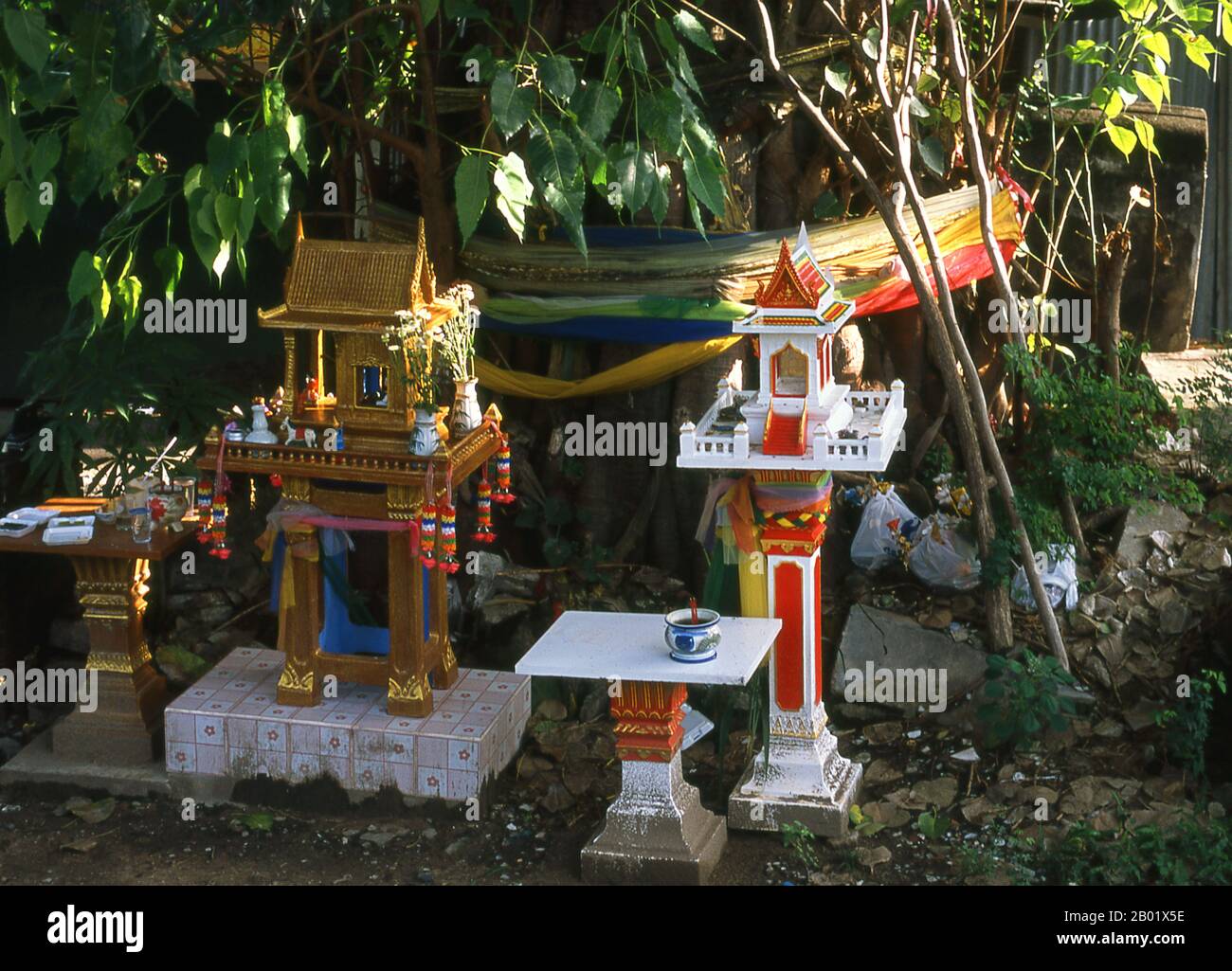 Thailand: Spirit houses at Wat Yang Kuang before renovation, Suriyawong Road, Chiang Mai, northern Thailand. Chiang Mai is often called Thailand’s ‘Rose of the North’, and is the country’s second city and a popular tourist destination due primarily to its mountainous scenery, colourful ethnic hilltribes and their handicrafts. Founded in 1296 by King Mengrai as the capital of his Lanna kingdom, Chiang Mai was later overrun by Burmese invaders in 1767. The city was then left abandoned between 1776 and 1791. Chiang Mai formally became part of Siam in 1774 by an agreement. Stock Photohttps://www.alamy.com/image-license-details/?v=1https://www.alamy.com/thailand-spirit-houses-at-wat-yang-kuang-before-renovation-suriyawong-road-chiang-mai-northern-thailand-chiang-mai-is-often-called-thailands-rose-of-the-north-and-is-the-countrys-second-city-and-a-popular-tourist-destination-due-primarily-to-its-mountainous-scenery-colourful-ethnic-hilltribes-and-their-handicrafts-founded-in-1296-by-king-mengrai-as-the-capital-of-his-lanna-kingdom-chiang-mai-was-later-overrun-by-burmese-invaders-in-1767-the-city-was-then-left-abandoned-between-1776-and-1791-chiang-mai-formally-became-part-of-siam-in-1774-by-an-agreement-image344249850.html
Thailand: Spirit houses at Wat Yang Kuang before renovation, Suriyawong Road, Chiang Mai, northern Thailand. Chiang Mai is often called Thailand’s ‘Rose of the North’, and is the country’s second city and a popular tourist destination due primarily to its mountainous scenery, colourful ethnic hilltribes and their handicrafts. Founded in 1296 by King Mengrai as the capital of his Lanna kingdom, Chiang Mai was later overrun by Burmese invaders in 1767. The city was then left abandoned between 1776 and 1791. Chiang Mai formally became part of Siam in 1774 by an agreement. Stock Photohttps://www.alamy.com/image-license-details/?v=1https://www.alamy.com/thailand-spirit-houses-at-wat-yang-kuang-before-renovation-suriyawong-road-chiang-mai-northern-thailand-chiang-mai-is-often-called-thailands-rose-of-the-north-and-is-the-countrys-second-city-and-a-popular-tourist-destination-due-primarily-to-its-mountainous-scenery-colourful-ethnic-hilltribes-and-their-handicrafts-founded-in-1296-by-king-mengrai-as-the-capital-of-his-lanna-kingdom-chiang-mai-was-later-overrun-by-burmese-invaders-in-1767-the-city-was-then-left-abandoned-between-1776-and-1791-chiang-mai-formally-became-part-of-siam-in-1774-by-an-agreement-image344249850.htmlRM2B01X5E–Thailand: Spirit houses at Wat Yang Kuang before renovation, Suriyawong Road, Chiang Mai, northern Thailand. Chiang Mai is often called Thailand’s ‘Rose of the North’, and is the country’s second city and a popular tourist destination due primarily to its mountainous scenery, colourful ethnic hilltribes and their handicrafts. Founded in 1296 by King Mengrai as the capital of his Lanna kingdom, Chiang Mai was later overrun by Burmese invaders in 1767. The city was then left abandoned between 1776 and 1791. Chiang Mai formally became part of Siam in 1774 by an agreement.
 King Mengrai founded the city of Chiang Mai (meaning 'new city') in 1296, and it succeeded Chiang Rai as capital of the Lanna kingdom. The ruler was known as the Chao. The city was surrounded by a moat and a defensive wall, since nearby Burma was a constant threat. Chiang Mai formally became part of Siam in 1774 by an agreement with Chao Kavila, after the Thai King Taksin helped drive out the Burmese. Chiang Mai then slowly grew in cultural, trading and economic importance to its current status as the unofficial capital of northern Thailand, second in importance only to Bangkok. Stock Photohttps://www.alamy.com/image-license-details/?v=1https://www.alamy.com/king-mengrai-founded-the-city-of-chiang-mai-meaning-new-city-in-1296-and-it-succeeded-chiang-rai-as-capital-of-the-lanna-kingdom-the-ruler-was-known-as-the-chao-the-city-was-surrounded-by-a-moat-and-a-defensive-wall-since-nearby-burma-was-a-constant-threat-chiang-mai-formally-became-part-of-siam-in-1774-by-an-agreement-with-chao-kavila-after-the-thai-king-taksin-helped-drive-out-the-burmese-chiang-mai-then-slowly-grew-in-cultural-trading-and-economic-importance-to-its-current-status-as-the-unofficial-capital-of-northern-thailand-second-in-importance-only-to-bangkok-image344257491.html
King Mengrai founded the city of Chiang Mai (meaning 'new city') in 1296, and it succeeded Chiang Rai as capital of the Lanna kingdom. The ruler was known as the Chao. The city was surrounded by a moat and a defensive wall, since nearby Burma was a constant threat. Chiang Mai formally became part of Siam in 1774 by an agreement with Chao Kavila, after the Thai King Taksin helped drive out the Burmese. Chiang Mai then slowly grew in cultural, trading and economic importance to its current status as the unofficial capital of northern Thailand, second in importance only to Bangkok. Stock Photohttps://www.alamy.com/image-license-details/?v=1https://www.alamy.com/king-mengrai-founded-the-city-of-chiang-mai-meaning-new-city-in-1296-and-it-succeeded-chiang-rai-as-capital-of-the-lanna-kingdom-the-ruler-was-known-as-the-chao-the-city-was-surrounded-by-a-moat-and-a-defensive-wall-since-nearby-burma-was-a-constant-threat-chiang-mai-formally-became-part-of-siam-in-1774-by-an-agreement-with-chao-kavila-after-the-thai-king-taksin-helped-drive-out-the-burmese-chiang-mai-then-slowly-grew-in-cultural-trading-and-economic-importance-to-its-current-status-as-the-unofficial-capital-of-northern-thailand-second-in-importance-only-to-bangkok-image344257491.htmlRM2B027XB–King Mengrai founded the city of Chiang Mai (meaning 'new city') in 1296, and it succeeded Chiang Rai as capital of the Lanna kingdom. The ruler was known as the Chao. The city was surrounded by a moat and a defensive wall, since nearby Burma was a constant threat. Chiang Mai formally became part of Siam in 1774 by an agreement with Chao Kavila, after the Thai King Taksin helped drive out the Burmese. Chiang Mai then slowly grew in cultural, trading and economic importance to its current status as the unofficial capital of northern Thailand, second in importance only to Bangkok.
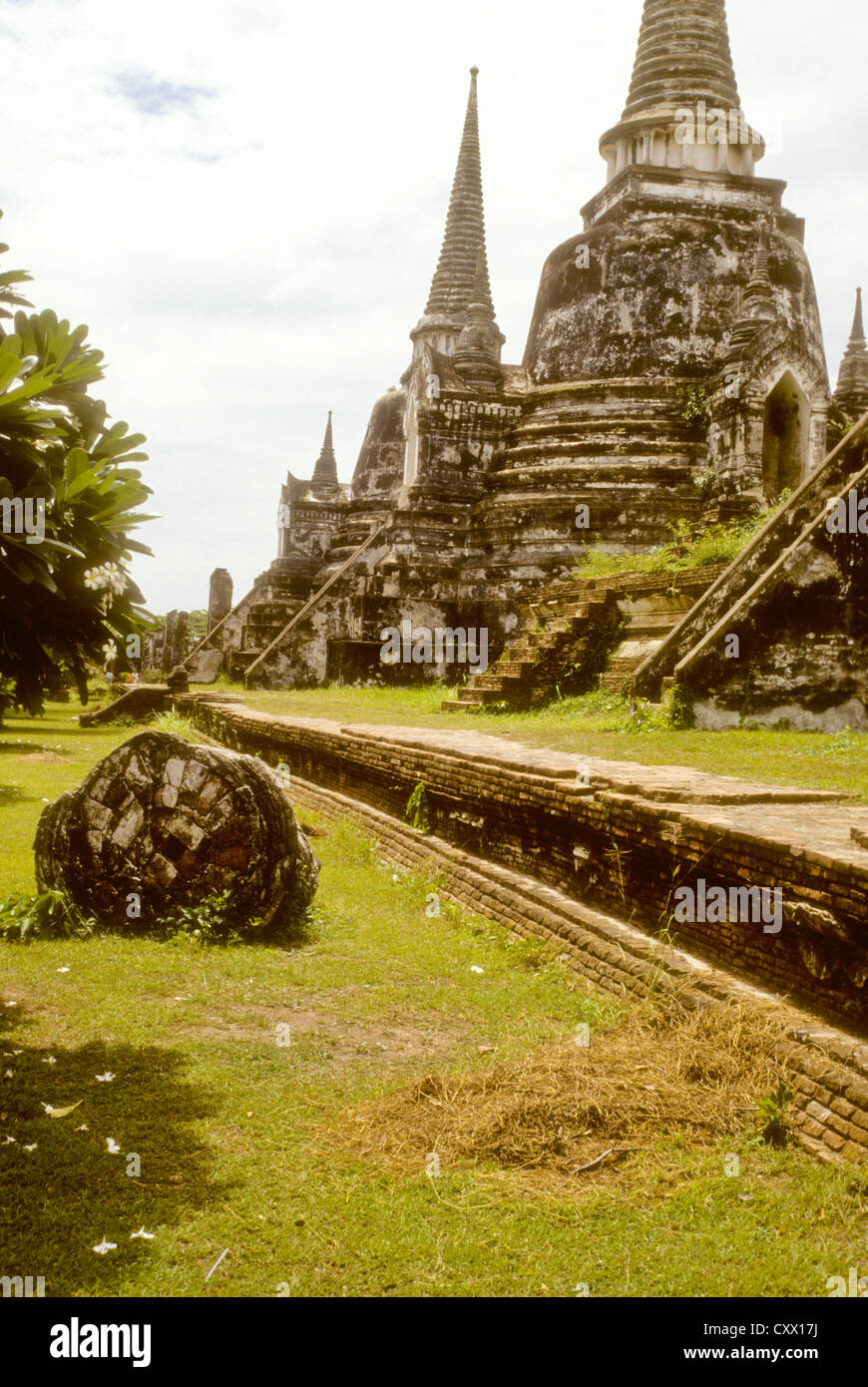 Old Bangkok July-2000 (Slides Conversions) The Ayutthaya historical park covers the ruins of the old city of Ayutthaya Thailand Stock Photohttps://www.alamy.com/image-license-details/?v=1https://www.alamy.com/stock-photo-old-bangkok-july-2000-slides-conversions-the-ayutthaya-historical-50973542.html
Old Bangkok July-2000 (Slides Conversions) The Ayutthaya historical park covers the ruins of the old city of Ayutthaya Thailand Stock Photohttps://www.alamy.com/image-license-details/?v=1https://www.alamy.com/stock-photo-old-bangkok-july-2000-slides-conversions-the-ayutthaya-historical-50973542.htmlRMCXX17J–Old Bangkok July-2000 (Slides Conversions) The Ayutthaya historical park covers the ruins of the old city of Ayutthaya Thailand
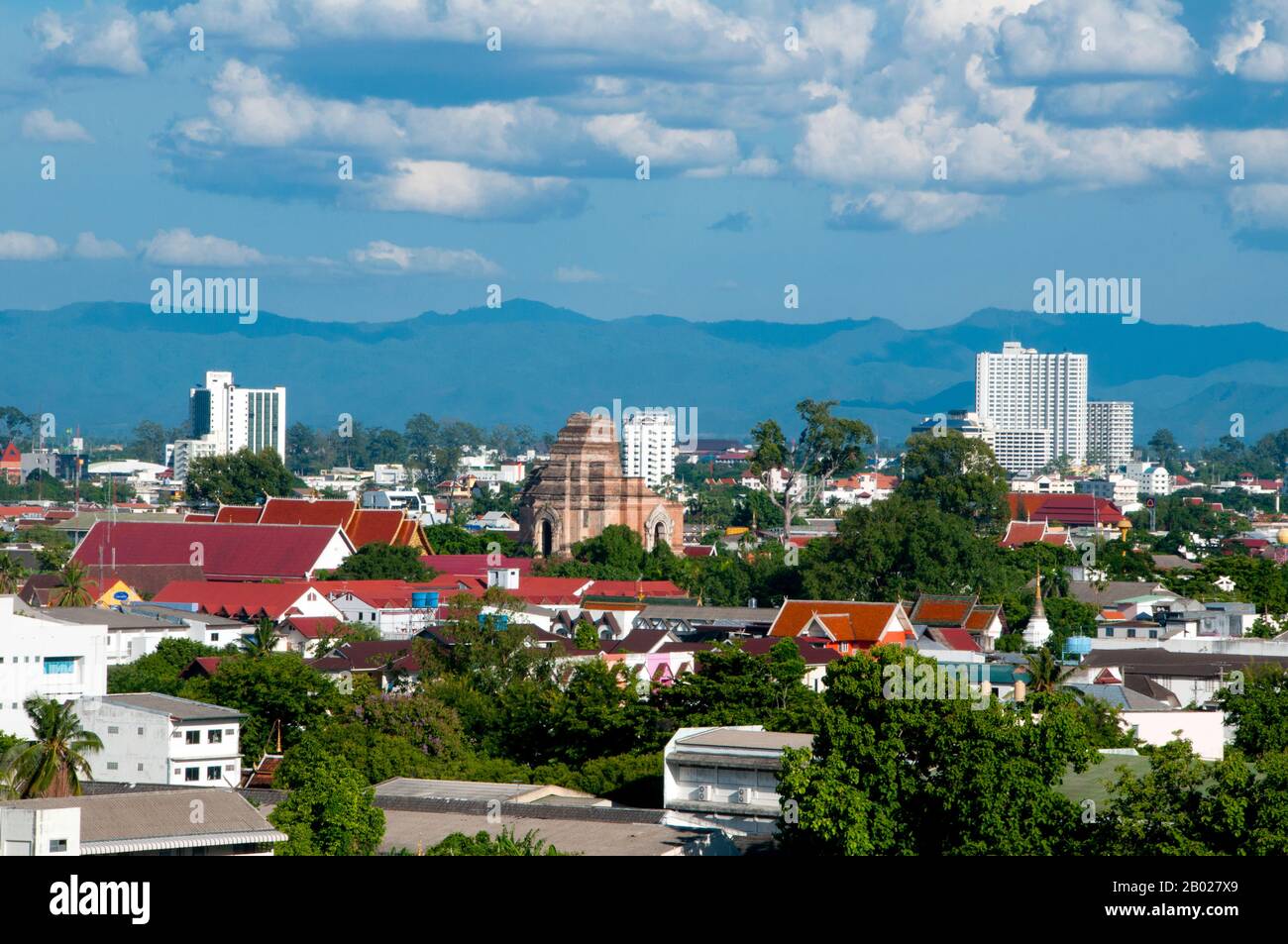 King Mengrai founded the city of Chiang Mai (meaning 'new city') in 1296, and it succeeded Chiang Rai as capital of the Lanna kingdom. The ruler was known as the Chao. The city was surrounded by a moat and a defensive wall, since nearby Burma was a constant threat. Chiang Mai formally became part of Siam in 1774 by an agreement with Chao Kavila, after the Thai King Taksin helped drive out the Burmese. Chiang Mai then slowly grew in cultural, trading and economic importance to its current status as the unofficial capital of northern Thailand, second in importance only to Bangkok. Stock Photohttps://www.alamy.com/image-license-details/?v=1https://www.alamy.com/king-mengrai-founded-the-city-of-chiang-mai-meaning-new-city-in-1296-and-it-succeeded-chiang-rai-as-capital-of-the-lanna-kingdom-the-ruler-was-known-as-the-chao-the-city-was-surrounded-by-a-moat-and-a-defensive-wall-since-nearby-burma-was-a-constant-threat-chiang-mai-formally-became-part-of-siam-in-1774-by-an-agreement-with-chao-kavila-after-the-thai-king-taksin-helped-drive-out-the-burmese-chiang-mai-then-slowly-grew-in-cultural-trading-and-economic-importance-to-its-current-status-as-the-unofficial-capital-of-northern-thailand-second-in-importance-only-to-bangkok-image344257489.html
King Mengrai founded the city of Chiang Mai (meaning 'new city') in 1296, and it succeeded Chiang Rai as capital of the Lanna kingdom. The ruler was known as the Chao. The city was surrounded by a moat and a defensive wall, since nearby Burma was a constant threat. Chiang Mai formally became part of Siam in 1774 by an agreement with Chao Kavila, after the Thai King Taksin helped drive out the Burmese. Chiang Mai then slowly grew in cultural, trading and economic importance to its current status as the unofficial capital of northern Thailand, second in importance only to Bangkok. Stock Photohttps://www.alamy.com/image-license-details/?v=1https://www.alamy.com/king-mengrai-founded-the-city-of-chiang-mai-meaning-new-city-in-1296-and-it-succeeded-chiang-rai-as-capital-of-the-lanna-kingdom-the-ruler-was-known-as-the-chao-the-city-was-surrounded-by-a-moat-and-a-defensive-wall-since-nearby-burma-was-a-constant-threat-chiang-mai-formally-became-part-of-siam-in-1774-by-an-agreement-with-chao-kavila-after-the-thai-king-taksin-helped-drive-out-the-burmese-chiang-mai-then-slowly-grew-in-cultural-trading-and-economic-importance-to-its-current-status-as-the-unofficial-capital-of-northern-thailand-second-in-importance-only-to-bangkok-image344257489.htmlRM2B027X9–King Mengrai founded the city of Chiang Mai (meaning 'new city') in 1296, and it succeeded Chiang Rai as capital of the Lanna kingdom. The ruler was known as the Chao. The city was surrounded by a moat and a defensive wall, since nearby Burma was a constant threat. Chiang Mai formally became part of Siam in 1774 by an agreement with Chao Kavila, after the Thai King Taksin helped drive out the Burmese. Chiang Mai then slowly grew in cultural, trading and economic importance to its current status as the unofficial capital of northern Thailand, second in importance only to Bangkok.
 Old Bangkok July-2000 (Digital Slides Conversions)Sitting Down, Big Buddha in Wat Phoo Bangkok Temple,Bangkok,Thailand Stock Photohttps://www.alamy.com/image-license-details/?v=1https://www.alamy.com/stock-photo-old-bangkok-july-2000-digital-slides-conversionssitting-down-big-buddha-50974433.html
Old Bangkok July-2000 (Digital Slides Conversions)Sitting Down, Big Buddha in Wat Phoo Bangkok Temple,Bangkok,Thailand Stock Photohttps://www.alamy.com/image-license-details/?v=1https://www.alamy.com/stock-photo-old-bangkok-july-2000-digital-slides-conversionssitting-down-big-buddha-50974433.htmlRMCXX2BD–Old Bangkok July-2000 (Digital Slides Conversions)Sitting Down, Big Buddha in Wat Phoo Bangkok Temple,Bangkok,Thailand
 King Mengrai founded the city of Chiang Mai (meaning 'new city') in 1296, and it succeeded Chiang Rai as capital of the Lanna kingdom. The ruler was known as the Chao. The city was surrounded by a moat and a defensive wall, since nearby Burma was a constant threat. Chiang Mai formally became part of Siam in 1774 by an agreement with Chao Kavila, after the Thai King Taksin helped drive out the Burmese. Chiang Mai then slowly grew in cultural, trading and economic importance to its current status as the unofficial capital of northern Thailand, second in importance only to Bangkok. Stock Photohttps://www.alamy.com/image-license-details/?v=1https://www.alamy.com/king-mengrai-founded-the-city-of-chiang-mai-meaning-new-city-in-1296-and-it-succeeded-chiang-rai-as-capital-of-the-lanna-kingdom-the-ruler-was-known-as-the-chao-the-city-was-surrounded-by-a-moat-and-a-defensive-wall-since-nearby-burma-was-a-constant-threat-chiang-mai-formally-became-part-of-siam-in-1774-by-an-agreement-with-chao-kavila-after-the-thai-king-taksin-helped-drive-out-the-burmese-chiang-mai-then-slowly-grew-in-cultural-trading-and-economic-importance-to-its-current-status-as-the-unofficial-capital-of-northern-thailand-second-in-importance-only-to-bangkok-image344257492.html
King Mengrai founded the city of Chiang Mai (meaning 'new city') in 1296, and it succeeded Chiang Rai as capital of the Lanna kingdom. The ruler was known as the Chao. The city was surrounded by a moat and a defensive wall, since nearby Burma was a constant threat. Chiang Mai formally became part of Siam in 1774 by an agreement with Chao Kavila, after the Thai King Taksin helped drive out the Burmese. Chiang Mai then slowly grew in cultural, trading and economic importance to its current status as the unofficial capital of northern Thailand, second in importance only to Bangkok. Stock Photohttps://www.alamy.com/image-license-details/?v=1https://www.alamy.com/king-mengrai-founded-the-city-of-chiang-mai-meaning-new-city-in-1296-and-it-succeeded-chiang-rai-as-capital-of-the-lanna-kingdom-the-ruler-was-known-as-the-chao-the-city-was-surrounded-by-a-moat-and-a-defensive-wall-since-nearby-burma-was-a-constant-threat-chiang-mai-formally-became-part-of-siam-in-1774-by-an-agreement-with-chao-kavila-after-the-thai-king-taksin-helped-drive-out-the-burmese-chiang-mai-then-slowly-grew-in-cultural-trading-and-economic-importance-to-its-current-status-as-the-unofficial-capital-of-northern-thailand-second-in-importance-only-to-bangkok-image344257492.htmlRM2B027XC–King Mengrai founded the city of Chiang Mai (meaning 'new city') in 1296, and it succeeded Chiang Rai as capital of the Lanna kingdom. The ruler was known as the Chao. The city was surrounded by a moat and a defensive wall, since nearby Burma was a constant threat. Chiang Mai formally became part of Siam in 1774 by an agreement with Chao Kavila, after the Thai King Taksin helped drive out the Burmese. Chiang Mai then slowly grew in cultural, trading and economic importance to its current status as the unofficial capital of northern Thailand, second in importance only to Bangkok.
 Wat Saen Fang was originally constructed in the 14th century, but none of the structures visible today date from before the 19th century. Chiang Mai is often called Thailand’s ‘Rose of the North’, and is the country’s second city and a popular tourist destination due primarily to its mountainous scenery, colourful ethnic hilltribes and their handicrafts. Founded in 1296 by King Mengrai as the capital of his Lanna kingdom, Chiang Mai was later overrun by Burmese invaders in 1767. The city was then left abandoned between 1776 and 1791. Chiang Mai formally became part of Siam in 1774 by an agre Stock Photohttps://www.alamy.com/image-license-details/?v=1https://www.alamy.com/wat-saen-fang-was-originally-constructed-in-the-14th-century-but-none-of-the-structures-visible-today-date-from-before-the-19th-century-chiang-mai-is-often-called-thailands-rose-of-the-north-and-is-the-countrys-second-city-and-a-popular-tourist-destination-due-primarily-to-its-mountainous-scenery-colourful-ethnic-hilltribes-and-their-handicrafts-founded-in-1296-by-king-mengrai-as-the-capital-of-his-lanna-kingdom-chiang-mai-was-later-overrun-by-burmese-invaders-in-1767-the-city-was-then-left-abandoned-between-1776-and-1791-chiang-mai-formally-became-part-of-siam-in-1774-by-an-agre-image344258747.html
Wat Saen Fang was originally constructed in the 14th century, but none of the structures visible today date from before the 19th century. Chiang Mai is often called Thailand’s ‘Rose of the North’, and is the country’s second city and a popular tourist destination due primarily to its mountainous scenery, colourful ethnic hilltribes and their handicrafts. Founded in 1296 by King Mengrai as the capital of his Lanna kingdom, Chiang Mai was later overrun by Burmese invaders in 1767. The city was then left abandoned between 1776 and 1791. Chiang Mai formally became part of Siam in 1774 by an agre Stock Photohttps://www.alamy.com/image-license-details/?v=1https://www.alamy.com/wat-saen-fang-was-originally-constructed-in-the-14th-century-but-none-of-the-structures-visible-today-date-from-before-the-19th-century-chiang-mai-is-often-called-thailands-rose-of-the-north-and-is-the-countrys-second-city-and-a-popular-tourist-destination-due-primarily-to-its-mountainous-scenery-colourful-ethnic-hilltribes-and-their-handicrafts-founded-in-1296-by-king-mengrai-as-the-capital-of-his-lanna-kingdom-chiang-mai-was-later-overrun-by-burmese-invaders-in-1767-the-city-was-then-left-abandoned-between-1776-and-1791-chiang-mai-formally-became-part-of-siam-in-1774-by-an-agre-image344258747.htmlRM2B029F7–Wat Saen Fang was originally constructed in the 14th century, but none of the structures visible today date from before the 19th century. Chiang Mai is often called Thailand’s ‘Rose of the North’, and is the country’s second city and a popular tourist destination due primarily to its mountainous scenery, colourful ethnic hilltribes and their handicrafts. Founded in 1296 by King Mengrai as the capital of his Lanna kingdom, Chiang Mai was later overrun by Burmese invaders in 1767. The city was then left abandoned between 1776 and 1791. Chiang Mai formally became part of Siam in 1774 by an agre
 Old Bangkok July-2000 (Slide Conversion) The Ayutthaya historical park covers the ruins of the old city of Ayutthaya Thailand Stock Photohttps://www.alamy.com/image-license-details/?v=1https://www.alamy.com/stock-photo-old-bangkok-july-2000-slide-conversion-the-ayutthaya-historical-park-50973615.html
Old Bangkok July-2000 (Slide Conversion) The Ayutthaya historical park covers the ruins of the old city of Ayutthaya Thailand Stock Photohttps://www.alamy.com/image-license-details/?v=1https://www.alamy.com/stock-photo-old-bangkok-july-2000-slide-conversion-the-ayutthaya-historical-park-50973615.htmlRMCXX1A7–Old Bangkok July-2000 (Slide Conversion) The Ayutthaya historical park covers the ruins of the old city of Ayutthaya Thailand
 Wat Saen Fang was originally constructed in the 14th century, but none of the structures visible today date from before the 19th century. Chiang Mai is often called Thailand’s ‘Rose of the North’, and is the country’s second city and a popular tourist destination due primarily to its mountainous scenery, colourful ethnic hilltribes and their handicrafts. Founded in 1296 by King Mengrai as the capital of his Lanna kingdom, Chiang Mai was later overrun by Burmese invaders in 1767. The city was then left abandoned between 1776 and 1791. Chiang Mai formally became part of Siam in 1774 by an agre Stock Photohttps://www.alamy.com/image-license-details/?v=1https://www.alamy.com/wat-saen-fang-was-originally-constructed-in-the-14th-century-but-none-of-the-structures-visible-today-date-from-before-the-19th-century-chiang-mai-is-often-called-thailands-rose-of-the-north-and-is-the-countrys-second-city-and-a-popular-tourist-destination-due-primarily-to-its-mountainous-scenery-colourful-ethnic-hilltribes-and-their-handicrafts-founded-in-1296-by-king-mengrai-as-the-capital-of-his-lanna-kingdom-chiang-mai-was-later-overrun-by-burmese-invaders-in-1767-the-city-was-then-left-abandoned-between-1776-and-1791-chiang-mai-formally-became-part-of-siam-in-1774-by-an-agre-image344258744.html
Wat Saen Fang was originally constructed in the 14th century, but none of the structures visible today date from before the 19th century. Chiang Mai is often called Thailand’s ‘Rose of the North’, and is the country’s second city and a popular tourist destination due primarily to its mountainous scenery, colourful ethnic hilltribes and their handicrafts. Founded in 1296 by King Mengrai as the capital of his Lanna kingdom, Chiang Mai was later overrun by Burmese invaders in 1767. The city was then left abandoned between 1776 and 1791. Chiang Mai formally became part of Siam in 1774 by an agre Stock Photohttps://www.alamy.com/image-license-details/?v=1https://www.alamy.com/wat-saen-fang-was-originally-constructed-in-the-14th-century-but-none-of-the-structures-visible-today-date-from-before-the-19th-century-chiang-mai-is-often-called-thailands-rose-of-the-north-and-is-the-countrys-second-city-and-a-popular-tourist-destination-due-primarily-to-its-mountainous-scenery-colourful-ethnic-hilltribes-and-their-handicrafts-founded-in-1296-by-king-mengrai-as-the-capital-of-his-lanna-kingdom-chiang-mai-was-later-overrun-by-burmese-invaders-in-1767-the-city-was-then-left-abandoned-between-1776-and-1791-chiang-mai-formally-became-part-of-siam-in-1774-by-an-agre-image344258744.htmlRM2B029F4–Wat Saen Fang was originally constructed in the 14th century, but none of the structures visible today date from before the 19th century. Chiang Mai is often called Thailand’s ‘Rose of the North’, and is the country’s second city and a popular tourist destination due primarily to its mountainous scenery, colourful ethnic hilltribes and their handicrafts. Founded in 1296 by King Mengrai as the capital of his Lanna kingdom, Chiang Mai was later overrun by Burmese invaders in 1767. The city was then left abandoned between 1776 and 1791. Chiang Mai formally became part of Siam in 1774 by an agre
 Old Bangkok July-2000 (Slides Conversions) The Ayutthaya historical park covers the ruins of the old city of Ayutthaya Thailand Stock Photohttps://www.alamy.com/image-license-details/?v=1https://www.alamy.com/stock-photo-old-bangkok-july-2000-slides-conversions-the-ayutthaya-historical-50973440.html
Old Bangkok July-2000 (Slides Conversions) The Ayutthaya historical park covers the ruins of the old city of Ayutthaya Thailand Stock Photohttps://www.alamy.com/image-license-details/?v=1https://www.alamy.com/stock-photo-old-bangkok-july-2000-slides-conversions-the-ayutthaya-historical-50973440.htmlRMCXX140–Old Bangkok July-2000 (Slides Conversions) The Ayutthaya historical park covers the ruins of the old city of Ayutthaya Thailand
 Wat Saen Fang was originally constructed in the 14th century, but none of the structures visible today date from before the 19th century. Chiang Mai is often called Thailand’s ‘Rose of the North’, and is the country’s second city and a popular tourist destination due primarily to its mountainous scenery, colourful ethnic hilltribes and their handicrafts. Founded in 1296 by King Mengrai as the capital of his Lanna kingdom, Chiang Mai was later overrun by Burmese invaders in 1767. The city was then left abandoned between 1776 and 1791. Chiang Mai formally became part of Siam in 1774 by an agre Stock Photohttps://www.alamy.com/image-license-details/?v=1https://www.alamy.com/wat-saen-fang-was-originally-constructed-in-the-14th-century-but-none-of-the-structures-visible-today-date-from-before-the-19th-century-chiang-mai-is-often-called-thailands-rose-of-the-north-and-is-the-countrys-second-city-and-a-popular-tourist-destination-due-primarily-to-its-mountainous-scenery-colourful-ethnic-hilltribes-and-their-handicrafts-founded-in-1296-by-king-mengrai-as-the-capital-of-his-lanna-kingdom-chiang-mai-was-later-overrun-by-burmese-invaders-in-1767-the-city-was-then-left-abandoned-between-1776-and-1791-chiang-mai-formally-became-part-of-siam-in-1774-by-an-agre-image344258739.html
Wat Saen Fang was originally constructed in the 14th century, but none of the structures visible today date from before the 19th century. Chiang Mai is often called Thailand’s ‘Rose of the North’, and is the country’s second city and a popular tourist destination due primarily to its mountainous scenery, colourful ethnic hilltribes and their handicrafts. Founded in 1296 by King Mengrai as the capital of his Lanna kingdom, Chiang Mai was later overrun by Burmese invaders in 1767. The city was then left abandoned between 1776 and 1791. Chiang Mai formally became part of Siam in 1774 by an agre Stock Photohttps://www.alamy.com/image-license-details/?v=1https://www.alamy.com/wat-saen-fang-was-originally-constructed-in-the-14th-century-but-none-of-the-structures-visible-today-date-from-before-the-19th-century-chiang-mai-is-often-called-thailands-rose-of-the-north-and-is-the-countrys-second-city-and-a-popular-tourist-destination-due-primarily-to-its-mountainous-scenery-colourful-ethnic-hilltribes-and-their-handicrafts-founded-in-1296-by-king-mengrai-as-the-capital-of-his-lanna-kingdom-chiang-mai-was-later-overrun-by-burmese-invaders-in-1767-the-city-was-then-left-abandoned-between-1776-and-1791-chiang-mai-formally-became-part-of-siam-in-1774-by-an-agre-image344258739.htmlRM2B029EY–Wat Saen Fang was originally constructed in the 14th century, but none of the structures visible today date from before the 19th century. Chiang Mai is often called Thailand’s ‘Rose of the North’, and is the country’s second city and a popular tourist destination due primarily to its mountainous scenery, colourful ethnic hilltribes and their handicrafts. Founded in 1296 by King Mengrai as the capital of his Lanna kingdom, Chiang Mai was later overrun by Burmese invaders in 1767. The city was then left abandoned between 1776 and 1791. Chiang Mai formally became part of Siam in 1774 by an agre
 Old Bangkok July-2000 (Slides Conversions) The Ayutthaya historical park covers the ruins of the old city of Ayutthaya Thailand Stock Photohttps://www.alamy.com/image-license-details/?v=1https://www.alamy.com/stock-photo-old-bangkok-july-2000-slides-conversions-the-ayutthaya-historical-50973305.html
Old Bangkok July-2000 (Slides Conversions) The Ayutthaya historical park covers the ruins of the old city of Ayutthaya Thailand Stock Photohttps://www.alamy.com/image-license-details/?v=1https://www.alamy.com/stock-photo-old-bangkok-july-2000-slides-conversions-the-ayutthaya-historical-50973305.htmlRMCXX0Y5–Old Bangkok July-2000 (Slides Conversions) The Ayutthaya historical park covers the ruins of the old city of Ayutthaya Thailand
 Wat Saen Fang was originally constructed in the 14th century, but none of the structures visible today date from before the 19th century. Chiang Mai is often called Thailand’s ‘Rose of the North’, and is the country’s second city and a popular tourist destination due primarily to its mountainous scenery, colourful ethnic hilltribes and their handicrafts. Founded in 1296 by King Mengrai as the capital of his Lanna kingdom, Chiang Mai was later overrun by Burmese invaders in 1767. The city was then left abandoned between 1776 and 1791. Chiang Mai formally became part of Siam in 1774 by an agre Stock Photohttps://www.alamy.com/image-license-details/?v=1https://www.alamy.com/wat-saen-fang-was-originally-constructed-in-the-14th-century-but-none-of-the-structures-visible-today-date-from-before-the-19th-century-chiang-mai-is-often-called-thailands-rose-of-the-north-and-is-the-countrys-second-city-and-a-popular-tourist-destination-due-primarily-to-its-mountainous-scenery-colourful-ethnic-hilltribes-and-their-handicrafts-founded-in-1296-by-king-mengrai-as-the-capital-of-his-lanna-kingdom-chiang-mai-was-later-overrun-by-burmese-invaders-in-1767-the-city-was-then-left-abandoned-between-1776-and-1791-chiang-mai-formally-became-part-of-siam-in-1774-by-an-agre-image344258742.html
Wat Saen Fang was originally constructed in the 14th century, but none of the structures visible today date from before the 19th century. Chiang Mai is often called Thailand’s ‘Rose of the North’, and is the country’s second city and a popular tourist destination due primarily to its mountainous scenery, colourful ethnic hilltribes and their handicrafts. Founded in 1296 by King Mengrai as the capital of his Lanna kingdom, Chiang Mai was later overrun by Burmese invaders in 1767. The city was then left abandoned between 1776 and 1791. Chiang Mai formally became part of Siam in 1774 by an agre Stock Photohttps://www.alamy.com/image-license-details/?v=1https://www.alamy.com/wat-saen-fang-was-originally-constructed-in-the-14th-century-but-none-of-the-structures-visible-today-date-from-before-the-19th-century-chiang-mai-is-often-called-thailands-rose-of-the-north-and-is-the-countrys-second-city-and-a-popular-tourist-destination-due-primarily-to-its-mountainous-scenery-colourful-ethnic-hilltribes-and-their-handicrafts-founded-in-1296-by-king-mengrai-as-the-capital-of-his-lanna-kingdom-chiang-mai-was-later-overrun-by-burmese-invaders-in-1767-the-city-was-then-left-abandoned-between-1776-and-1791-chiang-mai-formally-became-part-of-siam-in-1774-by-an-agre-image344258742.htmlRM2B029F2–Wat Saen Fang was originally constructed in the 14th century, but none of the structures visible today date from before the 19th century. Chiang Mai is often called Thailand’s ‘Rose of the North’, and is the country’s second city and a popular tourist destination due primarily to its mountainous scenery, colourful ethnic hilltribes and their handicrafts. Founded in 1296 by King Mengrai as the capital of his Lanna kingdom, Chiang Mai was later overrun by Burmese invaders in 1767. The city was then left abandoned between 1776 and 1791. Chiang Mai formally became part of Siam in 1774 by an agre
 Old Bangkok July-2000 (Digital Slide Conversion) Big Buddha in Wat Phanan Choeng Ayutthaya nr Bangkok,Thailand Stock Photohttps://www.alamy.com/image-license-details/?v=1https://www.alamy.com/stock-photo-old-bangkok-july-2000-digital-slide-conversion-big-buddha-in-wat-phanan-50973652.html
Old Bangkok July-2000 (Digital Slide Conversion) Big Buddha in Wat Phanan Choeng Ayutthaya nr Bangkok,Thailand Stock Photohttps://www.alamy.com/image-license-details/?v=1https://www.alamy.com/stock-photo-old-bangkok-july-2000-digital-slide-conversion-big-buddha-in-wat-phanan-50973652.htmlRMCXX1BG–Old Bangkok July-2000 (Digital Slide Conversion) Big Buddha in Wat Phanan Choeng Ayutthaya nr Bangkok,Thailand
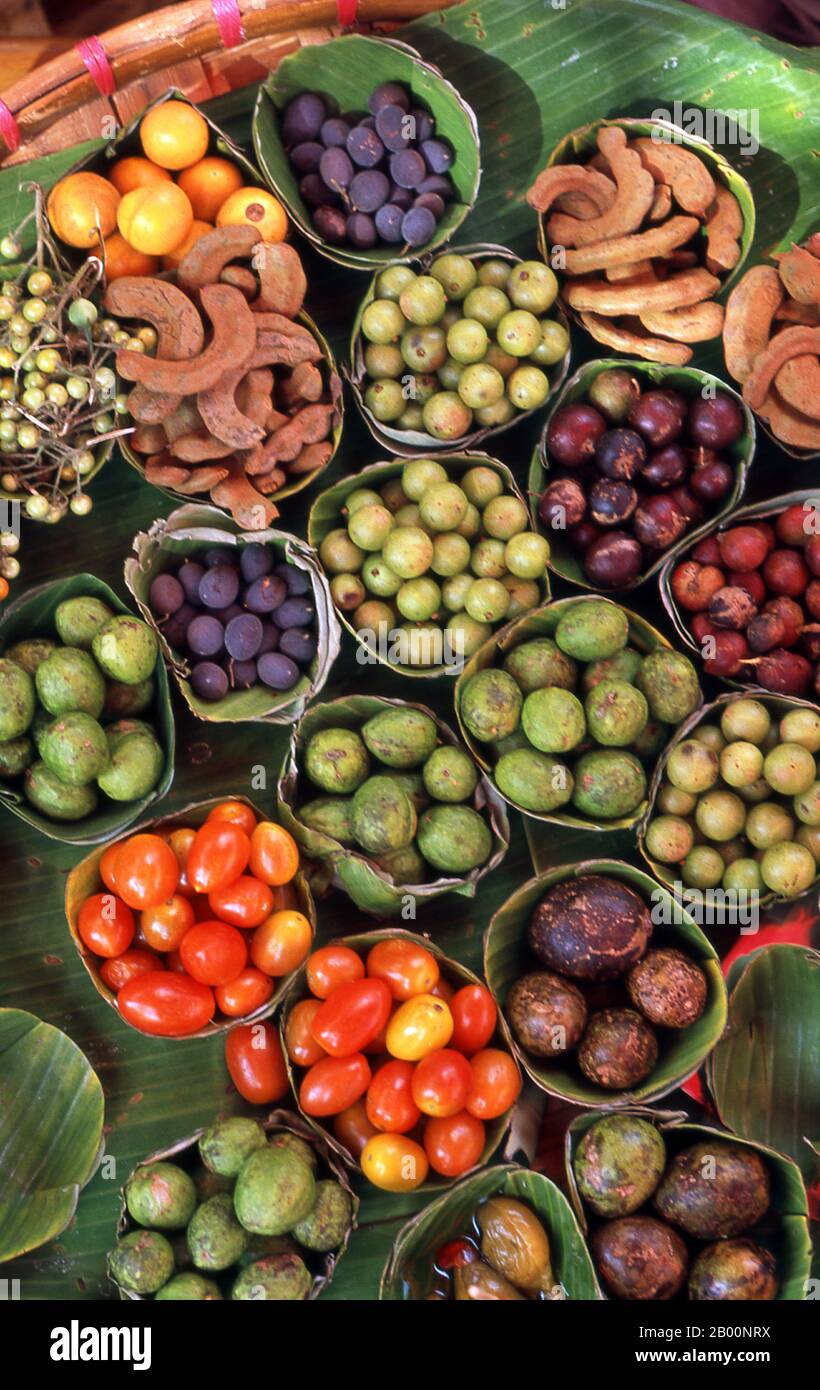 Thailand: A colourful display of fruit at a traditional northern market, Chiang Mai, northern Thailand. Chiang Mai, Thailand’s ‘Rose of the North’, is the country’s second city and a popular tourist destination due primarily to its mountainous scenery, colourful ethnic hilltibes and their handicrafts. Founded in 1296 by King Mengrai as the capital of his Lanna kingdom, Chiang Mai was later overrun by Burmese invaders in 1767. The city was then left abandoned between 1776 and 1791. Chiang Mai formally became part of Siam in 1774 by an agreement with local prince Chao Kavila. Stock Photohttps://www.alamy.com/image-license-details/?v=1https://www.alamy.com/thailand-a-colourful-display-of-fruit-at-a-traditional-northern-market-chiang-mai-northern-thailand-chiang-mai-thailands-rose-of-the-north-is-the-countrys-second-city-and-a-popular-tourist-destination-due-primarily-to-its-mountainous-scenery-colourful-ethnic-hilltibes-and-their-handicrafts-founded-in-1296-by-king-mengrai-as-the-capital-of-his-lanna-kingdom-chiang-mai-was-later-overrun-by-burmese-invaders-in-1767-the-city-was-then-left-abandoned-between-1776-and-1791-chiang-mai-formally-became-part-of-siam-in-1774-by-an-agreement-with-local-prince-chao-kavila-image344224494.html
Thailand: A colourful display of fruit at a traditional northern market, Chiang Mai, northern Thailand. Chiang Mai, Thailand’s ‘Rose of the North’, is the country’s second city and a popular tourist destination due primarily to its mountainous scenery, colourful ethnic hilltibes and their handicrafts. Founded in 1296 by King Mengrai as the capital of his Lanna kingdom, Chiang Mai was later overrun by Burmese invaders in 1767. The city was then left abandoned between 1776 and 1791. Chiang Mai formally became part of Siam in 1774 by an agreement with local prince Chao Kavila. Stock Photohttps://www.alamy.com/image-license-details/?v=1https://www.alamy.com/thailand-a-colourful-display-of-fruit-at-a-traditional-northern-market-chiang-mai-northern-thailand-chiang-mai-thailands-rose-of-the-north-is-the-countrys-second-city-and-a-popular-tourist-destination-due-primarily-to-its-mountainous-scenery-colourful-ethnic-hilltibes-and-their-handicrafts-founded-in-1296-by-king-mengrai-as-the-capital-of-his-lanna-kingdom-chiang-mai-was-later-overrun-by-burmese-invaders-in-1767-the-city-was-then-left-abandoned-between-1776-and-1791-chiang-mai-formally-became-part-of-siam-in-1774-by-an-agreement-with-local-prince-chao-kavila-image344224494.htmlRM2B00NRX–Thailand: A colourful display of fruit at a traditional northern market, Chiang Mai, northern Thailand. Chiang Mai, Thailand’s ‘Rose of the North’, is the country’s second city and a popular tourist destination due primarily to its mountainous scenery, colourful ethnic hilltibes and their handicrafts. Founded in 1296 by King Mengrai as the capital of his Lanna kingdom, Chiang Mai was later overrun by Burmese invaders in 1767. The city was then left abandoned between 1776 and 1791. Chiang Mai formally became part of Siam in 1774 by an agreement with local prince Chao Kavila.
 Old Bangkok July-2000 (Digital Slide Conversion) Big Buddha in Wat Phanan Choeng Ayutthaya nr Bangkok,Thailand Stock Photohttps://www.alamy.com/image-license-details/?v=1https://www.alamy.com/stock-photo-old-bangkok-july-2000-digital-slide-conversion-big-buddha-in-wat-phanan-50973631.html
Old Bangkok July-2000 (Digital Slide Conversion) Big Buddha in Wat Phanan Choeng Ayutthaya nr Bangkok,Thailand Stock Photohttps://www.alamy.com/image-license-details/?v=1https://www.alamy.com/stock-photo-old-bangkok-july-2000-digital-slide-conversion-big-buddha-in-wat-phanan-50973631.htmlRMCXX1AR–Old Bangkok July-2000 (Digital Slide Conversion) Big Buddha in Wat Phanan Choeng Ayutthaya nr Bangkok,Thailand
 Thailand: Burmese-style chedi, Wat Saen Fang, Chiang Mai, northern Thailand. Wat Saen Fang was originally constructed in the 14th century, but none of the structures visible today date from before the 19th century. Chiang Mai is often called Thailand’s ‘Rose of the North’, and is the country’s second city and a popular tourist destination due primarily to its mountainous scenery, colourful ethnic hilltribes and their handicrafts. Founded in 1296 by King Mengrai as the capital of his Lanna kingdom, Chiang Mai was later overrun by Burmese invaders in 1767. It became part of Siam in 1774. Stock Photohttps://www.alamy.com/image-license-details/?v=1https://www.alamy.com/thailand-burmese-style-chedi-wat-saen-fang-chiang-mai-northern-thailand-wat-saen-fang-was-originally-constructed-in-the-14th-century-but-none-of-the-structures-visible-today-date-from-before-the-19th-century-chiang-mai-is-often-called-thailands-rose-of-the-north-and-is-the-countrys-second-city-and-a-popular-tourist-destination-due-primarily-to-its-mountainous-scenery-colourful-ethnic-hilltribes-and-their-handicrafts-founded-in-1296-by-king-mengrai-as-the-capital-of-his-lanna-kingdom-chiang-mai-was-later-overrun-by-burmese-invaders-in-1767-it-became-part-of-siam-in-1774-image344224495.html
Thailand: Burmese-style chedi, Wat Saen Fang, Chiang Mai, northern Thailand. Wat Saen Fang was originally constructed in the 14th century, but none of the structures visible today date from before the 19th century. Chiang Mai is often called Thailand’s ‘Rose of the North’, and is the country’s second city and a popular tourist destination due primarily to its mountainous scenery, colourful ethnic hilltribes and their handicrafts. Founded in 1296 by King Mengrai as the capital of his Lanna kingdom, Chiang Mai was later overrun by Burmese invaders in 1767. It became part of Siam in 1774. Stock Photohttps://www.alamy.com/image-license-details/?v=1https://www.alamy.com/thailand-burmese-style-chedi-wat-saen-fang-chiang-mai-northern-thailand-wat-saen-fang-was-originally-constructed-in-the-14th-century-but-none-of-the-structures-visible-today-date-from-before-the-19th-century-chiang-mai-is-often-called-thailands-rose-of-the-north-and-is-the-countrys-second-city-and-a-popular-tourist-destination-due-primarily-to-its-mountainous-scenery-colourful-ethnic-hilltribes-and-their-handicrafts-founded-in-1296-by-king-mengrai-as-the-capital-of-his-lanna-kingdom-chiang-mai-was-later-overrun-by-burmese-invaders-in-1767-it-became-part-of-siam-in-1774-image344224495.htmlRM2B00NRY–Thailand: Burmese-style chedi, Wat Saen Fang, Chiang Mai, northern Thailand. Wat Saen Fang was originally constructed in the 14th century, but none of the structures visible today date from before the 19th century. Chiang Mai is often called Thailand’s ‘Rose of the North’, and is the country’s second city and a popular tourist destination due primarily to its mountainous scenery, colourful ethnic hilltribes and their handicrafts. Founded in 1296 by King Mengrai as the capital of his Lanna kingdom, Chiang Mai was later overrun by Burmese invaders in 1767. It became part of Siam in 1774.
 Old Bangkok July-2000 (Digital Slide Conversion) Reclining,lying down,Buddha in Wat Phoo Bangkok Temple,Thailand Stock Photohttps://www.alamy.com/image-license-details/?v=1https://www.alamy.com/stock-photo-old-bangkok-july-2000-digital-slide-conversion-reclininglying-downbuddha-50974150.html
Old Bangkok July-2000 (Digital Slide Conversion) Reclining,lying down,Buddha in Wat Phoo Bangkok Temple,Thailand Stock Photohttps://www.alamy.com/image-license-details/?v=1https://www.alamy.com/stock-photo-old-bangkok-july-2000-digital-slide-conversion-reclininglying-downbuddha-50974150.htmlRMCXX21A–Old Bangkok July-2000 (Digital Slide Conversion) Reclining,lying down,Buddha in Wat Phoo Bangkok Temple,Thailand
 Thailand: Fruit and sugarcane vendors at a traditional northern market, Traditional Lanna market, Chiang Mai. Chiang Mai, Thailand’s ‘Rose of the North’, is the country’s second city and a popular tourist destination due primarily to its mountainous scenery, colourful ethnic hilltibes and their handicrafts. Founded in 1296 by King Mengrai as the capital of his Lanna kingdom, Chiang Mai was later overrun by Burmese invaders in 1767. The city was then left abandoned between 1776 and 1791. Chiang Mai formally became part of Siam in 1774 by an agreement with local prince Chao Kavila. Stock Photohttps://www.alamy.com/image-license-details/?v=1https://www.alamy.com/thailand-fruit-and-sugarcane-vendors-at-a-traditional-northern-market-traditional-lanna-market-chiang-mai-chiang-mai-thailands-rose-of-the-north-is-the-countrys-second-city-and-a-popular-tourist-destination-due-primarily-to-its-mountainous-scenery-colourful-ethnic-hilltibes-and-their-handicrafts-founded-in-1296-by-king-mengrai-as-the-capital-of-his-lanna-kingdom-chiang-mai-was-later-overrun-by-burmese-invaders-in-1767-the-city-was-then-left-abandoned-between-1776-and-1791-chiang-mai-formally-became-part-of-siam-in-1774-by-an-agreement-with-local-prince-chao-kavila-image344224492.html
Thailand: Fruit and sugarcane vendors at a traditional northern market, Traditional Lanna market, Chiang Mai. Chiang Mai, Thailand’s ‘Rose of the North’, is the country’s second city and a popular tourist destination due primarily to its mountainous scenery, colourful ethnic hilltibes and their handicrafts. Founded in 1296 by King Mengrai as the capital of his Lanna kingdom, Chiang Mai was later overrun by Burmese invaders in 1767. The city was then left abandoned between 1776 and 1791. Chiang Mai formally became part of Siam in 1774 by an agreement with local prince Chao Kavila. Stock Photohttps://www.alamy.com/image-license-details/?v=1https://www.alamy.com/thailand-fruit-and-sugarcane-vendors-at-a-traditional-northern-market-traditional-lanna-market-chiang-mai-chiang-mai-thailands-rose-of-the-north-is-the-countrys-second-city-and-a-popular-tourist-destination-due-primarily-to-its-mountainous-scenery-colourful-ethnic-hilltibes-and-their-handicrafts-founded-in-1296-by-king-mengrai-as-the-capital-of-his-lanna-kingdom-chiang-mai-was-later-overrun-by-burmese-invaders-in-1767-the-city-was-then-left-abandoned-between-1776-and-1791-chiang-mai-formally-became-part-of-siam-in-1774-by-an-agreement-with-local-prince-chao-kavila-image344224492.htmlRM2B00NRT–Thailand: Fruit and sugarcane vendors at a traditional northern market, Traditional Lanna market, Chiang Mai. Chiang Mai, Thailand’s ‘Rose of the North’, is the country’s second city and a popular tourist destination due primarily to its mountainous scenery, colourful ethnic hilltibes and their handicrafts. Founded in 1296 by King Mengrai as the capital of his Lanna kingdom, Chiang Mai was later overrun by Burmese invaders in 1767. The city was then left abandoned between 1776 and 1791. Chiang Mai formally became part of Siam in 1774 by an agreement with local prince Chao Kavila.
 Old Bangkok July-2000 (Slides Conversions) The Ayutthaya historical park covers the ruins of the old city of Ayutthaya Thailand Stock Photohttps://www.alamy.com/image-license-details/?v=1https://www.alamy.com/stock-photo-old-bangkok-july-2000-slides-conversions-the-ayutthaya-historical-50973267.html
Old Bangkok July-2000 (Slides Conversions) The Ayutthaya historical park covers the ruins of the old city of Ayutthaya Thailand Stock Photohttps://www.alamy.com/image-license-details/?v=1https://www.alamy.com/stock-photo-old-bangkok-july-2000-slides-conversions-the-ayutthaya-historical-50973267.htmlRMCXX0WR–Old Bangkok July-2000 (Slides Conversions) The Ayutthaya historical park covers the ruins of the old city of Ayutthaya Thailand
 Thailand: Burmese-style chedi, Wat Saen Fang, Chiang Mai, northern Thailand. Wat Saen Fang was originally constructed in the 14th century, but none of the structures visible today date from before the 19th century. Chiang Mai is often called Thailand’s ‘Rose of the North’, and is the country’s second city and a popular tourist destination due primarily to its mountainous scenery, colourful ethnic hilltribes and their handicrafts. Founded in 1296 by King Mengrai as the capital of his Lanna kingdom, Chiang Mai was later overrun by Burmese invaders in 1767. It became part of Siam in 1774. Stock Photohttps://www.alamy.com/image-license-details/?v=1https://www.alamy.com/thailand-burmese-style-chedi-wat-saen-fang-chiang-mai-northern-thailand-wat-saen-fang-was-originally-constructed-in-the-14th-century-but-none-of-the-structures-visible-today-date-from-before-the-19th-century-chiang-mai-is-often-called-thailands-rose-of-the-north-and-is-the-countrys-second-city-and-a-popular-tourist-destination-due-primarily-to-its-mountainous-scenery-colourful-ethnic-hilltribes-and-their-handicrafts-founded-in-1296-by-king-mengrai-as-the-capital-of-his-lanna-kingdom-chiang-mai-was-later-overrun-by-burmese-invaders-in-1767-it-became-part-of-siam-in-1774-image344224499.html
Thailand: Burmese-style chedi, Wat Saen Fang, Chiang Mai, northern Thailand. Wat Saen Fang was originally constructed in the 14th century, but none of the structures visible today date from before the 19th century. Chiang Mai is often called Thailand’s ‘Rose of the North’, and is the country’s second city and a popular tourist destination due primarily to its mountainous scenery, colourful ethnic hilltribes and their handicrafts. Founded in 1296 by King Mengrai as the capital of his Lanna kingdom, Chiang Mai was later overrun by Burmese invaders in 1767. It became part of Siam in 1774. Stock Photohttps://www.alamy.com/image-license-details/?v=1https://www.alamy.com/thailand-burmese-style-chedi-wat-saen-fang-chiang-mai-northern-thailand-wat-saen-fang-was-originally-constructed-in-the-14th-century-but-none-of-the-structures-visible-today-date-from-before-the-19th-century-chiang-mai-is-often-called-thailands-rose-of-the-north-and-is-the-countrys-second-city-and-a-popular-tourist-destination-due-primarily-to-its-mountainous-scenery-colourful-ethnic-hilltribes-and-their-handicrafts-founded-in-1296-by-king-mengrai-as-the-capital-of-his-lanna-kingdom-chiang-mai-was-later-overrun-by-burmese-invaders-in-1767-it-became-part-of-siam-in-1774-image344224499.htmlRM2B00NT3–Thailand: Burmese-style chedi, Wat Saen Fang, Chiang Mai, northern Thailand. Wat Saen Fang was originally constructed in the 14th century, but none of the structures visible today date from before the 19th century. Chiang Mai is often called Thailand’s ‘Rose of the North’, and is the country’s second city and a popular tourist destination due primarily to its mountainous scenery, colourful ethnic hilltribes and their handicrafts. Founded in 1296 by King Mengrai as the capital of his Lanna kingdom, Chiang Mai was later overrun by Burmese invaders in 1767. It became part of Siam in 1774.
 Old Bangkok July-2000 (Digital Slide Conversion) Reclining,lying down,Buddha in Wat Phoo Bangkok Temple,Thailand Stock Photohttps://www.alamy.com/image-license-details/?v=1https://www.alamy.com/stock-photo-old-bangkok-july-2000-digital-slide-conversion-reclininglying-downbuddha-50974107.html
Old Bangkok July-2000 (Digital Slide Conversion) Reclining,lying down,Buddha in Wat Phoo Bangkok Temple,Thailand Stock Photohttps://www.alamy.com/image-license-details/?v=1https://www.alamy.com/stock-photo-old-bangkok-july-2000-digital-slide-conversion-reclininglying-downbuddha-50974107.htmlRMCXX1YR–Old Bangkok July-2000 (Digital Slide Conversion) Reclining,lying down,Buddha in Wat Phoo Bangkok Temple,Thailand
 Thailand: Thais and foreigners enjoying Chiang Mai's Sunday Walking Street Market, Chiang Mai. Chiang Mai is often called Thailand’s ‘Rose of the North’, and is the country’s second city and a popular tourist destination due primarily to its mountainous scenery, colourful ethnic hilltribes and their handicrafts. Founded in 1296 by King Mengrai as the capital of his Lanna kingdom, Chiang Mai was later overrun by Burmese invaders in 1767. The city was then left abandoned between 1776 and 1791. Chiang Mai formally became part of Siam in 1774 by an agreement with local prince Chao Kavila. Stock Photohttps://www.alamy.com/image-license-details/?v=1https://www.alamy.com/thailand-thais-and-foreigners-enjoying-chiang-mais-sunday-walking-street-market-chiang-mai-chiang-mai-is-often-called-thailands-rose-of-the-north-and-is-the-countrys-second-city-and-a-popular-tourist-destination-due-primarily-to-its-mountainous-scenery-colourful-ethnic-hilltribes-and-their-handicrafts-founded-in-1296-by-king-mengrai-as-the-capital-of-his-lanna-kingdom-chiang-mai-was-later-overrun-by-burmese-invaders-in-1767-the-city-was-then-left-abandoned-between-1776-and-1791-chiang-mai-formally-became-part-of-siam-in-1774-by-an-agreement-with-local-prince-chao-kavila-image344224497.html
Thailand: Thais and foreigners enjoying Chiang Mai's Sunday Walking Street Market, Chiang Mai. Chiang Mai is often called Thailand’s ‘Rose of the North’, and is the country’s second city and a popular tourist destination due primarily to its mountainous scenery, colourful ethnic hilltribes and their handicrafts. Founded in 1296 by King Mengrai as the capital of his Lanna kingdom, Chiang Mai was later overrun by Burmese invaders in 1767. The city was then left abandoned between 1776 and 1791. Chiang Mai formally became part of Siam in 1774 by an agreement with local prince Chao Kavila. Stock Photohttps://www.alamy.com/image-license-details/?v=1https://www.alamy.com/thailand-thais-and-foreigners-enjoying-chiang-mais-sunday-walking-street-market-chiang-mai-chiang-mai-is-often-called-thailands-rose-of-the-north-and-is-the-countrys-second-city-and-a-popular-tourist-destination-due-primarily-to-its-mountainous-scenery-colourful-ethnic-hilltribes-and-their-handicrafts-founded-in-1296-by-king-mengrai-as-the-capital-of-his-lanna-kingdom-chiang-mai-was-later-overrun-by-burmese-invaders-in-1767-the-city-was-then-left-abandoned-between-1776-and-1791-chiang-mai-formally-became-part-of-siam-in-1774-by-an-agreement-with-local-prince-chao-kavila-image344224497.htmlRM2B00NT1–Thailand: Thais and foreigners enjoying Chiang Mai's Sunday Walking Street Market, Chiang Mai. Chiang Mai is often called Thailand’s ‘Rose of the North’, and is the country’s second city and a popular tourist destination due primarily to its mountainous scenery, colourful ethnic hilltribes and their handicrafts. Founded in 1296 by King Mengrai as the capital of his Lanna kingdom, Chiang Mai was later overrun by Burmese invaders in 1767. The city was then left abandoned between 1776 and 1791. Chiang Mai formally became part of Siam in 1774 by an agreement with local prince Chao Kavila.
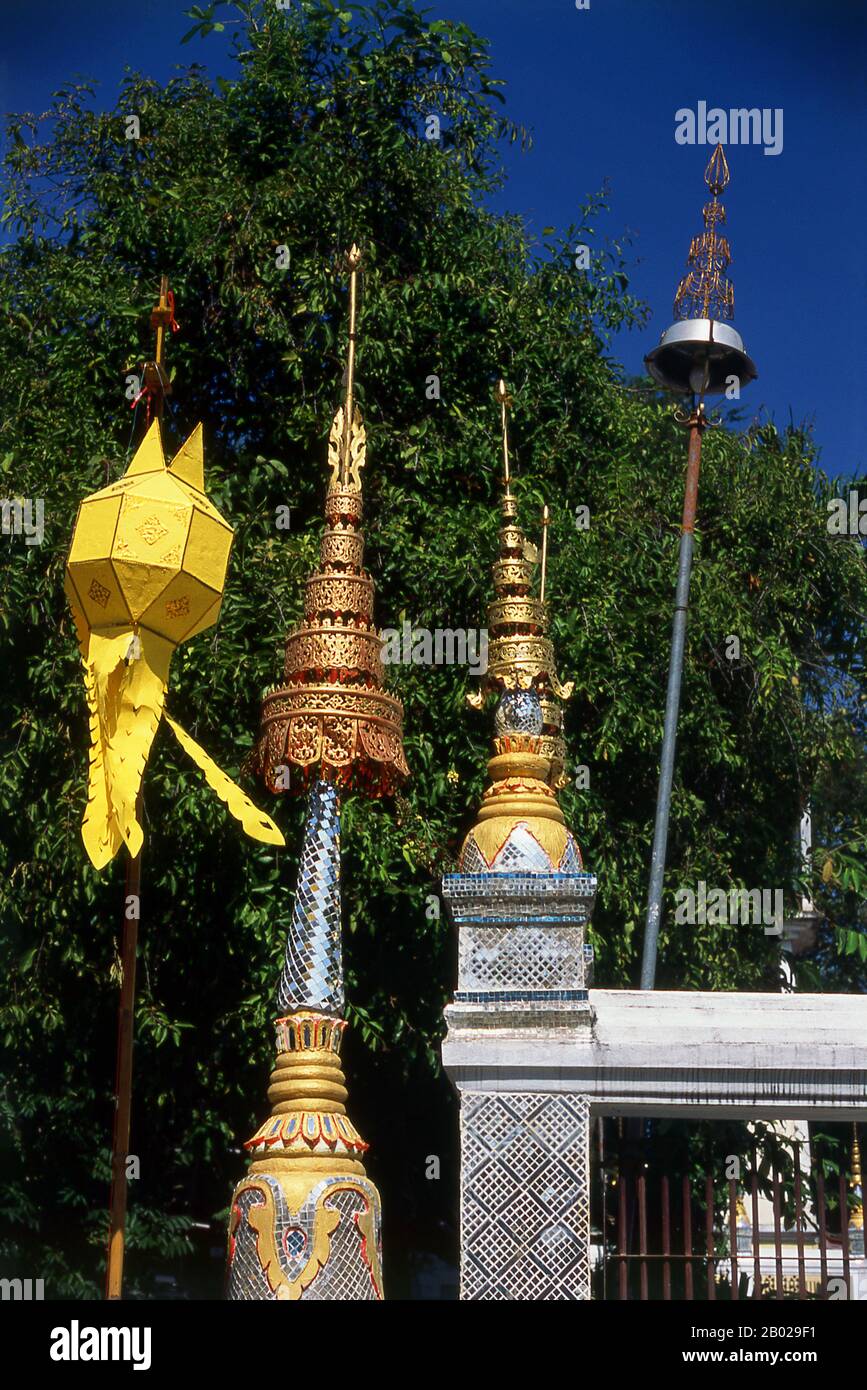 Wat Saen Fang was originally constructed in the 14th century, but none of the structures visible today date from before the 19th century. Chiang Mai is often called Thailand’s ‘Rose of the North’, and is the country’s second city and a popular tourist destination due primarily to its mountainous scenery, colourful ethnic hilltribes and their handicrafts. Founded in 1296 by King Mengrai as the capital of his Lanna kingdom, Chiang Mai was later overrun by Burmese invaders in 1767. The city was then left abandoned between 1776 and 1791. Chiang Mai formally became part of Siam in 1774 by an agre Stock Photohttps://www.alamy.com/image-license-details/?v=1https://www.alamy.com/wat-saen-fang-was-originally-constructed-in-the-14th-century-but-none-of-the-structures-visible-today-date-from-before-the-19th-century-chiang-mai-is-often-called-thailands-rose-of-the-north-and-is-the-countrys-second-city-and-a-popular-tourist-destination-due-primarily-to-its-mountainous-scenery-colourful-ethnic-hilltribes-and-their-handicrafts-founded-in-1296-by-king-mengrai-as-the-capital-of-his-lanna-kingdom-chiang-mai-was-later-overrun-by-burmese-invaders-in-1767-the-city-was-then-left-abandoned-between-1776-and-1791-chiang-mai-formally-became-part-of-siam-in-1774-by-an-agre-image344258741.html
Wat Saen Fang was originally constructed in the 14th century, but none of the structures visible today date from before the 19th century. Chiang Mai is often called Thailand’s ‘Rose of the North’, and is the country’s second city and a popular tourist destination due primarily to its mountainous scenery, colourful ethnic hilltribes and their handicrafts. Founded in 1296 by King Mengrai as the capital of his Lanna kingdom, Chiang Mai was later overrun by Burmese invaders in 1767. The city was then left abandoned between 1776 and 1791. Chiang Mai formally became part of Siam in 1774 by an agre Stock Photohttps://www.alamy.com/image-license-details/?v=1https://www.alamy.com/wat-saen-fang-was-originally-constructed-in-the-14th-century-but-none-of-the-structures-visible-today-date-from-before-the-19th-century-chiang-mai-is-often-called-thailands-rose-of-the-north-and-is-the-countrys-second-city-and-a-popular-tourist-destination-due-primarily-to-its-mountainous-scenery-colourful-ethnic-hilltribes-and-their-handicrafts-founded-in-1296-by-king-mengrai-as-the-capital-of-his-lanna-kingdom-chiang-mai-was-later-overrun-by-burmese-invaders-in-1767-the-city-was-then-left-abandoned-between-1776-and-1791-chiang-mai-formally-became-part-of-siam-in-1774-by-an-agre-image344258741.htmlRM2B029F1–Wat Saen Fang was originally constructed in the 14th century, but none of the structures visible today date from before the 19th century. Chiang Mai is often called Thailand’s ‘Rose of the North’, and is the country’s second city and a popular tourist destination due primarily to its mountainous scenery, colourful ethnic hilltribes and their handicrafts. Founded in 1296 by King Mengrai as the capital of his Lanna kingdom, Chiang Mai was later overrun by Burmese invaders in 1767. The city was then left abandoned between 1776 and 1791. Chiang Mai formally became part of Siam in 1774 by an agre
 Thailand: A woman takes a drink of water with a bamboo ladle from a traditional earthenware drinking pot, Bo Sang Umbrella Village, Chiang Mai. Chiang Mai is often called Thailand’s ‘Rose of the North’, and is the country’s second city and a popular tourist destination due primarily to its mountainous scenery, colourful ethnic hilltribes and their handicrafts. Founded in 1296 by King Mengrai as the capital of his Lanna kingdom, Chiang Mai was later overrun by Burmese invaders in 1767. The city was then left abandoned between 1776 and 1791. Chiang Mai formally became part of Siam in 1774. Stock Photohttps://www.alamy.com/image-license-details/?v=1https://www.alamy.com/thailand-a-woman-takes-a-drink-of-water-with-a-bamboo-ladle-from-a-traditional-earthenware-drinking-pot-bo-sang-umbrella-village-chiang-mai-chiang-mai-is-often-called-thailands-rose-of-the-north-and-is-the-countrys-second-city-and-a-popular-tourist-destination-due-primarily-to-its-mountainous-scenery-colourful-ethnic-hilltribes-and-their-handicrafts-founded-in-1296-by-king-mengrai-as-the-capital-of-his-lanna-kingdom-chiang-mai-was-later-overrun-by-burmese-invaders-in-1767-the-city-was-then-left-abandoned-between-1776-and-1791-chiang-mai-formally-became-part-of-siam-in-1774-image344224502.html
Thailand: A woman takes a drink of water with a bamboo ladle from a traditional earthenware drinking pot, Bo Sang Umbrella Village, Chiang Mai. Chiang Mai is often called Thailand’s ‘Rose of the North’, and is the country’s second city and a popular tourist destination due primarily to its mountainous scenery, colourful ethnic hilltribes and their handicrafts. Founded in 1296 by King Mengrai as the capital of his Lanna kingdom, Chiang Mai was later overrun by Burmese invaders in 1767. The city was then left abandoned between 1776 and 1791. Chiang Mai formally became part of Siam in 1774. Stock Photohttps://www.alamy.com/image-license-details/?v=1https://www.alamy.com/thailand-a-woman-takes-a-drink-of-water-with-a-bamboo-ladle-from-a-traditional-earthenware-drinking-pot-bo-sang-umbrella-village-chiang-mai-chiang-mai-is-often-called-thailands-rose-of-the-north-and-is-the-countrys-second-city-and-a-popular-tourist-destination-due-primarily-to-its-mountainous-scenery-colourful-ethnic-hilltribes-and-their-handicrafts-founded-in-1296-by-king-mengrai-as-the-capital-of-his-lanna-kingdom-chiang-mai-was-later-overrun-by-burmese-invaders-in-1767-the-city-was-then-left-abandoned-between-1776-and-1791-chiang-mai-formally-became-part-of-siam-in-1774-image344224502.htmlRM2B00NT6–Thailand: A woman takes a drink of water with a bamboo ladle from a traditional earthenware drinking pot, Bo Sang Umbrella Village, Chiang Mai. Chiang Mai is often called Thailand’s ‘Rose of the North’, and is the country’s second city and a popular tourist destination due primarily to its mountainous scenery, colourful ethnic hilltribes and their handicrafts. Founded in 1296 by King Mengrai as the capital of his Lanna kingdom, Chiang Mai was later overrun by Burmese invaders in 1767. The city was then left abandoned between 1776 and 1791. Chiang Mai formally became part of Siam in 1774.
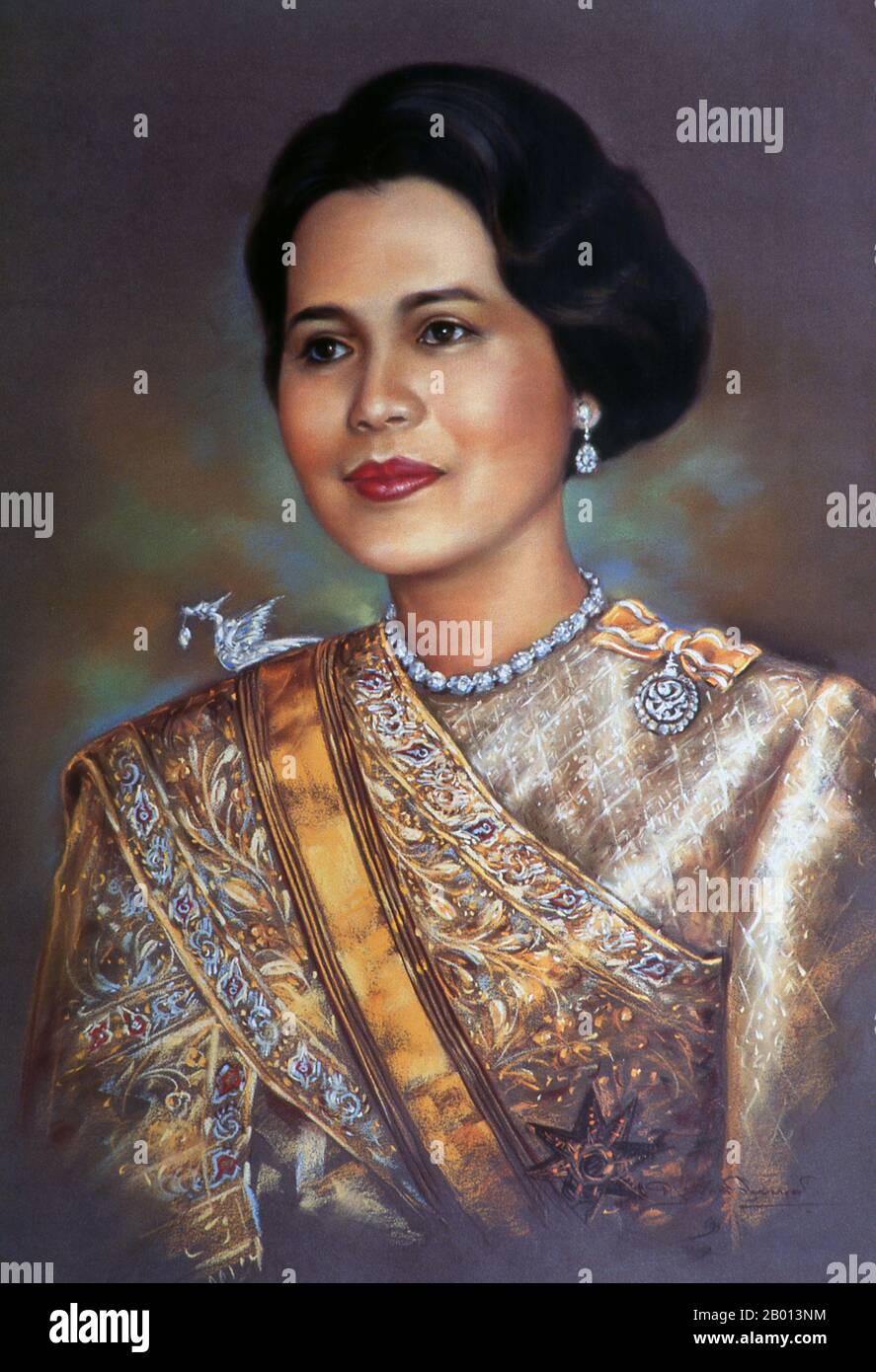 Thailand: Queen Sirikit (12th August 1932 - ), consort of Bhumibol Adulyadej (Rama IX), King of Thailand. Oil on canvas painting, c. 1950s-1960s. Somdet Phra Nang Chao Sirikit Phra Borommarachininat, born Mom Rajawongse Sirikit Kitiyakara on August 12, 1932), is the queen consort of Bhumibol Adulyadej, King (Rama IX) of Thailand. She is the second Queen Regent of Thailand (the first Queen Regent was Queen Saovabha Bongsri of Siam, later Queen Sri Patcharindra, the queen mother). She suffered a stroke on 21 July 2012, and has not been seen in public since. Stock Photohttps://www.alamy.com/image-license-details/?v=1https://www.alamy.com/thailand-queen-sirikit-12th-august-1932-consort-of-bhumibol-adulyadej-rama-ix-king-of-thailand-oil-on-canvas-painting-c-1950s-1960s-somdet-phra-nang-chao-sirikit-phra-borommarachininat-born-mom-rajawongse-sirikit-kitiyakara-on-august-12-1932-is-the-queen-consort-of-bhumibol-adulyadej-king-rama-ix-of-thailand-she-is-the-second-queen-regent-of-thailand-the-first-queen-regent-was-queen-saovabha-bongsri-of-siam-later-queen-sri-patcharindra-the-queen-mother-she-suffered-a-stroke-on-21-july-2012-and-has-not-been-seen-in-public-since-image344232272.html
Thailand: Queen Sirikit (12th August 1932 - ), consort of Bhumibol Adulyadej (Rama IX), King of Thailand. Oil on canvas painting, c. 1950s-1960s. Somdet Phra Nang Chao Sirikit Phra Borommarachininat, born Mom Rajawongse Sirikit Kitiyakara on August 12, 1932), is the queen consort of Bhumibol Adulyadej, King (Rama IX) of Thailand. She is the second Queen Regent of Thailand (the first Queen Regent was Queen Saovabha Bongsri of Siam, later Queen Sri Patcharindra, the queen mother). She suffered a stroke on 21 July 2012, and has not been seen in public since. Stock Photohttps://www.alamy.com/image-license-details/?v=1https://www.alamy.com/thailand-queen-sirikit-12th-august-1932-consort-of-bhumibol-adulyadej-rama-ix-king-of-thailand-oil-on-canvas-painting-c-1950s-1960s-somdet-phra-nang-chao-sirikit-phra-borommarachininat-born-mom-rajawongse-sirikit-kitiyakara-on-august-12-1932-is-the-queen-consort-of-bhumibol-adulyadej-king-rama-ix-of-thailand-she-is-the-second-queen-regent-of-thailand-the-first-queen-regent-was-queen-saovabha-bongsri-of-siam-later-queen-sri-patcharindra-the-queen-mother-she-suffered-a-stroke-on-21-july-2012-and-has-not-been-seen-in-public-since-image344232272.htmlRM2B013NM–Thailand: Queen Sirikit (12th August 1932 - ), consort of Bhumibol Adulyadej (Rama IX), King of Thailand. Oil on canvas painting, c. 1950s-1960s. Somdet Phra Nang Chao Sirikit Phra Borommarachininat, born Mom Rajawongse Sirikit Kitiyakara on August 12, 1932), is the queen consort of Bhumibol Adulyadej, King (Rama IX) of Thailand. She is the second Queen Regent of Thailand (the first Queen Regent was Queen Saovabha Bongsri of Siam, later Queen Sri Patcharindra, the queen mother). She suffered a stroke on 21 July 2012, and has not been seen in public since.
 Old Bangkok July-2000 (Slides Conversions) The Ayutthaya historical park covers the ruins of the old city of Ayutthaya,Thailand Stock Photohttps://www.alamy.com/image-license-details/?v=1https://www.alamy.com/stock-photo-old-bangkok-july-2000-slides-conversions-the-ayutthaya-historical-50974361.html
Old Bangkok July-2000 (Slides Conversions) The Ayutthaya historical park covers the ruins of the old city of Ayutthaya,Thailand Stock Photohttps://www.alamy.com/image-license-details/?v=1https://www.alamy.com/stock-photo-old-bangkok-july-2000-slides-conversions-the-ayutthaya-historical-50974361.htmlRMCXX28W–Old Bangkok July-2000 (Slides Conversions) The Ayutthaya historical park covers the ruins of the old city of Ayutthaya,Thailand
 Thailand: Queen Sirikit (12th August 1932 - ), consort of Bhumibol Adulyadej (Rama IX), King of Thailand. Oil on canvas painting, c. 1950s-1960s. Somdet Phra Nang Chao Sirikit Phra Borommarachininat, born Mom Rajawongse Sirikit Kitiyakara on August 12, 1932), is the queen consort of Bhumibol Adulyadej, King (Rama IX) of Thailand. She is the second Queen Regent of Thailand (the first Queen Regent was Queen Saovabha Bongsri of Siam, later Queen Sri Patcharindra, the queen mother). She suffered a stroke on 21 July 2012, and has not been seen in public since. Stock Photohttps://www.alamy.com/image-license-details/?v=1https://www.alamy.com/thailand-queen-sirikit-12th-august-1932-consort-of-bhumibol-adulyadej-rama-ix-king-of-thailand-oil-on-canvas-painting-c-1950s-1960s-somdet-phra-nang-chao-sirikit-phra-borommarachininat-born-mom-rajawongse-sirikit-kitiyakara-on-august-12-1932-is-the-queen-consort-of-bhumibol-adulyadej-king-rama-ix-of-thailand-she-is-the-second-queen-regent-of-thailand-the-first-queen-regent-was-queen-saovabha-bongsri-of-siam-later-queen-sri-patcharindra-the-queen-mother-she-suffered-a-stroke-on-21-july-2012-and-has-not-been-seen-in-public-since-image344232271.html
Thailand: Queen Sirikit (12th August 1932 - ), consort of Bhumibol Adulyadej (Rama IX), King of Thailand. Oil on canvas painting, c. 1950s-1960s. Somdet Phra Nang Chao Sirikit Phra Borommarachininat, born Mom Rajawongse Sirikit Kitiyakara on August 12, 1932), is the queen consort of Bhumibol Adulyadej, King (Rama IX) of Thailand. She is the second Queen Regent of Thailand (the first Queen Regent was Queen Saovabha Bongsri of Siam, later Queen Sri Patcharindra, the queen mother). She suffered a stroke on 21 July 2012, and has not been seen in public since. Stock Photohttps://www.alamy.com/image-license-details/?v=1https://www.alamy.com/thailand-queen-sirikit-12th-august-1932-consort-of-bhumibol-adulyadej-rama-ix-king-of-thailand-oil-on-canvas-painting-c-1950s-1960s-somdet-phra-nang-chao-sirikit-phra-borommarachininat-born-mom-rajawongse-sirikit-kitiyakara-on-august-12-1932-is-the-queen-consort-of-bhumibol-adulyadej-king-rama-ix-of-thailand-she-is-the-second-queen-regent-of-thailand-the-first-queen-regent-was-queen-saovabha-bongsri-of-siam-later-queen-sri-patcharindra-the-queen-mother-she-suffered-a-stroke-on-21-july-2012-and-has-not-been-seen-in-public-since-image344232271.htmlRM2B013NK–Thailand: Queen Sirikit (12th August 1932 - ), consort of Bhumibol Adulyadej (Rama IX), King of Thailand. Oil on canvas painting, c. 1950s-1960s. Somdet Phra Nang Chao Sirikit Phra Borommarachininat, born Mom Rajawongse Sirikit Kitiyakara on August 12, 1932), is the queen consort of Bhumibol Adulyadej, King (Rama IX) of Thailand. She is the second Queen Regent of Thailand (the first Queen Regent was Queen Saovabha Bongsri of Siam, later Queen Sri Patcharindra, the queen mother). She suffered a stroke on 21 July 2012, and has not been seen in public since.